- THE PRINCESS PASSPORT
- Email Newsletter
- Yacht Walkthroughs
- Destinations
- Electronics
- Best Marine Electronics & Technology
- Boating Safety

- Uncategorized

Diesel Electric Drive
- By Chuck Husick
- Updated: October 4, 2007
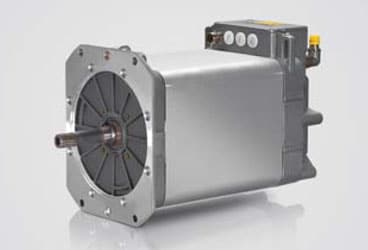
Siemens EcoProp
Your next yacht may be powered with a new, but at the same time old and extensively proven, power system-a diesel electric drive. First used in 1903 to propel the triple-screw Russian tanker Vandal on the Volga River and Caspian Sea, diesel electric propulsion is now used in the most modern cruise ships and in thousands of other commercial vessels. Although the idea of powering your yacht with the indirect, two-step diesel electric energy transfer system may appear to be unnecessarily complex, its many advantages can make it a compellingly attractive alternative to a conventional direct mechanical prop-shaft drive.
The benefits of diesel electric drive begin with the design freedom the system affords the yacht’s designer. The engine can be installed wherever appropriate to achieve optimum use of space for the accommodation. Noise and vibration are more easily suppressed than in a conventional direct engine-to-propeller drive. Turning the props with electric motors enhances slow-speed maneuverability by providing unrestricted minimum prop speeds with 100 percent torque available to provide immediate power response at all times. Prop synchronization is automatic and extremely precise. When under way all of the electrical power required by the vessel can be supplied from the diesel electric propulsion system, eliminating the need to run a genset. A diesel electric power system can drive multiple propellers from a single engine or use multiple engines to power one or more props. In a twin-engine/twin-prop system, one engine can power both props when operating within the speed limits imposed in many areas. Electrical power from the vessel’s genset can be used to propel the boat, providing a built-in backup-especially valuable for yachts with single-engine installations. Conversely, the propulsion system can serve as a backup for the yacht’s gensets.
The more than 100-year history of marine diesel electric systems began as a response to the impossibility of quickly reversing the direction of rotation of early direct-to-prop-shaft-coupled diesel engines. With a diesel-powered direct current (DC) generator and a DC motor connected to the prop shaft, the direction of prop rotation could be controlled by a switch. The 100 percent torque, zero-speed capability of the electric motor led to the overwhelming use of diesel electric power for railroad locomotives. Diesel electric drives found a natural application in submarines and many surface ships. Today’s cruise ships, where 70-80 percent of the total onboard power is required for the “hotel” side of the vessel, are diesel electric powered. The power demands can be enormous at times. A trivial example: 1,500,000 watts, equal to more than 1,400 hp, is needed to simultaneously power half of the 1,500-watt hair dryers on a 1,400-stateroom cruise ship.
While the equipment designed to serve the massive needs of cruise ships is unsuitable for any reasonable-sized yacht, numerous land-mobile applications including buses, very large trucks and the cranes used in container ports need power levels similar to those required by a yacht. These land-mobile applications require high overall efficiency, installation flexibility, virtually 100 percent torque at close to zero speed and must meet demanding reliability and durability standards. Fortunately, equipment designed and perfected for these uses is ideal for propelling many types of yachts.
From the helmsman’s standpoint the Siemens diesel electric propulsion system is totally transparent, functioning identically to a conventional power control system, with some welcome and useful advantages. In a twin-prop installation, two conventional-appearing single-lever electronic power controls send commands to the drive control system computer (DICO in Siemens’ terms). Digital messages from the DICO manage the diesel engine’s speed governor and control the current flow from the propulsion converters to the prop-drive motors. The power curve of the engine is programmed into the control computer and used to set engine rpm to the speed that provides the required power with optimum fuel efficiency. It is generally unnecessary for the helmsman to monitor engine rpm. Placing a prop control in neutral allows the prop to freewheel, with no risk of damaging the gearbox, a benefit when the vessel is propelled by the other prop. There are no restrictions on rapid movement of the control from ahead to astern. Moving both controls beyond a preselected prop shaft speed, usually about 400 rpm, will automatically and very precisely synchronize the propellers. In fact, the precision with which the system “knows” the relative rotational position of each prop shaft appears to be sufficient to allow future addition of a prop-phase relationship control. Vibration and noise can be minimized with careful control of the relative position of the blades on one prop with those on the other prop. This technique is common on many multiengine aircraft and is called prop phasing.
In a diesel electric system, the engine can be mounted virtually anywhere in the hull and in whatever orientation is required to achieve optimum use of space. With no need to provide a mechanical power-transfer connection to the hull, the engine mounts can be chosen for optimum vibration isolation. If desired, the engine can be totally enclosed in a sound shield, providing superior sound attenuation without the need to insulate an entire compartment. The incorporation of thrust bearings on the prop shafts ensures precise alignment with the “P” bracket and the prop-drive gearbox, reducing wear on the cutlass bearing and shaft noise. The small size of the prop-drive motor and gearbox also makes it possible to locate the props at the most advantageous position on the hull-a great advantage.
A typical Siemens single-engine twin-prop diesel electric propulsion system is comprised of a permanent magnet three-phase alternator powered by the diesel engine through a speed-increasing gearbox, two short-circuit-proof solid state power inverter modules, two 3-phase permanent magnet prop-drive motors, associated prop-drive gearboxes, a control computer and a conventional-appearing helm control station. System components are surprisingly compact and lightweight. The 145 kW (194 hp) alternator suitable to power a 48-foot trawler yacht is 10 inches square, 22 inches long and weighs 264 pounds. Each of the 114 hp drive motors is similar in size and weight. The 40 x 23 x 7 inch inverter modules are typically bulkhead mounted. The spiral bevel gearboxes used to connect the alternator to the driving engine and the drive motors to the propellers are 98 percent efficient and have a medium duty life expectancy of 25,000 hours. Gearbox power capacities range from 150 to 600 hp, meaning that they can be coupled to multiple alternators or motors to meet the power requirements of larger vessels. All of the system’s power-handling components, alternators, motors, gearboxes and power inverters are cooled with a circulating flow of water/glycol. The system is also continuously monitored, by using temperature sensors built into the alternators, motors, gearboxes and inverters.
Operating efficiency is an important part of the evaluation of any power delivery system. Although the alternators, inverters, motors and gearboxes used in the Siemens system operate efficiently, the total energy loss through the system will typically exceed the losses imposed by a conventional marine gear-coupled drive. However, the efficiency loss is to a large degree offset by the ability of the electronic control to precisely match the engine’s power curve to the vessel’s propellers. In a conventional direct mechanical prop-drive system, the fixed pitch propeller can be matched to the engine and the hull at only one point, maximum engine rpm. At all other engine speeds the engine turns faster than is necessary to produce the required power. The diesel electric drive matches the prop load to the engine, producing a result similar to that achieved with use of a controllable pitch prop. Using one large engine to power two propellers can provide an efficiency advantage compared with use of two engines providing the same total power. Depending on the positioning of the engine, power loss due to exhaust backpressure may be less than what can be achieved in a conventional installation. The option of drawing the vessel’s AC house power from the propulsion system when under way, eliminating the need to run the vessel’s genset, can improve fuel efficiency. Overall, the fuel economy of the diesel electric drive will be close to or as good as what can be achieved using a direct-drive system.
In many installations the cost of a single-engine twin-prop diesel electric power system will be no more than a conventional twin-engine direct-mechanical drive installation. Properly integrated into the design of the vessel, the diesel electric drive’s many attributes will likely make it the preferred propulsion system for a growing number of yachtsmen.
Contact: www.sea.siemens.com/marine/ .
- More Uncategorized

BoatUS Launches Online Advocacy Tool

Dock Danger

A Dream Fulfilled

3 America’s Cup Hashtags to Follow
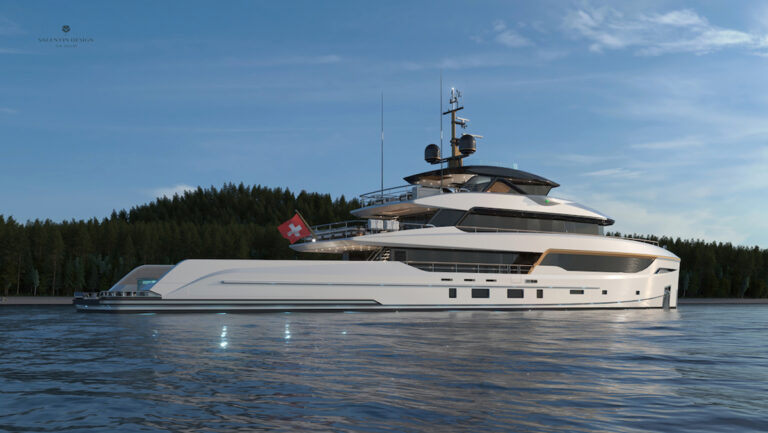
New Flagship for Bering Yachts: The B165
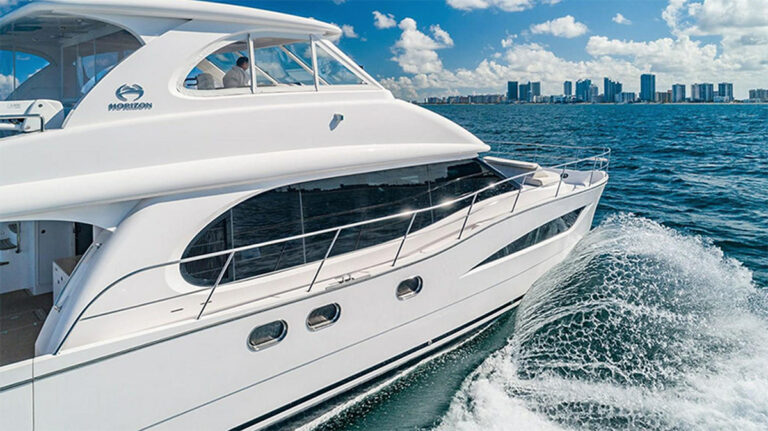
For Sale: Horizon Power Catamarans 52
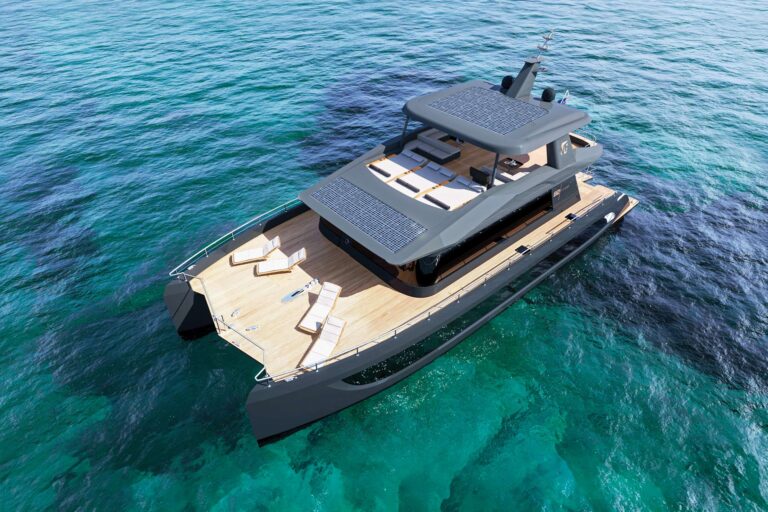
Power Catamaran Popularity Rising
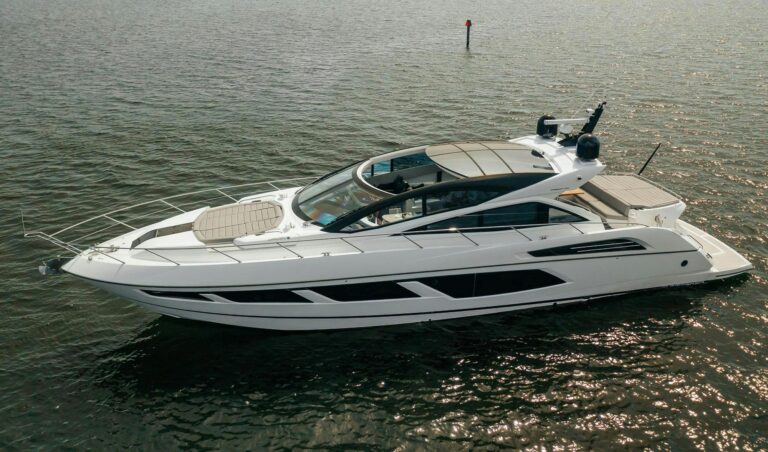
For Sale: Sunseeker Predator 68

- Digital Edition
- Customer Service
- Privacy Policy
- Email Newsletters
- Cruising World
- Sailing World
- Salt Water Sportsman
- Sport Fishing
- Wakeboarding

Propulsion Systems for Monohull
The silence of an Oceanvolt electric propulsion is a skipper's dream. Whether quietly maneuvering through a harbor or motor-sailing on low-wind days to create your own apparent wind, our electric solutions will enhance and extend your sailing enjoyment.
Oceanvolt offers Hybrid or Electric systems as a power & propulsion option in partnership with many leading monohull boat builders - adding new partners continuously. We also offer repowering solutions for converting away from legacy diesel engines – removing the diesel engine, fuel tanks and exhaust system - cleaning up greasy, smelly engine compartments and freeing up both weight and space below deck.
Oceanvolt systems are scaled and configured to achieve maximum efficiency - taking into consideration boat length, beam and displacement as well as system weight and placement within the boat. Range, beyond battery capacity, is extended through hydro generation while sailing above 6kn. This can be complemented with either a portable AC generator or a DC generator (in larger boats or for long distance cruising).
All Oceanvolt systems are engineered to operate at 48 volts for passenger safety and ease of repair. Oceanvolt systems are extremely low maintenance and do not require winterizing (no annual engine maintenance/storage costs).
system & price examples
Owner testimonials.
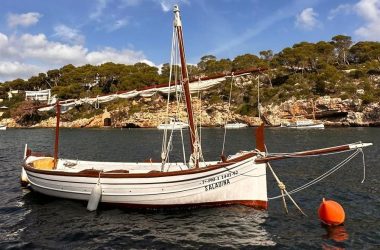
Traditional Mallorcan Llaut
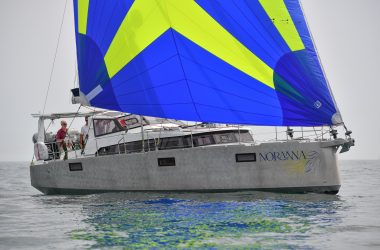
Bestevaer 36
Diesel Electric Propulsion: Is This A Safer, More Efficient Solution For Your Vessel?
- June 18, 2017
- Quite Interesting
Although the idea of powering your vessel with the indirect, two-step diesel electric energy transfer system may appear to be unnecessarily complex, its many advantages can make it a compellingly attractive alternative to a conventional direct mechanical prop-shaft drive. When under way all of the electrical power required by the vessel can be supplied from the diesel electric propulsion system, eliminating the need to run a genset.
A diesel electric power system can drive multiple propellers from a single engine or use multiple engines to power one or more propeller. In a twin-engine/twin-prop system, one engine can power both props when operating within the speed limits imposed in many areas. Electrical power from the vessel’s genset can be used to propel the boat, providing a built-in backup-especially valuable for vessels with single-engine installations.
Conversely, the propulsion system can serve as a backup for the gensets. The use of electric propulsion in certain vessel types is well-known. In marine applications, nearly all the energy is produced by diesel engines. Using an electric propulsion system, where the energy transmission is electrical and the propulsion and thruster are variable speed electrically driven, fuel consumption can be reduced significantly for many vessel types with environmental benefits.
Diesel Electric Systems have been in use to propel vessels for more than 100 years. Branobel launched the first diesel-electric ship in 1903, and since that day, diesel electric propulsion systems have evolved and today they can be found in all boat sizes and applications. But how do you know when to utilize diesel electric technology for your vessel? The investment in Diesel Electric vessels have doubled in the past 4 years, while the construction of purely mechanically propelled vessels have slowed down. But what are the reasons for this growth? Some of the benefits of the Diesel Electric systems are:
Effective design: The ability to locate your generators in any part of the vessel independent of where the power will be used;
Smaller Engine Rooms: Possibility to replace a big slow speed engine with multiple smaller generators;
Reduced Noise and Vibration: No need for long drivelines;
Flexibility: Capability to share the power of one unit with multiple devices (main propeller, bow thrusters, hotel load, pumps, etc);
Redundancy: Generators can be reassigned to cover any machine downtime;
Efficiency: Depending on the application the system can provide better fuel efficiency (mainly if there are requirements for long periods of low speed/load)
Fuel consumption savings calculation: The optimum operation point of a diesel engine will typically be around a load of 85 percent of the Max continuous rating (MCR). Moreover, the efficiency level drops quickly as the load becomes lower than 50 percent of MCR. With the help of the electric system, the mechanical propulsion prime mover is replaced by diesel-electric prime movers that will automatically start and stop as load demand varies. In comparison to a conventional vessel with mechanical propulsion, this enhances the efficiency of the energy usage and reduces the fuel consumption by keeping the average loading of each running diesel engine close to its optimum load point.
However, in some vessel applications, the load variations can be large and rapid. It is impossible to make the generators switch on and off every five seconds as would be the case with DP vessels. By using super-capacitors to supply the load variations, and hence let the diesel engines provide the average load, the peak power of the power plant will be reduced, allowing the average loading of the engines to increase to a more optimal point with lower specific fuel oil consumption. The savings in fuel consumption will depend on many parameters such as actual variations in the load, the average load and the number of prime movers.
In many installations the cost of a single-engine twin-prop diesel electric power system will be no more than a conventional twin-engine direct-mechanical drive installation. Properly integrated into the design of the vessel, the diesel electric drive’s many attributes will likely make it the preferred propulsion system for vessel owners and operators now and in the future.
Related Posts
A compass is a device that indicates direction. It is one of the most important…
Ever wondered why the terms “Port” and “Starboard” are used to denote Left and Right…
Two types of propellers are commonly found in merchant vessels: Fixed Pitch Propeller (FPP) and…
- previous post: Controllable Pitch Propeller
- next post: Why Is It Called Port And Starboard?
- BOAT OF THE YEAR
- Newsletters
- Sailboat Reviews
- Boating Safety
- Sailing Totem
- Charter Resources
- Destinations
- Galley Recipes
- Living Aboard
- Sails and Rigging
- Maintenance
- Best Marine Electronics & Technology

The Promises and Pitfalls of an All-Electric Yacht
- By Tim Murphy
- Updated: November 8, 2021
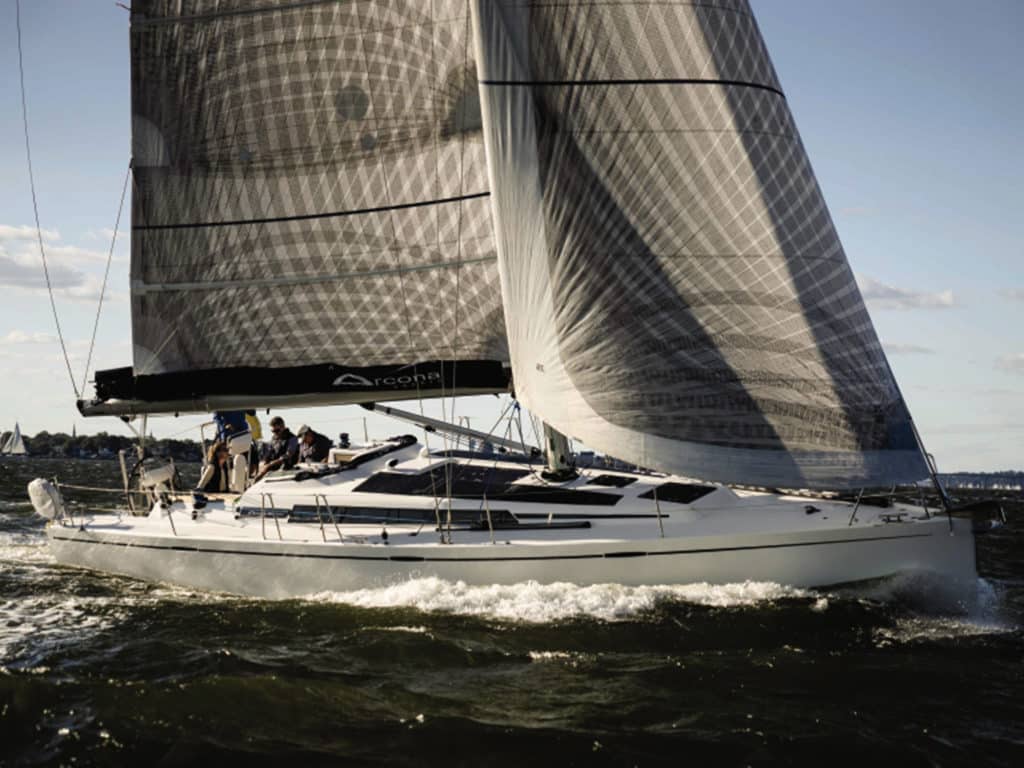
This past October, I saw one of the most interesting exhibits in more than 500 new cruising sailboats I’ve reviewed over two decades. It was the Arcona 435Z, built in Sweden and introduced by Graham Balch of Green Yachts in San Francisco. Balch describes his business as “a new brokerage dedicated to the electric revolution on the water,” and it was the “Z” in the boat’s name, which stands for “zero emissions,” that made this boat so interesting. This was the first electric propulsion system—not hybrid but all-electric —I’d ever seen on a cruising sailboat.
Electric propulsion isn’t new. Since 1879, electric motors have propelled boats; a fleet of some four-dozen electric launches transported visitors around the 1893 Colombian Exposition in Chicago. But cruising sailboats are not launches, and the open sea is not a protected canal. When we’re using cruising boats as they’re meant to be used, they seldom end their day plugged into a shore-power outlet. Cruising boats comprise many devices —stove, refrigerator, freezer, windlass, winches, autopilot, radar, lights—whose power typically comes from a tank of fossil fuel. And today’s cruising sailors are accustomed to using diesel auxiliary power to motor through lulls or punch into headwinds and seas.
Starting about 15 years ago, we saw a wave of diesel-electric and hybrid propulsion systems on production and custom cruising boats ( see “Perpetuated Motion,” CW , March 2005 ). Both of those systems ultimately start with an onboard internal-combustion engine. A diesel-electric propulsion system relies on a running genset to directly power the electric motor that turns the propeller. A hybrid system relies on batteries to power the electric motor, plus an internal-combustion genset to recharge the batteries. One of the promises of a hybrid system is the ability to regenerate electrical power. Regeneration means using boatspeed under sail to turn the propeller, whose spinning shaft sends electrons from the electric motor back through an electronic controller to recharge the batteries. In such a system, the boat’s propeller is both an electrical load (when running under power) and a charging source (when sailing in regeneration mode).
The Arcona 435Z was different from both of these systems: It incorporates no onboard fossil-fuel engine at all. Instead, it has a bank of lithium batteries, several solar panels, and a proprietary propulsion leg that looks like a saildrive. “This boat,” Balch said, “has the very first production unit in the world of Oceanvolt’s newest electric propulsion system, called the ServoProp.”
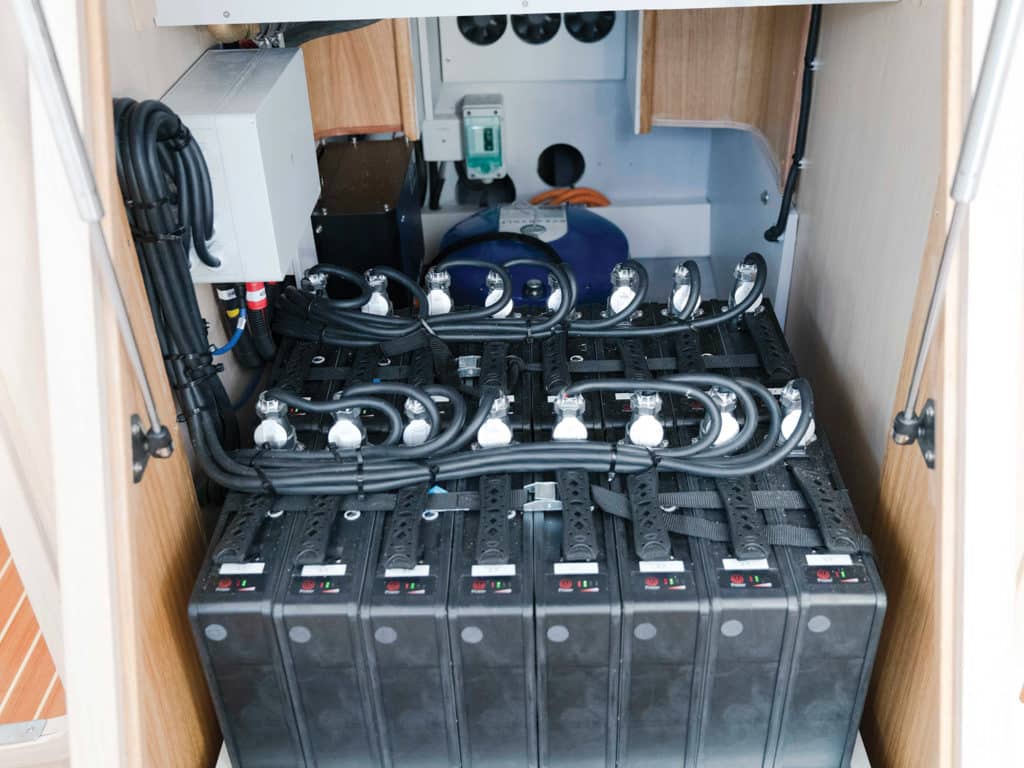
For our sea trial, Balch was joined by Derek Rupe, CEO of Oceanvolt USA. “If you can sail the boat and you have some solar, you can go anywhere in the world, and you can make all your power underway while you go,” Rupe said. When we spoke in October 2020, he touted three high-profile sailors who were using the Oceanvolt electric propulsion system: Alex Thomson, for his Hugo Boss Open 60 Vendée Globe program; Jimmy Cornell, for his Elcano 500 expedition; and Riley Whitelum and Elayna Carausu, who had been teasing their new boat for months on their popular Sailing La Vagabonde YouTube channel.
The efficiency of Oceanvolt’s ServoProp and the regeneration from it is the promised game-changer in each of these boats. The ServoProp is a leg with a feathering propeller that can be set for optimal pitch in three modes: forward, reverse and regeneration.
“You don’t need fuel,” Rupe said. “You don’t need to dock; you can go anywhere you want to go and always have the power for living and propulsion.”
That’s the promise. But are there also pitfalls?
Innovation and Risk
Marine electric propulsion is an emerging technology. Compared with the mature and settled technology of diesel engines and lead-acid batteries, electric-propulsion systems—with their electronic controllers and lithium batteries—are in a stage of development best described as adolescent. Every sailor has his or her own tolerance for technical innovation. For the promise of fewer seconds per mile, grand-prix-racing sailors willingly trade a high risk of expensive damage to the sails, rig or the boat’s structure itself; cruising sailors, by contrast, tend to favor yearslong reliability in their equipment as they seek miles per day.
Folks who identify as early adopters take special joy in the first-wave discoveries of a new technology; if they’re clear-eyed about supporting an ongoing experiment, they see themselves as partners with the developers, accepting failures as opportunities for learning. Sailors motivated primarily by changing the trajectory of climate change might be especially willing to modify their behavior to limit their own output of greenhouse gases. Investing in any emerging technology asks you to start with a clear assessment of your own risk tolerance. We’ll return to this theme with one or two real-life examples.
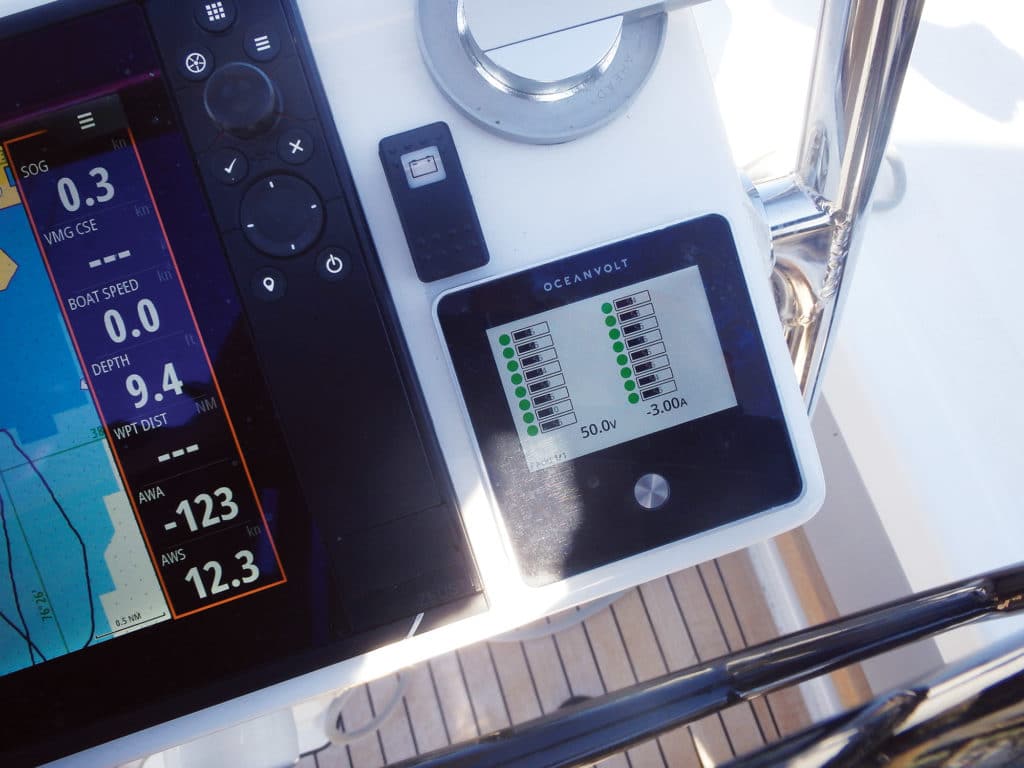
The American Boat and Yacht Council, founded in 1954, sets recommended standards for systems installed on recreational boats. For decades, ABYC has published standards related to installations of diesel and gasoline engines, as well as electrical systems based around lead-acid batteries. By contrast, it was only three years ago that ABYC came out with its first electric-propulsion standard (revised July 2021). And only last year it published its first technical-information report on lithium batteries (a technical-information report is an early step toward a future standard). The takeaway is that if you need help servicing your diesel engine or electrical system built around lead-acid batteries, you can pull into any reasonable-size port and find competent technicians to help you. With electric propulsion and lithium batteries, that pool of skilled talent is significantly scarcer.
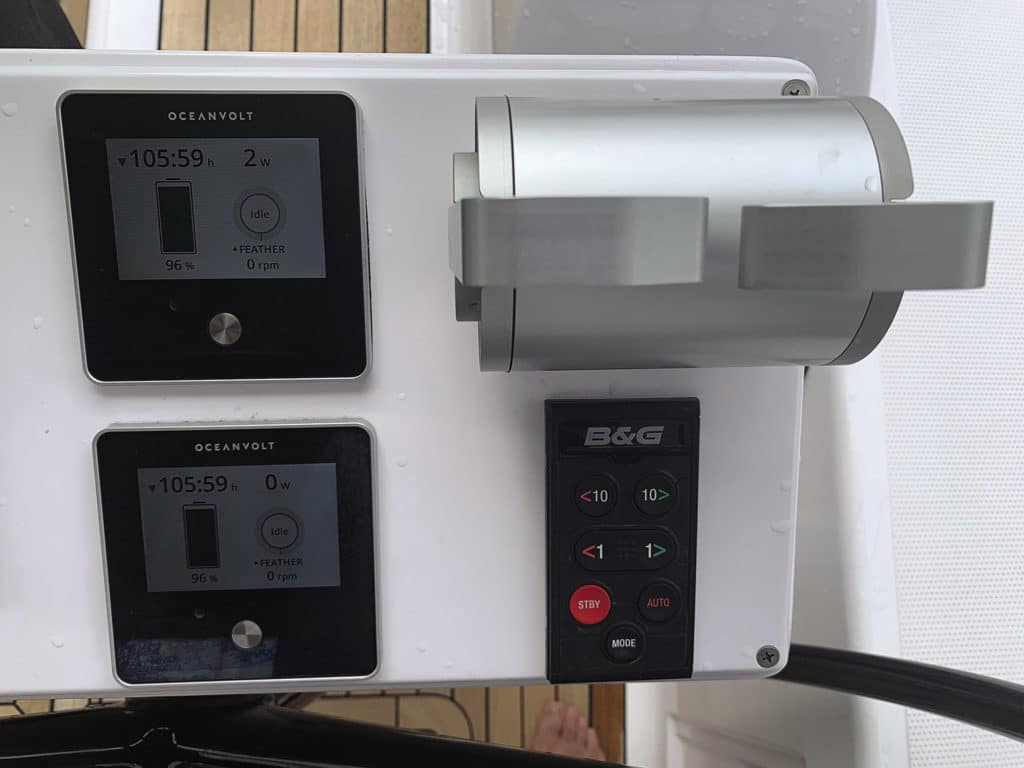
To say that a technology is mature simply means that we’ve learned to live with it, warts and all, but that it holds few remaining surprises. Certainly, diesel-propulsion and lead-acid-battery technologies each leave plenty of room for improvement. When a charge of fuel ignites in the combustion chamber of a diesel engine, some three-quarters of the energy is lost in heat and the mechanical inefficiencies of converting reciprocating motion to rotation. Lead-acid batteries become damaged if we routinely discharge more than half of their capacity. During charging, they’re slow to take the electrons we could deliver.
Lithium batteries are comparatively full of promise. Their power density is far greater than that of lead-acid batteries, meaning they’re much lighter for a given capacity. They’re capable of being deeply discharged, which means you can use far more of the bank’s capacity, not merely the first half. And they accept a charge much more quickly; compare that to several hours a day running an engine to keep the beers iced down.
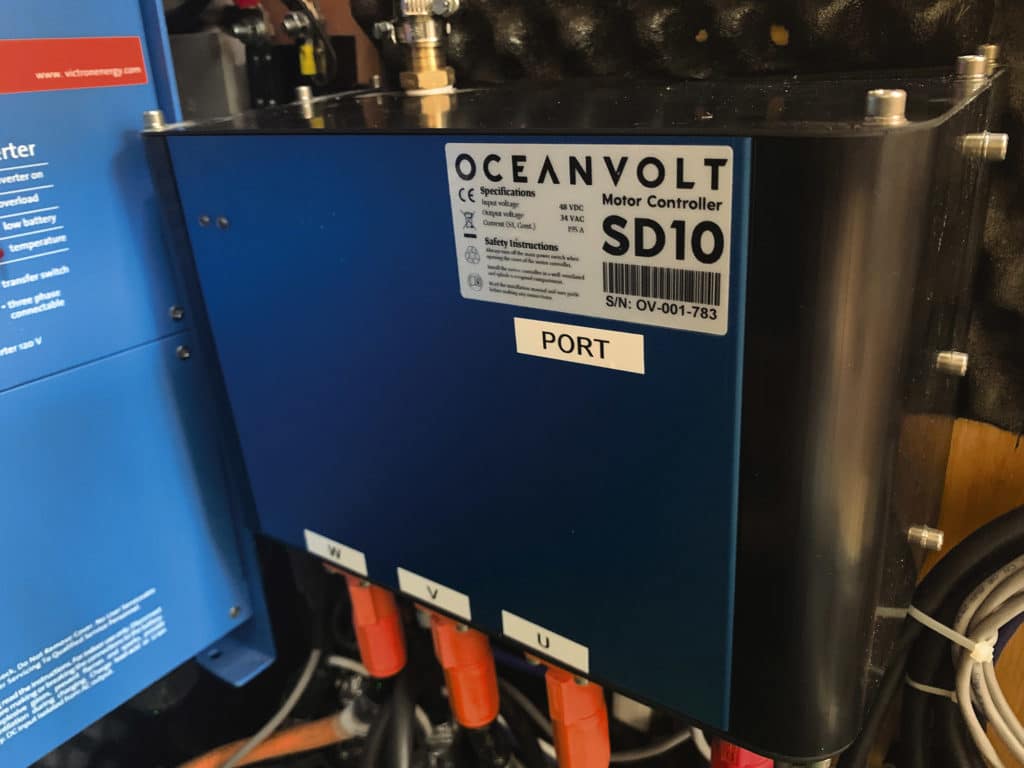
But the pitfalls? Let’s start with ABYC TE-13, Lithium Ion Batteries. Some of its language is bracing. “Lithium ion batteries are unlike lead-acid batteries in two important respects,” the report says. “1) The electrolyte within most lithium ion batteries is flammable. 2) Under certain fault conditions, lithium ion batteries can enter a condition known as thermal runaway, which results in rapid internal heating. Once initiated, it is a self-perpetuating and exothermic reaction that can be difficult to halt.”
Thermal runaway? Difficult to halt? Self-perpetuating?
“Typically, the best approach is to remove heat as fast as possible, which is most effectively done by flooding the battery with water,” TE-13 continues, “although this may have serious consequences for the boat’s electrical systems, machinery, buoyancy, etc.”
If you were following the news in January 2013, you might remember the story of Japan Airlines Flight 008. Shortly after landing at Boston’s Logan Airport, a mechanic opened the aft electronic equipment bay of the Boeing 787-8 to find smoke and flames billowing from the auxiliary-power unit. The fire extinguisher he used didn’t put out the flames. Eventually Boston firefighters put out the fire with Halotron, but when removing the still-hissing batteries from the plane, one of the firefighters was burned through his professional protective gear.
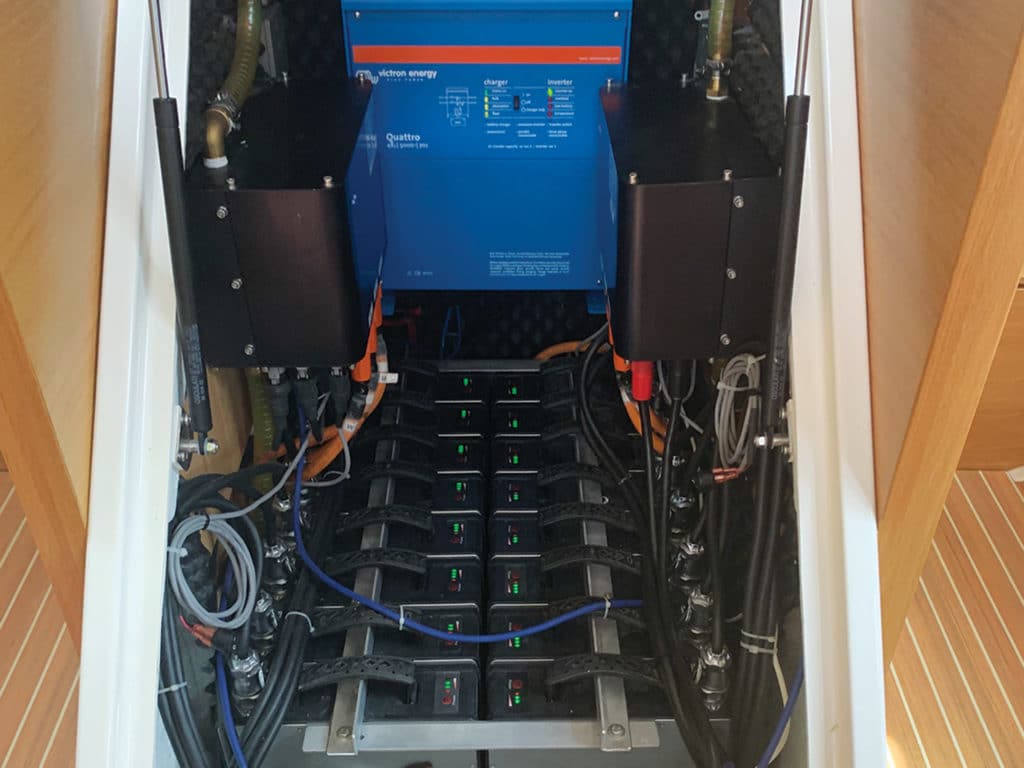
Samsung Galaxy cellphones, MacBook Pro laptops, powered skateboards—in the past decade, these and other devices have been recalled after their lithium batteries burned up. In that period, several high-end custom boats were declared a total loss following failures from lithium batteries. In March 2021, a 78-foot Norwegian hybrid-powered tour boat, built in 2019 with a 790 kW capacity battery bank, experienced thermal runaway that kept firefighters on watch for several days after the crew safely abandoned the ship.
Yes, experts are learning a lot about how to mitigate the risks around lithium batteries. But we’re still on the learning curve.
ABYC’s TE-13 “System Design” section starts, “All lithium-ion battery systems should have a battery management system (BMS) installed to prevent damage to the battery and provide for battery shutoff if potentially dangerous conditions exist.” It defines a bank’s “safe operating envelope” according to such parameters as high- and low-voltage limits, charging and discharging temperature limits, and charging and discharging current limits.
Graham Balch takes these safety recommendations a step further: “To our knowledge, the BMS has to monitor at the cell level. With most batteries, the BMS monitors at the module level.” The difference? “Let’s say you have 24 cells inside the battery module, and three of them stop working. Well, the other 21 have to work harder to compensate for those three. And that’s where thermal events occur.”
Balch followed the story of the Norwegian tour boat this past spring. He believes that the battery installation in that case didn’t meet waterproofing standards: “The hypothesis is that due to water intrusion, there was reverse polarity in one or more of the cells, which is worse than cells simply not working. It means that they’re actively working against the other cells. But if the BMS is monitoring only at the module level, you wouldn’t know it.”
On the Green Yachts website, Graham lists five battery manufacturers whose BMS regimes monitor at the cell level. “If I were sailing on an electric boat, whether it be commercial or recreational, I would feel comfortable with having batteries from these five companies and no other,” he said.
The broader takeaway for today’s sailors is that lithium batteries bring their own sets of problems and solutions, which are different from those of conventional propulsion and power-supply technologies. A reasonably skilled sailor could be expected to change fuel filters or bleed a diesel engine if it shuts down in rough conditions. With lithium-ion batteries aboard, an operator needs to understand the causes and remedies of thermal runaway, and be ready to respond if the BMS shuts down the boat’s power.
Real-World Electric Cruising Boats
When we met Oceanvolt’s Derek Rupe a year ago, he and his wife had taken their all-electric boat to the Bahamas and back the previous season. Before that, he’d been installing electric-propulsion packages for six years on new Alerion 41s and other refit projects. “My real passion is on the technical side of things—installations, really getting that right. That’s half the picture. The technology is there, but it needs to be installed correctly.”
When talking to Rupe, I immediately encountered my first learning curve. I posed questions about the Oceanvolt system in amps and amp-hours; he responded in watts and kilowatt-hours. This was yet another example of the different mindset sailors of electric boats need to hold. Why? Because most cruising boats have just one or two electrical systems: DC and AC. The AC system might operate at 110 or 220 volts; the DC side might operate at 12 or 24 volts. On your own boat, that voltage is a given. From there we tend to think in terms of amps needed to power a load, and amp-hours of capacity in our battery banks. Going back to basics, the power formula tells us that power (watts) equals electrical potential (volts) times current (amps). If your boat’s electrical system is 12 volts and you know that your windlass is rated at 400 watts, it follows that the windlass is rated to draw 33 amps.
But an all-electric boat might comprise several systems at different voltages. A single battery bank might supply cabin lights at 12 volts DC; winches and windlasses at 24 volts DC; the propulsion motor at 48 volts DC; and an induction stove, microwave and television at 110 volts AC. A DC-to-DC power converter steps the voltage up or down, and an inverter changes DC to AC. Instead of translating through all those systems, the Oceanvolt monitor (and Derek Rupe) simply reports in watts coming in or going out of the bank.
“We keep all our thoughts in watts,” Rupe said. “Watts count in the AC induction. They count in the DC-to-DC converter. They count the solar in. They count the hydrogeneration in. And the power-management systems tracks it that way for shore-power in.
“On a boat like this, maybe I have 500 watts coming in the solar panels,” he continued. “So then I can think: ‘Well, my fridge is using 90 watts. My boat has an electric stove. When I cook a big meal, I can see that for every hour we cook, we lose about 10 to 12 minutes of our cruising range.’”
During his Bahamas cruising season, Rupe observed that on days that they were sailing, the combination of solar panels and hydroregeneration supplied all the power he and his wife needed. “When we weren’t sailing,” he said, “we found that we were losing 8 percent each day, in the difference from what the sun gave us to what we were using for the fridge, lights, charging our laptops, and all that stuff.”
Rupe’s solution? “Twice in Eleuthera and once outside Major’s, we went out and sailed laps for a couple of hours because the batteries were below 30 percent of capacity. It was good sailing, and the wind was coming over the shore, so we didn’t have any sea state. We did a couple of hot laps on nice beam reaches, and generated about 700 watts an hour.”
Of the three sailors Rupe touted in October 2020—Alex Thomson, Jimmy Cornell and the Sailing La Vagabonde couple—only Cornell can report back on his all-electric experiences with Oceanvolt. Alex Thomson ended his circumnavigation abruptly last November, just 20 days after the Vendée Globe start, when Hugo Boss collided with an object in the South Atlantic. And at press time in early fall 2021, Riley and Elayna had just recently announced the build of their new Rapido trimaran; keep an eye on their YouTube channel for more about their experiences with the Oceanvolt propulsion system.
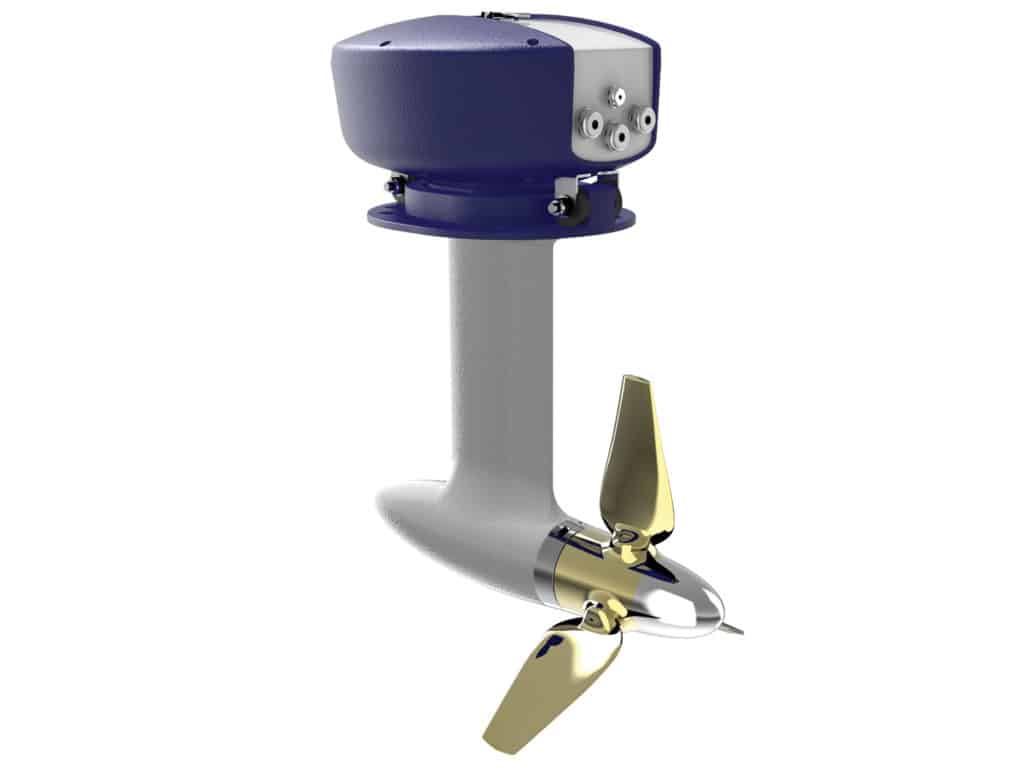
As for Cornell—circumnavigator, World Cruising Routes author, creator of the transoceanic rally, and veteran of some 200,000 ocean miles—he suspended his planned Elcano 500 round-the-world expedition solely because of the Oceanvolt system in his new Outremer catamaran. His Aventura Zero Logs on the Cornell Sailing website, particularly the Electric Shock article posted on December 2, 2020, are essential reading for any sailor interested in sailing an electric boat. “Sailing around the world on an electric boat with zero emissions along the route of the first circumnavigation was such a tempting opportunity to do something meaningful and in tune with our concern for protecting the environment that my family agreed I should do it,” Cornell wrote. “What this passage has shown was that in spite of all our efforts to save energy, we were unable to regenerate sufficient electricity to cover consumption and top up the batteries.”
Cornell’s experience in that article is raw, and his tone in that moment bitterly disappointed. We recommend it as essential reading—not as a final rejection of the electric-boat concept or of Oceanvolt’s system, or even as an endorsement of Cornell’s own decision that the system didn’t work. I suspect that I may have arrived at the same conclusion. Yet given the same boat in the same conditions, one imagines that a new breed of sailor—a Graham Balch or a Derek Rupe—may have responded differently to the constraints imposed by an all-electric boat, as nearly every cruising sailor today habitually responds to the inconvenient constraints of diesel engines and lead-acid batteries.
“If you bring electric winches, electric heads and an induction stove, and then sail into a high-pressure system, you’ll set yourself up for failure,” Balch said. “You have to balance your power inputs and your power outputs.
“Sailing an electric boat is a return to the tradition of sailing that the crutch of a diesel engine has gotten us away from,” he added. “Magellan’s fleet got all the way around the world, and they didn’t have a diesel engine.”
Tim Murphy is a Cruising World editor-at-large and longtime Boat of the Year judge.
- More: Green Wakes , Hands-On Sailor , navigation , print nov 2021 , sailboat review , Sailboat Reviews
- More Sailboats
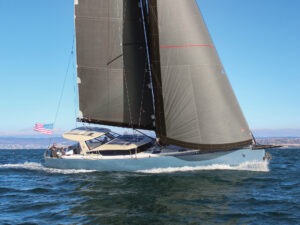
New to the Fleet: Pegasus Yachts 50

Balance 442 “Lasai” Set to Debut

Sailboat Review: Tartan 455

Meet the Bali 5.8
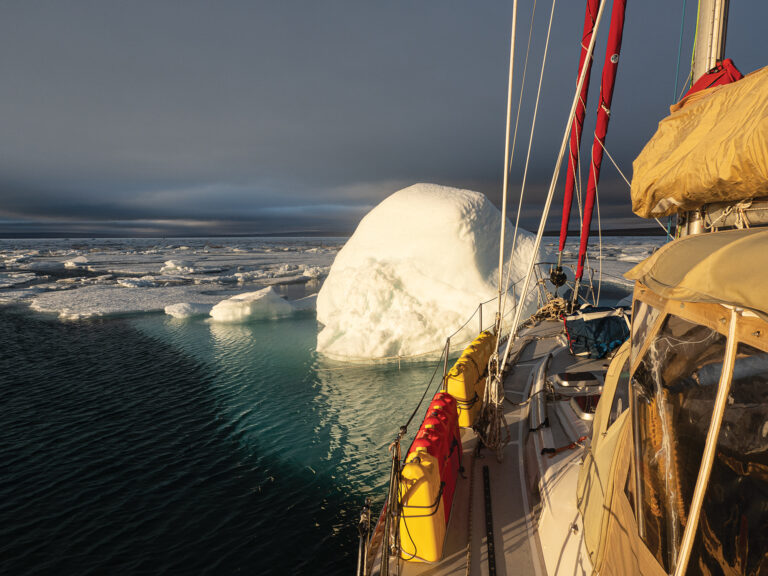
Cruising the Northwest Passage

A Legendary Sail

10 Best Sailing Movies of All Time
- Digital Edition
- Customer Service
- Privacy Policy
- Email Newsletters
- Cruising World
- Sailing World
- Salt Water Sportsman
- Sport Fishing
- Wakeboarding
- Nautic Shows
- America’s Cup
- Classic Yachts
- Motor Yachts
- Sailing Yachts
- Superyachts
- Yachts News
- Destinations
- Yacht Clubs
- Boat Racing
- Meta Yachts

Over 100 years after the first (successful) diesel-electric yacht, Southern Wind explain how hybrid marine power is taking a big step forward in a size range that allows better use of industrial developments in other sectors.
What will the next superyacht launched by Southern Wind Shipyard have in common with more than 400 New York City buses? Absolutely nothing, until you look in the engine room where you’ll find the same diesel-electric power and propulsion technology from BAE Systems. The SW96#04 , due for delivery next summer, is Southern Wind’s first yacht with a hybrid drive, a major milestone for the shipyard. And their next diesel-electric project is already taking shape: the brand new SW108 Hybrid which has already been sold for delivery winter 2023. If the current level of interest from clients is sustained, Southern Wind expects to be building up to – two hybrid-powered yachts per year going forward.
It might seem strange to source a hybrid drive from the public transport industry rather than using a system designed from the outset specifically for marine use, but it actually makes a lot of sense. Most if not all of the commercial marine diesel-electric hybrid systems currently on the market are far too big for a 29-metre (96ft) sailing yacht and the leisure marine systems are much too small. The suppliers at both ends of the spectrum don’t see enough demand to upscale or downsize their existing products, so there’s a gap in the middle of the market from around 200 to 400kW (roughly 300 to 500hp). Or rather, there was a gap which BAE Systems has now filled, in partnership with Southern Wind.
There’s also the key issue of reliability. Diesel-electric marine propulsion has been around for more than a century, going all the way back to Jack Delmar-Morgan’s motor yacht Mansura in 1912, but none of the current marine-specific hybrid drives are anywhere near the maturity of BAE Systems’ technology, which has been deployed in more than 14,000 vehicles worldwide over the last 25 years. It’s proven beyond doubt to be extremely reliable with complete dual redundancy built in, and it’s backed up by a global support network of skilled technicians who already have years of repair, maintenance and troubleshooting experience.
BAE Systems’ hybrid expertise goes far beyond buses – it’s also the leading supplier in many aerospace and commercial applications, including ferries and offshore fishing vessels. It’s a smart move for Southern Wind to tap into this huge infrastructure and economy of scale.

What are the benefits of hybrid propulsion? Apart from the fuel economy gain of a system that always runs at peak efficiency – conservatively estimated between five and 30 per cent for a Southern Wind hybrid – and the resulting reduction in carbon footprint, there are four major advantages for a sailing boat and especially for a long-range ocean cruiser that needs to operate in complete autonomy for weeks or months at a time.
First, there’s the ability to regenerate power via the propeller and keep the yacht’s batteries charged for the whole duration of an ocean passage under sail, running the sailing systems and some hotel systems without using any fuel. ‘When you’re crossing the Pacific for example it means that you can arrive with full tanks in a remote area like the Marquesas or Tuamotus and start exploring the small archipelagos immediately, without first having to go and refuel,’ Micheli says.
Second, the hybrid system’s huge battery capacity enables a yacht to operate for periods of time in silent mode with zero emissions, under power and at anchor. There’s no need to run generators overnight in an anchorage, which improves the quality of life for people on other yachts nearby as well as for the owner and guests on board. Silent running also means zero pollution, less disturbance to wildlife and a better experience for guests in wilderness areas and conservation zones.
Third, a hybrid system powered by two relatively small generators instead of one big engine allows a large yacht to circumvent the stringent IMO Tier 3 regulations for all new marine diesel engines with a power output greater than 130kW (174hp). Exclusion zones for noncompliant vessels already exist in the US and are due to be enforced in the North Sea, with other areas expected to follow. The nitrogen oxide (NOx) reduction requirements of Tier 3 are a challenge for yacht builders, Micheli says, because the solutions that have been developed for commercial shipping such as selective catalytic reduction (SCR) are impractical for a sailing yacht with a 300-450hp auxiliary engine.
The fourth big benefit of hybrid drives is their longevity. In a conventional installation, a yacht’s gensets are typically replaced (or completely rebuilt) after 20,000 hours and the engine after about 25,000 hours. By contrast, as Southern Wind’s technical manager Yann Dabbadie explains, the BAE Systems HybridGen drive is rated for 52,000 hours of running.

Crews and owners aren’t very comfortable with the technology, Micheli says, because they don’t fully understand it Hybrid drives do require high-voltage power that is potentially lethal but in the Southern Wind/BAE HybridGen setup it’s safely confined to sealed units within the engine room. It doesn’t run all around the boat. ‘The architecture of the system is optimised for safety as well as weight, performance and reliability,’ Dabbadie says. ‘There are no loose terminals and all junction boxes are protected. Even if you accidentally opened a junction box, there is no way you can hurt yourself as the system will cut the high voltage automatically. The system is built to class requirements, it’s installed on ships already and we’re working closely with RINA.’
Another reason for the slow uptake of hybrid drives, especially for racing yachts and high-performance cruisers, is that they usually weigh more and take up more space than a conventional engine – but this one doesn’t. ‘It’s about a ton lighter than any of the other hybrid systems on the market,’ Dabbadie says. ‘The total weight depends on the battery capacity that the owner chooses to have but if you compare like for like it’s not much heavier than a normal diesel installation.’ It also occupies the same amount of space, and fits neatly into the existing engine rooms of most yachts that Southern Wind has built, so it’s a viable retrofit option for many owners.
Yacht owners and crews are also quite often sceptical about the availability of technical support and troubleshooting services when they’re anchored off a remote island or sailing in mid-ocean, thousands of miles from land. Once again Southern Wind has a solution, drawn this time from the offshore power industry. Crews receive training from BAE Systems as part of the yacht’s sea trials and a headset with a camera and virtual reality visor could possibly be supplied for remote assistance. A low-bandwidth satcom link is all that’s needed to provide expert guidance and to troubleshoot any problems remotely. For servicing or maintenance work in far-flung parts of the world, a local technician can be sent from the nearest service centre.
All of this, however, is just one part of a wider drive towards more sustainable yachting at Southern Wind. The efficiency gains of a new, remarkably efficient air conditioning system are expected to be even more significant for a yacht in typical charter usage than the benefits delivered by the HybridGen propulsion system. And that’s just the start of a new direction for this innovative shipyard.
- Hybrid marine power
- Southern Wind
RELATED ARTICLES
Sea.ai announces major software update, the toroidal propeller: the pinwheel innovation for marine engines, torqeedo takes on hydrogen fuel cells for emission-free boating, world’s most famous superyacht now operating a bio-sea ballast water treatment system, cmc marine partners with benetti yachtmaster 2022.

Subscribe to our newsletter
To be updated with all the latest news, offers and special announcements.
LATEST ARTICLES
Unleashing potential: emirates team new zealand’s two-boat training session, foiling awards: these are the best “flying” boats of 2024, editor picks, canadian beau lake introduces the tahoe ’14 and lugano ’14 electric runabouts, underwater adventure and exploration with deepflight’s super falcon 3s, driving performance on land and on water: 41′ amg carbon edition, popular posts, young designer of the year 2022: ioana valentina corcodel reveals 65m ophelia concept, mirabaud sailing video of the century: celebrating 2 decades of passion, superyacht the flying fox seized in the dominican republic, popular category.
- Regatta 807
- America's Cup 384
- Motor Yachts 261
- Boating 215
- Superyachts 183
- Sailing 177
- Yachts News 174
- Sailing Yachts 162

- Free Newsletter

Ericson 34-2 Finds Sweet Spot

How to Sell Your Boat

Cal 2-46: A Venerable Lapworth Design Brought Up to Date

Rhumb Lines: Show Highlights from Annapolis

Solar Panels: Go Rigid If You have the Space…

Leaping Into Lithium

The Importance of Sea State in Weather Planning

Do-it-yourself Electrical System Survey and Inspection

When Should We Retire Dyneema Stays and Running Rigging?

Rethinking MOB Prevention

Top-notch Wind Indicators

The Everlasting Multihull Trampoline

What Your Boat and the Baltimore Super Container Ship May Have…

Check Your Shorepower System for Hidden Dangers

DIY survey of boat solar and wind turbine systems

What’s Involved in Setting Up a Lithium Battery System?

The Scraper-only Approach to Bottom Paint Removal

Can You Recoat Dyneema?

How to Handle the Head

The Day Sailor’s First-Aid Kit

Choosing and Securing Seat Cushions

Cockpit Drains on Race Boats

Re-sealing the Seams on Waterproof Fabrics

Safer Sailing: Add Leg Loops to Your Harness

Waxing and Polishing Your Boat

Reducing Engine Room Noise

Tricks and Tips to Forming Do-it-yourself Rigging Terminals

Marine Toilet Maintenance Tips

Learning to Live with Plastic Boat Bits
- Systems & Propulsion
Electric and Hybrid Propulsion for Sailboats
Practical sailor looks at the players in the developing field of electric auxiliary engines.
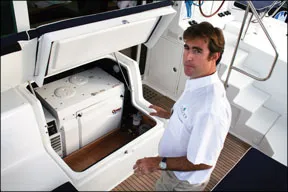
How soon will electric auxiliary propulsion be available to everyman? That depends on whom you ask. Opinions differ widely not just on what type of drive system might surge to the forefront, but even on whether the concept itself is viable. While a handful of companies forge ahead, notably Glacier Bay and Electric Marine Propulsion on this side of the Atlantic, some expected participants are waiting on the sidelines.
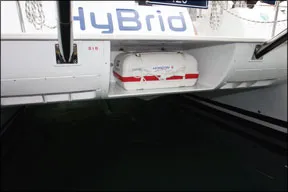
Photos courtesy of Manufacturers
One of the big issues that divides promoters and detractors alike is whether the appropriate way to go in a sailboat is with a pure diesel-electric drive train, with a hybrid electric drive with a diesel generator as back-up, or as a pure electric drive with regeneration capability. We’ll take a look at these and other options later in this article. For now, the short answer is that no single approach suits every sailor all the time.
Simply put, in the diesel-electric system, the electric motor runs only when the diesel-driven generator is running. Such arrangements have long been employed in railway locomotives, submarines, and commercial vessels of many types. In the hybrid system, a large bank of batteries provides the energy for the electric motor and the diesel generator recharges the batteries. On the face of it, the hybrid system offers a certain degree of redundancy in that, assuming the batteries are kept well charged, the boat has a measure of emergency power should the generator fail at an inopportune moment. The hybrid also is capable of recharging its batteries when sailing: Driven by the turning propeller, the motor becomes a generator.
Each of these approaches has its strengths and weaknesses, and while we’ll leave it to their developers to work out the technical issues, we would like to urge anyone contemplating installing an electric drive, or purchasing a boat that has one, to first look very closely at how they expect to use the boat. There’s more entrained in the choice than in picking a flavor at Baskin-Robbins. More on this later.
Among the electric drives currently available in one form or another, or as components, the big variable is operating voltage. Motors are available that run on 24, 36, 48, 72, and 144 volts, and, in the case of Glacier Bay’s diesel-electric system with Ossa Powerlite technology, 240-volt DC. Each supplier will discourse at length on the merits of their voltage choice, but an inconvenient fact haunts the entire field: High-voltage DC is deadly, potentially more so in some circumstances than AC.
While neither form of high-voltage is “safe,” we have a lot more experience with AC aboard recreational vessels than with high-voltage DC. An extensive body of knowledge exists on which to base AC installations so as to make them safe as well as reliable. High-voltage DC is used in a variety of marine and non-marine commercial applications, but these installations are well protected from access by untrained operators.
What voltage constitutes high voltage? That, again, depends on whom you talk to. The American Boat & Yacht Council (ABYC), which sets voluntary standards for the marine industry, defines it as 50 volts and above. Prompted by rapid adoption of high-voltage services in small commercial craft and bigger yachts, though not specifically in propulsion systems, the ABYC is in the process of drawing up guidelines for voltages higher than the 48 volts covered by existing standards.
An absence of standards might not deter individuals from installing an electric drive, but it might impede widespread adoption of the technology. If a surveyor can’t state in an insurance survey that a boat is built according to ABYC standards, that could affect its insurability.
Jim Nolan, who manages the underwriting department for BoatUS, said the company has no clear cut guidance regarding insuring boats with electric propulsion. Each boat is dealt with on a case-by-case basis. A new boat with a factory-installed system would be a good deal easier to underwrite than a one-off or do-it-yourself project, especially in the absence of a standard practice. Lagoon Catamarans’ 72-volt-DC hybrid system, for instance, has qualified for the European standard (CE) certification on the strength of following industrial standards that apply to such applications as fork-lift trucks. Anyone contemplating an electric drive would be well advised to discuss it ahead of time with an insurer and even get a surveyor involved from the outset.
Because of the safety issues surrounding the voltages involved in electric propulsion, Fischer Panda has decided to limit its DC product line to boats weighing 10 tons or less. A company representative we spoke to said that while Fischer Panda currently sells DC generators up to 48 volts in the USA for marine use, it “won’t touch” high-voltage DC because it’s lethal.
A proposed collaboration with Catalina Yachts to fit a diesel-electric system in a Catalina-Morgan 440 never came to fruition due to budget constraints, according to Fischer Panda. But in Europe, Fischer Panda teamed up with Whisperprop to equip a Bavaria 49. (Beyond the fact that one of its boats was used, Bavaria Yachts was not involved in the project.) According to Fischer Panda, after evaluating the Bavaria project, the company decided that the diesel-electric AC system is a niche product that wouldn’t interest their prime market: original equipment builders.
“Although the AC system has some advantages in the improved response of the electric motors … and the quietness of the system, the desired fuel efficiency and weight savings were not evident,” Fischer Panda reported.
Fischer Panda considers the DC system to be more suitable for its North American customers. Although it’s limited in output due to its limited battery voltage of 48 volts, it is still able to power multihulls up to 10 tons.
Currently, much of the movement toward electric drives is taking place in the catamaran world. This makes sense when you consider that a single diesel generator can, in theory, provide all the boat’s electrical needs and also take the place of two diesel-propulsion engines. Taking the lead in the field, Lagoon Catamarans introduced in 2006 the Lagoon 420. Originally offered only as a hybrid, it now is also available in two diesel versions. Corsair Marine is building the Corsair 50 catamaran around the Glacier Bay diesel-electric drive, but the boat’s launch date—formerly set for this summer—has been postponed.
Dick Vermeulen, president of Maine Cat, tried the Glacier Bay system in a prototype power cat, but it failed to meet performance expectations, so production models will have conventional diesels. A number of other cat builders have announced hybrid or diesel-electric projects, but feedback on how they perform is scan’t.
So much for the mainstream—but backwater sailors will go their own way, as they always have. As more vendors and components enter the market, the options for do-it-yourselfers or custom-boat customers become broader and more attractive. However, before going ahead with an installation, make sure it’s appropriate to how you plan to use your boat, and even then be prepared to adapt the way you sail to take best advantage of the system’s characteristics. Here’s a rundown of the various types.
Electric Drive Only
Duffy Electric Boats has for years been building electric launches and lake boats that have the simple capability of puttering around in sheltered waters for a period of time determined by battery capacity and speed maintained. A battery charger powered by shore power charges the batteries overnight. Transferring that approach to a sailboat up to about 25 feet used for daysailing and kept near an electrical outlet shouldn’t be too difficult. It won’t offer the assurance of diesel when trying to get home against current or wind, but a proven 36- or 48-volt system will keep you out of uncharted standards territory.
For a bigger boat, more power, a greater range, or a combination of these requirements, it will be necessary to install a large battery bank and almost certainly will entail going to a higher voltage to keep the amps and the cabling needed to carry them manageable. The boat’s range under power will be limited by the weight of batteries, and while lighter lithium-based technology is on the horizon, for now the standard is lead/acid. The fast charging, but expensive pure lead thin plate (PLTP) Odyssey batteries have attracted particular interest among propulsion enthusiasts.
Electric Drive with Regeneration
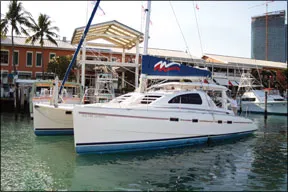
The next level up in complexity is a “reversible” system. When the boat is sailing, the propeller turns the motor, which then becomes a generator. The electricity it makes is used to recharge the batteries. The capability to regenerate extends the boat’s potential range, but the drag on the propeller slows the boat measurably. One hour of regen will not restore the power consumed by one hour of motoring, but if sailing time sufficiently exceeds motoring time, this arrangement offers considerable range.
A regenerating system does have the potential to overcharge the batteries once they become fully charged and the boat continues to sail fast. The solution is, ironically, to give the motor some “throttle,” which reduces the drag on the propeller and consequently the power output. This phenomenon gives rise to a new technique, that of “electro-sailing” in which sails and an electric motor complement each other. At present, the “throttle” must be adjusted by hand, but developers are working on automatic controls. Field trials of existing regen motors such as the Solomon systems suggest that a small regen motor’s ability to match the output of a much higher-rated diesel have been overstated.
Hybrid Electric Drive
A hybrid system adds to the mix an onboard generator, which is used primarily to maintain charge in the batteries, both those for the propulsion motor and for the house services. This arrangement extends the boat’s capability to lie for long periods at anchor, independent of shore power for electricity and without the need to go sailing for the sole purpose of charging the batteries. A hybrid can motor constantly, as long as there is fuel, but it cannot sustain full speed for long periods. This is because the generator is usually rated at a far lower horsepower than that required to drive the boat at full speed.
Diesel-Electric Drive
In a pure diesel-electric, the electric propulsion motor runs only when the generator is running. Storage batteries are not needed for propulsion purposes, and the generator is the source for all onboard electrical power needs. The rationale behind diesel electric lies in the relationship between a diesel engine’s rate of fuel consumption and the load it’s working under. It burns fuel more efficiently when heavily loaded than when lightly loaded. When the diesel engine is disconnected from the propeller, it can be controlled so that it is working in the upper range of its efficiency regardless of how fast the propeller is turning. Nigel Calder’s series of articles in Professional Boatbuilder magazine (www.boatbuilder.com) beginning with the June/July issue delves deeply into the efficiency discussion surrounding these engines. Systems on large vessels are built around multiple generators that switch on or off according to the power demands of the moment. Translating those efficiencies into a smaller boat scenario has proven to be challenging.
Hype vs. Experience
Maine Cat’s Vermeulen, on the company’s website, describes the sea trials he performed in the Maine Cat 45, a power catamaran. He began with a Glacier Bay diesel-electric system with two 25-kW generators, each weighing about 550 pounds.
“With both generators putting out their full power of 25 kW each … our top speed was a disappointing 8.4 knots, and the assumption that electric horsepower was somehow more powerful than conventionally produced horsepower was in serious doubt.”
He replaced the propellers with a pair with less pitch, which allowed the electric motors to reach their full rating of 1,100 rpm, but that only increased the speed to 9.1 knots.
“These are about the same speeds and fuel burns we get on our Maine Cat 41 sailing cat … powered by twin 29-horsepower 3YM30 Yanmar diesels with saildrives and two-bladed, folding propellers.” At the time he installed them, the 25-kW generators were the highest power available from Glacier Bay.

Vermeulen replaced the diesel-electric system with twin 160-horsepower Volvo diesels. At 9.1 knots, they together burned 2.2 gallons per hour, considerably less than the 3 gallons per hour that the Glacier Bay system burned at the same speed. With the twin Volvos maxed out at 3,900 rpm, the boat made 24.5 knots.
Also among the unconvinced is Chris White, well-known designer of ocean-going catamarans. “To date, I’ve not seen any system that makes sense for a cruising boat,” he says, but he might change his mind, “if someone can show me by building one that delivers an advantage in performance, weight, or cost.”
White sees the current bubble of interest in diesel-electric drives as a fad. In the end, he says, you’re getting the horsepower the diesel creates at the crankshaft, which is basically the same whether it’s delivered to the prop via a conventional reduction gearbox or via a generator and an electric motor. Besides, he says, diesel engines and diesel fuel are understood and available anywhere in the world you might take a sailboat. Complex, electronically controlled electric motors are not.
White’s reservations notwithstanding, it’s in the world of catamarans that we’re seeing most of the applications. At first sight, it does seem logical that replacing three diesel engines—two propulsion and one generator—on a fully equipped cruising cat would result in fuel savings. Still, if the generator is big enough to drive the boat at cruising speed (which in a cat is expected to be in the vicinity of 10 knots) and run the air conditioning at the same time, it will be overkill for the times it’s only needed to operate the boat’s services. For this reason, commercial and military diesel-electric systems employ multiple generators that can be switched on and off according to the power demand of the moment.
Corsair Marine hopes that by installing a diesel-electric system in its 50-foot catamaran, it will be able to descend the weight spiral. Where a conventional installation would involve two 75-horsepower saildrives plus a 6-kW genset, it’s fitting a pair of 28-horsepower electric motors, one 25-kW generator, and a 40-amp, 230-volt battery bank. It expects to save about 700 pounds in equipment weight, some of it through the use of high-voltage, low-current systems, which will in turn reduce the rig requirement, thus the structural weight, and so on toward an estimated overall weight savings in the thousands of pounds.
Corsair’s David Renouf estimates that the boat will cruise at 8 knots and be capable of short bursts at 10. He admits that, until the first boat is launched, his information is “based on extrapolation, not proven numbers.” He says that some clients will add a second 25-kW genset to assure longer periods at 10 knots. Currently, the project is running behind schedule, with a launch scheduled before the end of the year.
Cost and Other Benefits
At the present time, there appears to be no reason to install any proprietary electric drive of any description in the expectation of bettering the economics of a standard diesel drive. The motors and their electronic controllers are sophisticated and expensive. A battery bank sufficient to provide a useful motoring range is a big investment in weight, space, and money. When you add a generator and its peripherals, the cost and weight take another upward leap.
Only the simplest system will begin to pay itself off in terms of fuel not burnt, and then only if the boat sees a great deal of use. A diesel-electric system designed to closely dovetail with the way you use the boat may prove to be more efficient over time than a conventional diesel installation, but until enough systems have been installed and used and data from that use compiled and compared, we can’t know that.
So why even consider going electric? Cleanliness and silence of operation are two qualities that make electric propulsion an attractive proposition for a sailboat, but in order to enjoy them, we have to accept the limitations they impose.
A hybrid or a diesel-electric system enables us to have a single fossil-fuel power source for both propulsion and onboard appliances, but whatever fuel we might save as a consequence of motoring more efficiently for a couple of hours will be inconsequential if we run the generator all night to power the air conditioning.
Conclusions
As we go to press, pickings are slim for sailors looking for an electric solution to the diesel problem. Suppliers of components are few, prices are high, and the feedback on long-term reliability is nonexistent. On top of all this is the elephant in the room: the unexplored safety ramifications that accompany high-voltage DC.
However, none of this should deter the dedicated tinkerer who has funds to match his curiosity and who can live within the parameters imposed by electric propulsion.
Practical Sailor encourages our readers to explore the technology, because ultimately, it is the experimenters who bring us the equipment we eventually come to take for granted.
- Pricing Electric Power for a 30-foot Sailboat
- Special Report
- Electric Engines
- Success in the Real World is a Matter of Perspective
RELATED ARTICLES MORE FROM AUTHOR
What your boat and the baltimore super container ship may have in common.
I have gotten excited about repowering my Freedom 30 with an electric motor. A fellow Freedom 30 owner completed his refit about 8 months ago and is very happy with the result, although he wishes he had gone with larger Lipo batteries. He chose a motor from electricyacht.com which sells a 10KW package (quietTorque 10) including motor, performance display, throttle and shaft coupler for $6K. Batteries and charger are extra. The motor does does feature a regen capability. Figure a $10K investment. Big bucks for sure but equivalent to a yard installed diesel repower. I would do the install myself.
I am not a cruiser but have done some lengthy passages from San Francisco to Hawaii. Ideal conditions for regen. I expec between regen and a hundred watts of solar, I could have kept the bank topped up the whole way down despite AP loads, etc. The way back? Not so much. Realistically you would need a small generator and a good stock of gas if you wanted to do much motoring, Having said that, one of the boats that sailed down there with me came home with an outboard as his aux power. I think he had ten gallons of gas.
But I am not planning ocean passages in future, I will be sailing the SF Bay and coastal cruising. When I think about eliminating the engine noise, engine maintenance, fuel tank and tank maintenance, diesel hoses, diesel smell, diesel soot, diesel leaks, r=two boxes of hoses and spares. oil changes, coolant changes, transport and disposal of all the waste to the local recycling facility, lugging fuel jugs down to the boat, storing fuel, filling fuel, buying fuel, worrying about spilling fuel. I mean it just goes on and on.
Frankly, I can’t wait. In terms of range, well, I plan to get a hefty battery bank but I also intend to become a better sailor. I’ll slow down and do more sailing. Gee wiz, what a concept. I’ll be more mindful of time and tide, I’ll take advantage of favorable currents and I’ll be ready to anchor and chill when they are not favorable.
Meanwhile, Elon and his competitors are improving battery technology rapidly. Couple of years from now maybe I double range. But, by then, I won’t be worrying about it because I will be a real sailor.
I look forward to reading an update on the state of electric sailboat propulsion 13 years later…
Most of the time we leave the dock, motor for under half a nautical mile to get out of tiny Wilmette harbor and get the sails up, turn off our much abused Yanmar 3GMF, sail around, turn on the engine, lower the sails, and travel another half a nautical mile back to the dock. Almost all at a very low RPM. But, on occasion we motor or motor sail long distances for hours on end, so a battery only system would not work. But how nice it would be if we had electric propulsion for getting in and out of the harbor.
LEAVE A REPLY Cancel reply
Log in to leave a comment
Latest Videos

40-Footer Boat Tours – With Some Big Surprises! | Boat Tour

Electrical Do’s and Don’ts

Bahamas Travel Advisory: Cause for Concern?

Island Packet 370: What You Should Know | Boat Review
- Privacy Policy
- Do Not Sell My Personal Information
- Online Account Activation
- Privacy Manager

Siemens diesel-electric propulsion on board the MY Vanadis superyacht
Siemens diesel-electric propulsion, namely the Siship EcoProp, is on board the MY Vanadis superyacht, a 31-metre vessel built by CCN (Cerri Cantieri Navali). The system provides that the propulsion may rely on traditional diesel engines to navigate at cruising speed or rather on electric motors for navigation at low speed, thus increasing the comfort on […]
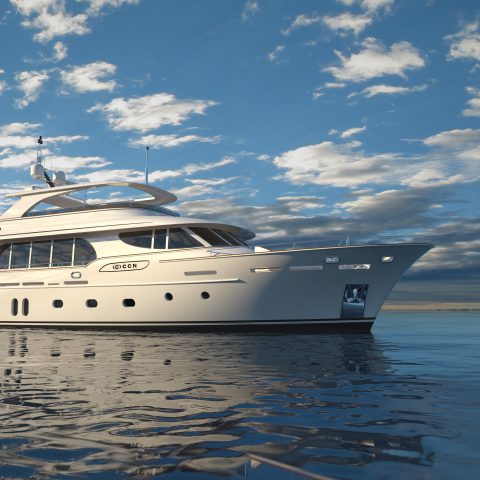
Siemens diesel-electric propulsion, namely the Siship EcoProp, is on board the MY Vanadis superyacht, a 31-metre vessel built by CCN (Cerri Cantieri Navali) . The system provides that the propulsion may rely on traditional diesel engines to navigate at cruising speed or rather on electric motors for navigation at low speed, thus increasing the comfort on board.
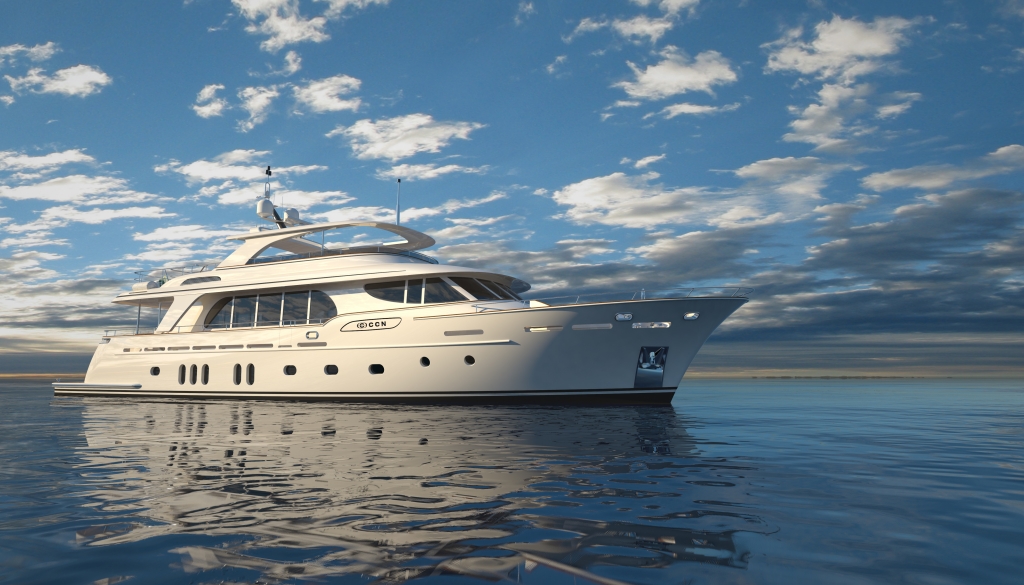
The same electric motors are used as generators, in combination with diesel engines, thus generating electricity with the lowest specific fuel consumption .
THE SISHIP ECOPROP ON BENETTI YACHTS
The yacht is ‘Hybrid Power’ certified
Thanks to the system supplied by Siemens, MY Vanadis has obtained the ‘Hybrid Power’ certification from Lloyd’s Register. It is the very first motor yacht completely made in Italy to achieve this result . The fourth model in the ‘Fuoriserie’ collection – the tailor-made line from the Carrara shipyard – Vanadis owes its name to a goddess of Nordic mythology.
Equipped with two Schottel azimuth double thrusters controlled by the Siemens Siship EcoProp hybrid diesel-electric propulsion system, the Vanadis has a reduced environmental impact, as well as improved on-board comfort thanks to the reduction of noise and vibrations during navigation .
METSTRADE 2019, AMSTERDAM
Siemens diesel-electric propulsion: control and energy management
The Integrated Power System (IPS) from Siemens integrates both propulsion control, electrical power generation, as well as the management of energy stored in the lithium-ion batteries . A cutting-edge system with a single direct current network distributes the electrical power dedicated to propulsion and auxiliary services, thus joining safety and efficiency.
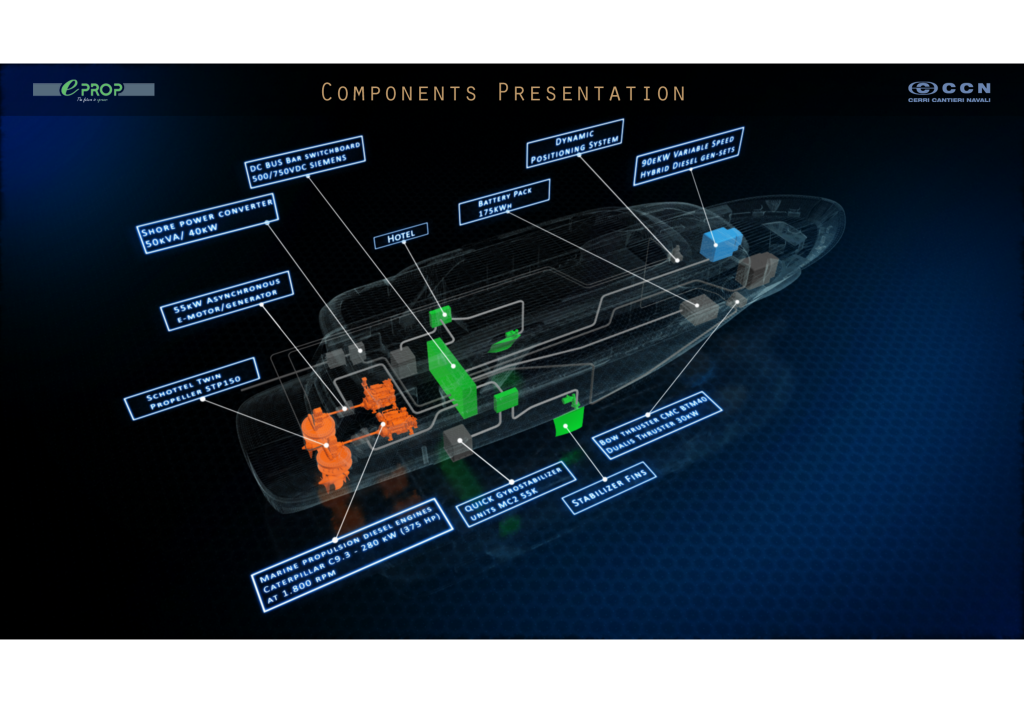
Siemens has supported the shipbuilder along the entire production chain, from the study and management of the project, to the supply of technological components as well as hardware and software engineering solutions.

AS Labruna at the DPE Rimini with LF and start-up MOVe

FPT Industrial: let’s go, XC13
Related articles.
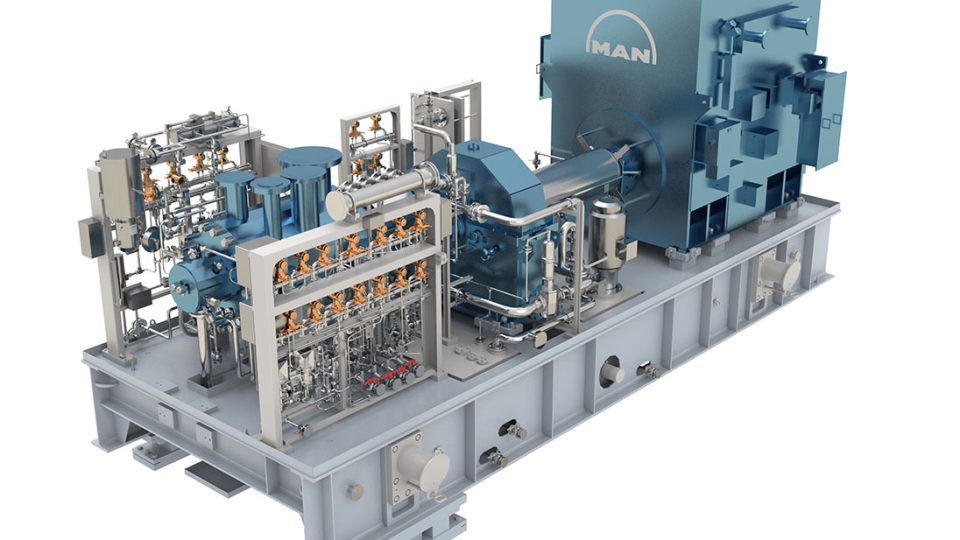
MAN Energy Solutions lands major compressor order for FPSO vessel
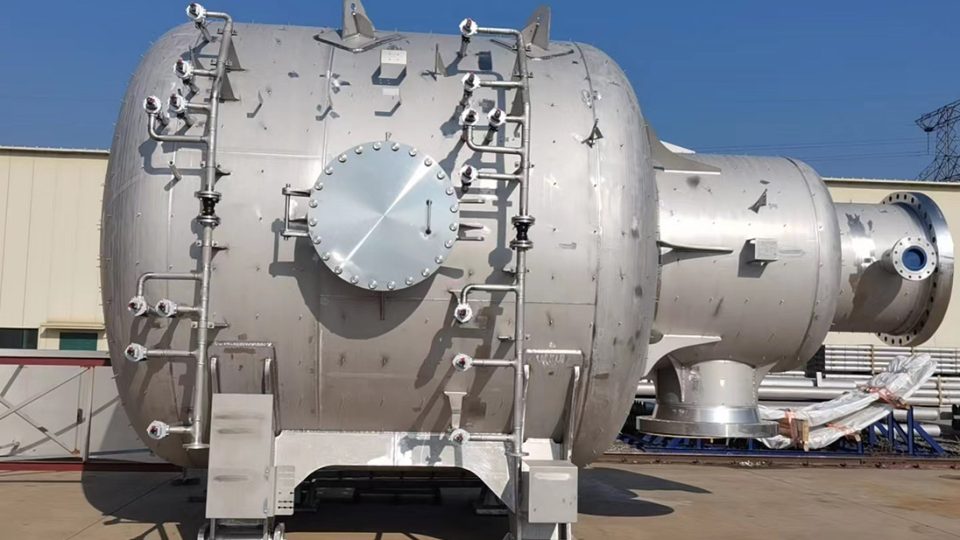
Mitsui E&S takes delivery of largest-ever SCR from MAN Energy Solutions
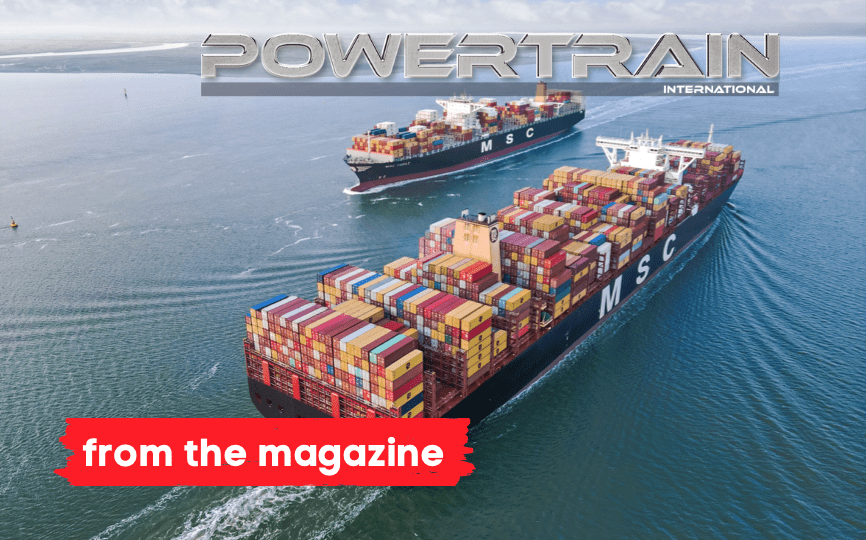
Shipping vs on-road: is LNG the only way?
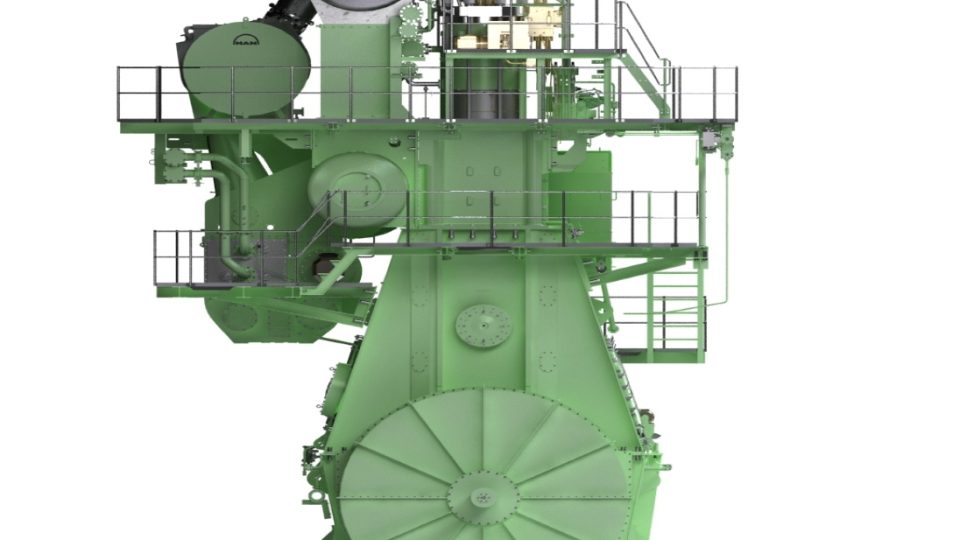
Mitsui performs world-first hydrogen test in collaboration with MAN Energy Solutions
Subscribe to our weekly newsletter and browse the magazine.

Privacy Overview
Yachting Monthly
- Digital edition

Electric yacht: What are the options for going electric?
- Will Bruton
- July 17, 2020
The options for having an electric yacht or a hybrid-electric yacht are growing in popularity; we outline the current options for those making the switch

The Arcona 380Z is a standard production yacht that has been adapted for electric propulsion. Note the increased solar panel surface area with soft panels bonded to the sails. Credit: Jukka Pakainen
A modern electric yacht can come in all shapes and sizes, from the latest high-tech speed boats with recently developed high-performance electric engines, to a traditional tender with an electric outboard on the back. Increasingly yachts are going electric too as electric engines become increasingly capable of propelling boats weighing several tonnes, and with the rigging for sails, at a reasonable speed for an acceptable length of time.
Since the invention of the marinised engine , there has never been the capacity to store enough fuel to cover significant distances in boats that are smaller than a tanker, with fuel capacity always being the limiting factor. As such the best way to cover long distances on a boat fit for a small number of passengers was, and remains, wind power.
For all the many green attributes that using the power of wind offers, there is no escaping that for most, fossil fuels still represent some part of sailing – whether that be a diesel engine to motor in light winds, onto and off a mooring , or to generate power for onboard electronic systems. Even a small tender used to go from ship-to-shore is often fitted with an outboard motor.
Recent advances in electric power, however, have started to make electric propulsion a reasonable alternative to fossil fuel power. Range will always be an issue but that has long been true of a traditional diesel engine. Improvements in lithuim-ion battery performance is, and likely will continue to, increase range every year.
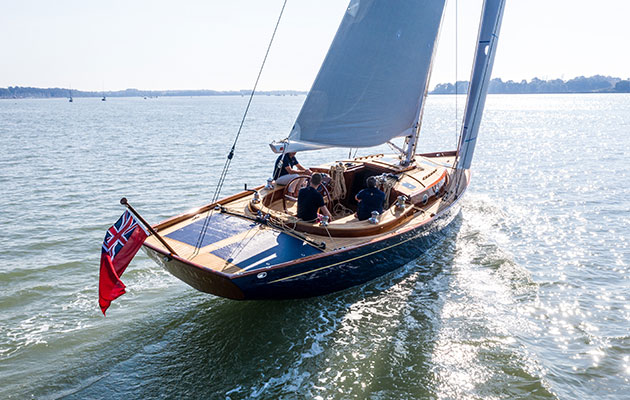
Spirit Yachts 44e – the ‘e’ stands for electric
Additionally electric power and batteries offer the bonus of being able to be recharged via solar panels , a wind turbine or hydroelectric power – via a hydrogenerator mounted on the stern of a boat sailing.
At first glance the electric yacht market could appear in its infancy, but like every revolution, the will of the people is driving forward technology that only a few years ago was seen as the stuff of fantasy.
The market has responded to demand, and battery and motor technology has come on leaps and bounds, driven in part by the rapid development of electric cars.
It may not be commonplace yet, but electric yachting is here, even available ‘off the shelf’, so is it time to get onboard?

The Spirit 111 is a bold hybrid yacht, promising 30 miles motoring under electric power alone. Credit: Ian Roman/Waterline Media
A cutting edge electric yacht
Like Formula One, it’s the cutting edge of electric yachting that trickles down into mainstream production in no time at all.
For Spirit Yachts, a builder defined by a unique blend of traditional and state-of-the-art, electric yachting has been driven by demanding clients that want their yachts to be at the cutting edge.
Spirit Yachts have now produced a number of projects aimed at the all electric luxury yacht market including the Spirit 44e electric yacht and a recent project, the Spirit 111, had all the hallmarks of a superyacht project and the team had to earn their keep delivering to brief.
Managing Director Nigel Stuart explained how it works.
‘The 111 combines several cutting-edge technologies to deliver a something that’s never really been done before. A lithium-ion powered electric drive system can be charged by hydrogenation and also two high-wattage diesel generators.
‘Each generator is 22kw, meaning they can pack a lot of power into the system in a short period of time, they don’t need to run for long to fully recharge.
‘The prop is both a means of drive and power generation, so no separate hydrogenerator is needed. She will be capable of motoring under electric alone for more than 30 miles.
‘When you take on a project that’s electric, it makes you think hard about efficiency so the air conditioning, water heaters and everything in the galley has also been carefully selected to use less power.
‘For her owner there is very little compromise and some major advantages.’
Whilst it’s a long way from the average cruising yacht, the trickle-down effect of projects like the Spirit 111 can’t be underestimated.

Calypso , a Contessa 32, was the yard’s first foray into electric-powered yachts. Credit: Jeremy Rogers
Traditional electric yacht
Jeremy Rogers’ yard in Lymington is the birthplace of the iconic Contessa designs and a veritable temple to long keeled , traditional craft.
Less well known is the yard’s interest in electric auxiliary engines, something they have been involved in for more than 10 years.
Their first project, the refit of a Contessa 32 called Calypso, was an experiment by the Rogers family to see what was possible.
‘ Calypso was a test bed in the technology’s infancy,’ explains Kit Rogers of this early electric boat.
‘Inevitably, we didn’t get it all right, but we learned a lot about the dos and don’ts of electric yachting. The end result was a hybrid. The more we did, the more interesting the project became.
‘It’s not just the obvious, silent peaceful propulsion; it’s also the things you take for granted about a cruising boat. For example, no gas, we didn’t need it because we had electric power.
The yard has also worked on an electric folkboat conversion for a foreign customer.
‘The client, first and foremost, loves to sail. He sees the electric as an auxiliary option, along with the rowing and is excited to own a boat that’s quietly different.
‘He’s looking for a more connected experience and an electric boat helps him achieve it. When you’ve been motoring in and out of marinas under chugging diesel engines for years, the electric motor is something of a revelation.

Arcona has installed solar sails on its latest 380Z electric yacht
Off-the-shelf electric yacht
Perhaps the biggest indication of the future of the electric boat is the willingness of production and semi-production builders to pin their flags to the mast and embrace it.
One of the first was Hanse, who developed a version of their 315 utilising a Torquedo electric pod system.
Providing around the same amount of power as a 10 horsepower diesel, a 4.4kWh lithium ion battery pack powers the system.
Arcona, Dufour, Elan and Delphia also have electric boat models and are each taking their own direction on entering the market.
Arcona’s 380Z (the ‘Z’ stands for ‘zero emission’) fully electric boat has solar panel covered sails, capitalising on the large surface area to top up batteries under sail.
In the multihull market, there is even more scope for solar, wind and hydrogenation due to the horizontal surface area available for solar charging.
What are the options for an electric yacht?
Pure electric.
Purely electric systems can be broadly divided into two categories, high and low voltage.
The latter is the simplest option in terms of how it works and requires less specialist knowledge to install.
Kit Rogers installed a 48v Ocean Volt system in his latest project and remarked on the experience.
‘The advantage of the low voltage system is its inherent lack of complexity. Whilst we’ve coupled it with lithium ion battery technology, it can also be wired up to conventional lead acid batteries. There are pros and cons to both. What surprises everyone is the size, it’s a tiny motor and is surrounded by lots of space where the engine would normally sit.’
High voltage systems are more advanced, and utilising lithium-ion technology, their capacity is improving year on year.
For larger yachts this is generally seen as a better option.
A partnership between BMW and Torqueedo has led to the development of the Deep Blue 315v high voltage battery.
Effectively the same unit as found in the BMWi3 electric cars now often seen on the high street, the system produces a lot of power and is being used on the Spirit 111 project as well as catamarans.
Electric hybrid
One big barrier to entry exists for most potential electric yacht buyers – range.
Even the most advanced set-ups are limited to a maximum of a few hours motoring at cruising speed.
‘The electric motors excel at two things in particular,’ explained Kit Rogers.
‘The first is as auxiliary power for getting in and out of marinas. The second is engaged at low power to very efficiently motor-sail in light airs. If you want to do more than that, at present, you need to add a way of packing in the charge into the battery quickly whilst at sea; which means a generator’ .
As with electric cars and as enthusiasm builds for the technology, a hybrid option, pairing a generator with an electric drive system, is already proving popular and is probably the most practical option for those planning to cruise any distance.
Using a large generator, charge can be quickly put into the system when needed.
Once under sail, the yacht’s propeller becomes a hydro generator, meaning that diesel power is not needed day-to-day.
Solar can also be used to add additional charging capacity.
‘When a fully integrated electric hybrid system is incorporated into a cruising yacht from the outset, its possibilities really become clear,’ explains John Arnold, UK manager at Torqeedo.
‘Sailing for days on end with no engine noise is entirely possible. There are other less obvious benefits too. Electric drives have no long rotating shaft, so can be used as pod drives as well, meaning the boat is far more manoeuvrable than even a yacht equipped with bow and stern thrusters.’

Spirit Yachts 44e
How much does it cost to convert a yacht to electric power?
The technology exists, but anyone seriously considering going electric will want to crunch the numbers.
In the case of taking out a traditional inboard diesel and replacing it with an electric system, it’s relatively easy to work this out.
However, unless you include an auxiliary generator, you will be limited to battery range alone.
For this reason, we’ve done a like for like comparison for a 35ft yacht engine refit, including the cost of a generator to make the system a practical hybrid.
Unsurprisingly, at the moment, there’s a big difference in cost, but at between three to six times the cost, it is gradually coming into the realms of possibility, and prices should continue to drop as technology develops and evolves.
Ocean Volt SD10 Motor system (including batteries, charger and 6kw generator): £30,825.16
Beta Marine Beta 20hp Marine Diesel: £4,100
If you enjoyed reading this….
A subscription to Yachting Monthly magazine costs around 40% less than the cover price .
Print and digital editions are available through Magazines Direct – where you can also find the latest deals .
YM is packed with information to help you get the most from your time on the water.
- Take your seamanship to the next level with tips, advice and skills from our experts
- Impartial in-depth reviews of the latest yachts and equipment
- Cruising guides to help you reach those dream destinations
Follow us on Facebook , Twitter and Instagram.
- Digital Center
- Press & Media
- Location Finder
Find the right engine for diesel-electric propulsion
Full range of man four-stroke engines for diesel-electric propulsion.
Explore the capabilities and range of our engines.
Powerful and strong: Our four-stroke engines for diesel-electric propulsion
Man l+v51/60df (de).
MAN Energy Solutions integrated its in-house core technologies to create the dual fuel marine MAN L+V51/60DF engine that converts liquid fuel, natural gas or a combination of both into electric or mechanical propulsion power.
- High-efficient variant/high-power variant 500 – 514 rpm/500 – 514 rpm
- 6,300 – 16,800 kW/6,900 – 16,100 kW
MAN L+V49/60DF (DE)
The MAN 49/60DF is future-proof in multiple ways. Its benchmark fuel efficiency guarantees competitive vessel operation. The very low level of methane emissions ensures long-term CO2 emission compliance.
- 7,800 – 18,200kW
- At 600 rpm: 1,300kW
- Power-to-weight ratio: 13.5 – 16.7 kg/kW
- Gas mode: 6,990 kJ/kWh
MAN L+V48/60CR (DE)
The MAN L+V48/60CR injection system uses the latest MAN Energy Solutions common rail technology, allowing for flexible setting of injection timing, duration, and pressure for each cylinder.
- 500 – 514 rpm
- 7,200 –19,200 kW
MAN L35/44DF (DE)
The MAN L35/44DF offers high output, dual fuel flexibility, and Tier II and Tier III compliance. It is ideal for mechanical propulsion, electric propulsion as well as auxiliary GenSet applications
- 720 – 750 rpm
- 3,060 – 5,300 kW
- 2,953 – 5,115 kWe
MAN L+V32/40 (DE)
The MAN L+V32/40 range runs on inexpensive HFO from standby to full load. Twin camshafts provide unsurpassed flexibility, permitting a wide range of choices between optimal output/fuel ratio and minimized emissions.
- 720 – 750 rpm
- 3,000 – 9,000 kw
- 2,895 – 8,730 kWe
MAN L+V32/44CR (DE)
By employing the latest technology combined with electronically controlled common rail injection, the MAN L+V32/44CR is setting new benchmarks in its class, such as low NOx, CO2, and soot emissions
- 3,600 – 12,000 kW
- 3,474 – 11,640 kWe
MAN L27/38 (DE)
The MAN L27/38 GenSet is designed for lifelong operational reliability and ensures trouble-free operation and long and safe overhaul intervals. It will be ready and running when you need it.
- 720 – 750 rpm
- 1,500 – 3,150 kW
- 1,440 – 3,025 kWe
MAN L27/38 Mk2 (DE)
MAN L27/38 Mk2 units offer reliable operation. They can run on conventional fuel types and biofuels and deliver low OPEX during their entire life cycle.
- 720 – 900 rpm
- 1,980 – 3,690 kW
- 1,900 – 3,540 kWe
MAN L21/31 Mk 2 (DE)
MAN L21/31 Mk 2 units are characterized by reliable and HFO-based GenSet power, delivered at the lowest possible accumulated costs during an entire life cycle. As such, the GenSet represents a safe investment.
- 900 – 1,000 rpm
- 1,000 – 1,980 kW
- 950 – 1,880 kWe
Powered by the MAN 175D high-speed engine, our marine GenSets combine reliable power with unprecedented compactness. They can be configured with several options to match the requirements of all marine applications.
- 1,500 – 1,800 rpm
- 1,440 - 3,800 kW
- 1,382 - 3,648 kWe
S.E.M.T. Pielstick PC2.6B (DE)
The proven Pielstick PC2.6B design delivers high power density, low emission levels, and reduced running costs in various diesel-electric propulsion configurations.
- 9,000 – 13,500 kW
S.E.M.T. Pielstick PA6B (DE)
The PA6B with an integrated cooling system for fresh water, lube oil, and fuel oil utilizes a compact design for narrow engine rooms. Designed for extreme robustness, the PA6B is made to ensure safety even in the harshest environments.
- 900 – 1,000 rpm
- 4,200 – 7,400 kW
- 4,074 – 7,178 kWe
Innovative, powerful, and efficient propulsion
Electric propulsion is not a recent innovation, however it has become the “standard” propulsion solution in many applications, especially when it comes to specialized vessels. High redundancy and reliability of the propulsion plant, improved maneuverability of the ship, and lower fuel oil consumption due to optimized loading of the engines are the key. Diesel-electric systems by MAN Energy Solutions are designed to meet customers’ highest requirements. Times are changing and thanks to new direct current (DC) components and an innovative engine control philosophy, diesel-electric propulsion has evolved, creating a much more compact solution with a range of potential applications.
Always on your side: MAN PrimeServ
MAN PrimeServ provides 24/7 service across the globe. Our range of services includes technical support, consulting and OEM spares, as well as maintenance, repair and comprehensive individualized service plans.
How you benefit:
- Prompt delivery of high-demand OEM spare parts within 24 hours
- Fast, reliable and competent customer support
- Ongoing training and qualification of operators and maintenance staff
- Diagnosis and troubleshooting with our high-performance online service
Do you want to improve the performance of your business? Looking for more efficiency and power?
Start your engines now and reach out to us today. Our global network of experienced engineers is happy to design the perfect-fit solution for you and your project.
Continue reading
- Fishing vessels pdf, 58286 KB Download
- Four- stroke marine systems pdf, 10891 KB Download
- LNG Shipping pdf, 38088 KB Download
- MAN EcoLoad advisory tool pdf, 1929 KB Download
- Naval defense pdf, 5866 KB Download
- OSV and workboat pdf, 51251 KB Download
- Prepare for MAN 175D pdf, 1536 KB Download
- Technology for ecology pdf, 1507 KB Download

- CLASSIFIEDS
- NEWSLETTERS
- SUBMIT NEWS

Siemens diesel-electric propulsion on board the MY Vanadis superyacht
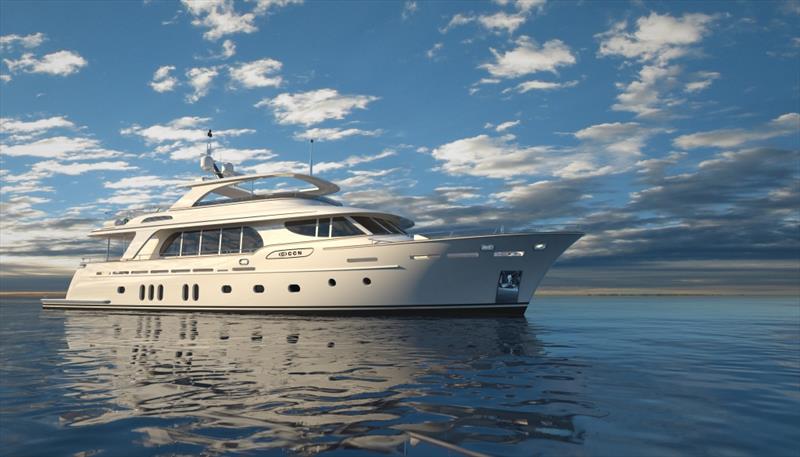
Related Articles
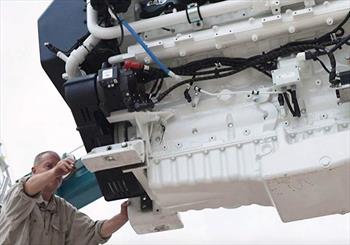
The Pros, Cons, and Future of Electric Yachts and Sailboats
- By Sail Greener
- Last updated: April 27, 2022

Sail Greener is supported by our readers. When you buy through links on our site, we may earn an affiliate commission.
If you sail you likely spend considerable time—and money—cleaning, fixing, and worrying about your diesel or gas engine. When it comes to safety, your backup propulsion is as important as your sails. Can you rely on electric motors for safety? What are the pros and cons of buying an electric sailboat?
Diesel engines are reliable, but they pollute. Diesel (and gas) engines emit greenhouse gasses and exhaust that includes particulate matter and carcinogens that are a risk to human health.
Until recently, alternatives to marine diesel engines were limited. Boat owners could carry out their own repower projects or purchase expensive commercial electric motors. Storage capacity was a problem.
Fortunately, the winds are shifting and there are now numerous high quality and economically competitive alternatives to traditional marine engines. In this article we describe the pros and cons of purchasing a new motor or repowering an existing engine. We also describe the market for marine electric propulsion systems and identify leading boat builders, manufacturers, and installers.
Why do we need electric sailboats?
The climate is warming and we continue to pump greenhouse gasses into the atmosphere at a torrid pace. Transport emissions, including road, rail, air and marine transportation, account for nearly a quarter of global CO 2 emissions. 1 https://www.ipcc.ch/report/ar5/wg3/transport/ According to the United Nation’s International Maritime Organization , marine traffic accounts for nearly 3% of the world's CO 2 emissions.
While emissions from recreational boaters are less than those from shipping and fishing fleets, they are still considerable. According to an estimate from electricmotoryachts.com , if just 5% of the roughly 13 million registered boats in the United States today repowered with electric, boaters would eliminate an estimated 1 billion pounds of CO 2 emissions. Scaled across boaters around the world, the potential for boaters to meaningfully reduce greenhouse gas emissions is significant.
Exposure to diesel emissions also poses health risks. The smallest particulate matter can contribute to heart attacks, strokes, and lung disease. High exposure to small particulates can impair brain development in children. The International Agency for Research on Cancer , part of the World Health Organization (WHO), classifies diesel engine exhaust as carcinogenic to humans.
Is there a market for marine electric propulsion?
Global concern over climate is leading to a revolution in how we produce and use renewable energy. This is particularly true in the transportation sector. Sales of electric cars in 2019 increased 40%. In 2020, Tesla motors alone produced almost 500,000 new electric vehicles. This helped to propel Elon Musk to become the world’s wealthiest person. Electric vehicle penetration is still just about 3% but growing dramatically 2 https://www.mckinsey.com/industries/automotive-and-assembly/our-insights/mckinsey-electric-vehicle-index-europe-cushions-a-global-plunge-in-ev-sales# A key factor driving this growth, according to the European Patent Office (EPO) and the International Energy Agency, is innovation in rechargeable lithium-ion batteries and other storage technology. Batteries now account for nearly 90% of all patenting activity in the area of electricity storage. Between 2005 and 2018, patenting activity in batteries and related electricity storage technologies grew four times faster than the average of all technology fields. 3 https://www.iea.org/reports/innovation-in-batteries-and-electricity-storage
It is clear we are reaching a tipping point for electric automobiles and trucks 4 https://www.theguardian.com/environment/2021/jan/22/electric-vehicles-close-to-tipping-point-of-mass-adoption . Is the marine sector also experiencing an electric revolution?
The market for marine electric propulsion systems is lagging what is happening with cars and trucks. However, the potential for growth in this sector is extraordinary. In an article published in Yachting World, Christoph Ballin, CEO of electric motor manufacturer Torqueedo, estimated that only about 1.3% of marine propulsion systems are electric. 5 https://www.yachtingworld.com/features/future-yachting-smart-technology-126136 According to an article published in 2017 by IDTechEx there are over 100 manufacturers of electric boats and ships with an estimate of more than $20 billion in global sales by 2027 for non-military boats. According to the IDTechEx report, recreational boats are the largest—and fastest—growing electric marine market by sales.
The growth potential is enormous considering the size of the recreation economy. In the United States alone, in 2019 outdoor recreation generated US$ 788 billion dollars in output. 6 https://boatingindustry.com/news/2020/11/12/orr-provides-breakdown-of-latest-recreation-economy-data/ An estimated $37 billion of this came from retail sales of boats, engines, accessories and marine services. According to the U.S. Bureau of Economic Analysis (BEA) Outdoor Recreation Satellite Account (ORSA) data, Boating and fishing was the largest conventional activity for the nation as a whole, adding US$ 23.6 billion to the economy. This was the largest conventional activity in 30 states and the District of Columbia and the second largest activity in 11 states. 7 https://boatingindustry.com/news/2020/11/12/orr-provides-breakdown-of-latest-recreation-economy-data/
Pros and Cons of Electric Motors for Boats
What are the pros and cons of electric motors for sailing?
Pros of electric propulsion
- Less noise : Electric motors are quieter than diesel engines and nearly vibration free.
- Lower long-term cost : Motors last a long time and require no fuel. You need batteries and electricity, but the sun and wind can recharge your batteries. You won't need to constantly change engine fluids, filters, or worry about leaks or old tanks.
- Cleaner and healthier: You won't end up with an oily mess in the engine room and bilge
- No emissions, no exhaust : Passengers and crew won't be exposed to hazardous fumes and particulates. You won't be spewing out carbon pollution.
- Instant power: Electric motors can go from zero to full torque instantaneously. Motors do not need to wait for engines to warm up.
- Weight and storage : Electric propulsion systems are typically less heavy than equivalent diesel systems. OceanPlanetEnergy.com estimates that electric propulsion systems are typically 1/3 the weight of diesel systems. This depends, however, on the weight of your battery bank.
- Easier maintenance and lower costs: Electric motors are simpler and easier to maintain than diesel generators. OceanPlanetEnergy.com estimates that maintenance costs could be 1/20 of the maintenance costs of a diesel engine in the first decade, even less over time because of electric propulsion systems use far fewer moving parts.
- Increased reliability and safety : Fewer moving parts translates into fewer breakdown which means which means more safety.
- Regeneration: Batteries can be recharged while sailing using, solar, wind, and hydro generation systems. For example, at sailing speeds over 6 knots Oceanvolt systems are reportedly able to generate significant power for recharging the battery bank.
- Improved maneuverability: Electric motors have high torque at low RPM, which can make maneuvering in tight spaces like marinas more precise. Electric motors can switch from forward to backward instantaneously.
Cons of electric propulsion
- Range anxiety: Depending on your battery bank and ability to recharge, you may have less range with an electric motor compared to a diesel engine.
- Cost: Electric motors can be expensive relative to combustion engines, but costs are plummeting.
- Lack of familiarity : Sailors familiar with traditional engines may not feel prepared or comfortable to switch to a new form of power.
- Fires: There can be a small risk of fires from batterie with improper maintenance, but this is also true with internal combustion engines.
- Charging time: Recharging batteries can take time, but charging times are changing quickly. Tesla V3 Superchargers support peak rates of up to 250kW per car, which translates to about 75 miles of charge in 5 minutes for a Model 3 and charge at rates of up to 1,000 miles per hour 8 https://www.tesla.com/blog/introducing-v3-supercharging . In January 2021 the Israeli company StoreDot announced new “exreme-fast-charging” lithium-ion batteries that could charge a car battery capable of 100 miles of charge in 5 minutes. It will only be a matter of time before similar speed and capacity is available for boaters.
Industry Leaders
Who are industry leaders in the electric sailboat space?
Electric propulsion companies
Numerous companies produce electric and hybrid propulsion systems for the marine sector. Some of the best known and highest quality brands that provide electric propulsion systems for yachts and sailboats include:
- Elco Motor : Elco is one of the industry leaders in this field. The company has been around for more than 125 years and now produces a wide range of outboard and inboard electric and hybrid propulsion systems.
- OceanVolt : The Finnish company is one of the industry leaders in electric propulsion. The company produces a wide range of electric propulsion systems for monohulls and multihulls. The company has provided cutting-edge electric propulsion systems for Vendée Globe racers, including Alex Thompson’s Hugo Boss and Conrad Colman in 2017, and other racers like French Olympic sailor Damien Seguin.
- Torqeedo : When Torqeedo was founded in 2004, concepts like “clean tech” and “electromobility” were just a glimmer in Mother Earth’s eye. One of the pioneers in the modern marine electric propulsion sector, Torqeedo is now one of the market leaders. The company offers outboard and inboard electric motors and hybrid drive systems ranging from 0.5 km to 100 kw in addition to diverse accessories from lithium batteries and solar charging equipment to smartphone apps.
- Aquamot : This German company produces in-house electric propulsion systems for electric for boats and ships, including motors, batteries, and chargers.
- Kraeutler Elektromotoren produces a wide range of industrial, ship drive, and boat motors, including drive units for motor and sailing boats.
Electric sailboat manufacturers
Who builds sailboats with electric motors?
Electric propulsion is going mainstream. Dozens of boat builders are building electric-only boats (like SoelYachts.com and Silent-Yachts.com ). Some traditional yacht builders now offer electric propulsion options—and this will likely grow to include all major manufacturers in coming years. Examples of leading yacht manufacturers that include electric propulsion options include:
- Arcona Yachts : A leading builder of high quality yachts from Sweden, Arcona is starting to offer high quality zero-emission models, such as the Arcona 415 .
- Alva Yachts : The German luxury electric yacht brand has designed both mult-hull (non-sail) and monohul (sail) boats. The company’s 25-m Ocean Sail 82 was designed with a hybrid propulsion system and a high capacity battery bank.
- Baltic Yachts : The Finish producer of luxury yachts and a world leaders in advanced composite yacht building in 2020 selected Oceanvolt for the company’s 68-foot Café Racer manufactured in Finland. The Javier Jaudenes designed boat is just over 20 meters long and 5.5 meters wide.
- In 2001 Elan Yachts and Oceanvolt agreed to partner to build a full range of electric-powered yachts ranging from the luxurious GT6 to the the sporty E-Line performance cruisers.
- Hanse Yachts : The world’s third largest boat builder, Hanse produces the Hanse 315, which includes an electric rudder-drive option.
- Salona Yachts : A Croatian boatbuilder, Salona builds the Salona 46, a fast, comfortable, and luxurious electric yacht and winner of the Best Green Boat Award at the Newport International Boat Show .
- Sunreef Yachts Eco : A manufacturer of luxury bespoke multihulls, Sunreef Yachts Eco catamarans are equipped with composite-integrated solar panel systems and lightweight batteries for energy efficiency and environmentally-conscious luxury cruising.
- Wally : The Dutch yacht builder produces, among its many other models, the 11.35 meter Wallynano MKII, which relies on an OceanVolt electric propulsion system
- Zen Yachts : A new company established in 2021, Zen builds what it claims is the world's first series production catamaran equipped with a wingsail.
Electric conversion companies
Who can help me convert my sailboat to electric propulsion?
A growing number of companies are dedicated to helping boat builders and individuals convert their yachts. These companies may provide design and support options for advanced battery systems, solar and wind systems, hydrogenation, and overall system design. Some of these companies produce their own electric motors and systems. Leading companies in the field include:
- OceanPlanet Energy : This company includes some of the giants of the industry. Bruce Schwab was the first American to officially finish the Vendee Globe. Nigel Calder is one of the best known sailing technology writers, including his must-read classic, Boatowner’s Mechanical and Electrical Manual. The company provides energy storage, charging, and monitoring systems; system design and consulting.
- Electric Yacht : The Minnesota, USA-based company with the eponymous name supports sailors interested in electric propulsion systems. The company helps boaters design and size system and provides motor kits, batteries, chargers, and other components. The company provides examples of conversion projects on its website.
- e Marine Systems specializes in distributing solar panels, wind generators, electric propulsion drives, inverters, and energy storage systems. The company is located in Fort Lauderdale, Florida, USA.
- Naval DC produces both “pure” solar and hybrid electric systems ranging from 10 kW to 1 MW. The company provides lithium battery solutions, data and monitoring systems, electric propulsion, and matched propeller systems.
Yacht dealers
A small but growing number of yacht dealers offer new and used electric boats. Green Yacht Sales is an example of a small company that supports the sale of electric yachts and systems from diverse manufacturers.
Global clearinghouses, like YachtWorld and Boat Trader , now provide options to filter searches for electric propulsion sailboats.
Battery technology and companies
Until recently, the amount of energy batteries could store was limited. The cost of buying a new battery bank was prohibitive for most sailors. Today, however, costs are dropping and batteries provide more charge. Range anxiety remains one of the biggest reasons sailors don’t want to swap out polluting diesel engines for quieter and cleaner all-electric systems. However, this concern will soon be obsolete.
There are many high quality marine battery suppliers. Some of the major players in the LiPO market include:
- ChargeEx Lithium Ion Batteries
- Dakota Lithium
- Dragonfly Energy
- Victron Energy
Successful Examples
Okay, this all sounds good in theory, but is it really possible to throw out your old engine and install a new motor? Here are a few examples of individuals and companies making the switch to electric yachts.
As with many disruptive technologies, it is easier for wealthy individuals to pay more—often much more—for tomorrow’s technology today. That said, these Super Early Adopters are a harbinger of things to come. These individuals may be risk takers but they are also typically really smart and forward-thinking.
Swedish billionaire Niklas Zennstrom is one example of a pioneering “mogul” in the electric yacht world. The founder of Skype and former Time Magazine 100 Most Influential People awardee, in 2018 Zennstrom’s team launched Rán VII. Yachtingworld described the boat as “…so angular it calls to mind Darth Vader or a Stealth bomber.”
Zennstrom shared his views on the future of electric racing in a CNN article in 2018:
“Having gone through the design, build and initial test cycle there is no doubt to me that the future for racing yachts is electric propulsion. It's lighter, less drag, quieter, and most importantly it is environmentally friendly.”
Do-it-yourselfers have been converting electric sailboats for years. The mainstream boating magazines and the media are increasingly showcasing the stories of these sailors retrofitting their boats. A few examples of well-publicized electric yacht conversion stories include:
- In 2019 Yachting World wrote an article, “How hybrid sailing yachts finally became a feasible option.”
- Dufour 382: According to an article in Yachting World , the owners Alcyone , a Dufour built in 2016, was retrofitted with an Oceanvolt SD15 saildrive moto r.
The future of electric sailboats
We are facing a climate emergency and the world is mobilizing to reduce emissions of greenhouse gasses. A growing number of boat builders, engine and battery producers, service companies, and individuals are addressing this need by building and retrofitting emission-free sailboats. We are still in the early stages of this transformation, but change is coming quickly.
Some of the major challenges—and opportunities—for catalyzing this transition in coming years include:
- Battery storage, charging, and cost: The pace of technology change in the battery sector is dizzying. The amount of charge, the time to charge, and the price per kilowatt of battery storage systems are all improving. Superchargers are already widespread on land. How long will it take for marine supercharging stations to fill the world’s marinas?
- Overcoming tradition : Sailors who have used the same technology for decades may hesitate to switch to new technology. Sailors used to heavy yachts and small batteries may look with skepticism on this new technology. Range anxiety is very real in the middle of the ocean.
- Cost : As with any new technology, early adopters may have to pay more. The cost of electric propulsion, solar and wind power, and battery storage are dropping quickly. Cost will soon be less of a concern and may become a clear benefit.
- Retrofits: Many boats still sailing form 1960s and 1970s so 50 years of old boats locked in. But this is also an opportunity for individuals and companies who are willing and able to take this space
- Manufacturing: making boats expensive and companies may not want to take risks. But new companies are emerging, and the major yacht companies now coming out with electric options (examples).
We are at the dawn of a new age of sailing. With each passing month electric propulsion technology is improving. Motors are getting better, batteries and solar panels are getting cheaper, and electric sailboats are starting to become mainstream.
Finding more information
If you want to learn more about healthy products, check out The Sail Greener Guide to Healthy Sailing . If you want to learn more about who is working to conserve the ocean, see our list of The Best Ocean Conservation Organizations for Sailors .
- Sail Greener
- Originally Published: February 26, 2022
Table of Contents
- climate , diesel engine , electric motor , environment , sailboat , yacht
Like this post? Share with friends and colleagues!
Related articles.

Climate Change and the Future of Sailing
Earth’s climate and oceans are changing. What does human-induced climate change mean for the future of sailing?

Green Boat Shows 2022
What major international boat shows promote green events or themes? Check out our calendar of 2022 International Boat Shows to find out!

Quiz #1: Ultimate Sailing Logo Quiz
Sail Greener Quiz #1: Ultimate Sailing Logo Quiz

Electric Yachts for 2022
A growing number of boat builders are joining the electric yacht revolution. What are some of the best eco-friendly sailboats and catamarans for 2022?

Best Yacht Charter and Boat Share Companies for Sustainable Sailing
Looking for the best yacht charter, boat share, or boat rental company that has eco options? What is the size and growth potential of the green yacht charter market? Check out the latest on eco yacht charters.

The Sail Greener Guide to Toxic Products and Health
Hazardous chemicals and compounds are used to build and maintain sailboats. Learn how you can use non-toxic alternatives to reduce your exposure to toxic substances and risks to your health and the health of the environment.

The Best Ocean Conservation Organizations for 2022
Are you concerned about the the world’s oceans and want to help? Check out the Sail Greener guide to the world’s best ocean conservations organizations!
Recent News: Boats and Gear

Orcas attack The Ocean Race
(June 22, 2023; Day 8) – As the final leg of The Ocean Race passed along the western shore of Europe before turning in to

This Sleek 80-Foot Electric Catamaran Uses Solar Power to Cruise With Infinite Range
The zero-emissions multihull sports an innovative solar skin that continuously generates power at sea….click HERE to read the rest of the article from the ORIGINAL

Exhibitors and Events at Electric Boat Show Milan 2023
The second Electric Boat Show is taking place at the Idroscalo in Milan this weekend and has a wide range of electric boat exhibitors and

Historic sailing ship starts first cargo service across Europe
De Tukker, the first ship operated by Dutch sustainable shipping company Ecoclipper, has set sail on the firm’s maiden voyage — 111 years after it

Francis Joyon “The great way to limit your carbon footprint is to have a very small budget”
On the occasion of Francis Joyon’s stopover in the city of Marseille, we went to meet him to discuss The Arch project and his vision

An art contest to invent the sailing ship of the future
The association Windship launches a contest for children to imagine the sailing ship of the future. A great opportunity for sailors, artists and inventors to
World tour for model boat inspiring citizen science against environmental pollution
A model sailing boat which represents a key part of a project working to banish single use plastics has embarked on a global tour that
Torqeedo more than doubles warranty to 5 years on Travel electric outboards
Torqeedo announced today that it is introducing a new, industry-leading warranty that more than doubles the existing warranty from two (2) to five (5) years

Solar panel: how to choose the right one for your boat?
More and more harbors are forbidding the use of electricity when you are not on board, for reasons of economy, ecology and safety. So how

Life in ocean’s twilight zone ‘could disappear’ amid warming seas
Less food is falling to dimly lit waters, home to specially adapted marine life – but emissions cuts would stem decline Life in the ocean’s

Oceanvolt Servoprop, now available for large boats
Distributed by e-Nav Systems, the Oceanvolt electric motorization solutions are completed with a complete propulsion system available for sailboats up to 70 feet or 25

Spirit Yachts goes all-electric for Southampton Boat Show
Yacht designer and builder Spirit Yachts will be displaying two electric drive sailing yachts at this year’s Southampton International Boat Show from 16-25 September 2022.
More News...
An updating news feed on the latest about sustainable sailing. Check out the following topics: - Boats and Gear News - Products and Apparel News - Oceans and Environment News - Charter and Travel News CHECK THE LATEST NEWS...
Looking for book recommendations for maintaining your boat, ocean science and conservation, adventure, and other good reads? BROWSE BOOKS...
Current Weather!
Need to high quality weather data for wind, sun, tide, and more? Check out the latest with our detailed global weather map VIEW CURRENT WEATHER!...
So many videos, so little time. We do the work to put useful green sailing videos in one location. CHECK OUT THE VIDEOS...
More Resources
A curated list of helpful web pages and links to keep you learning about Sailing Greener.
Sign up for FREE email updates
Boats & gear news, products & apparel news, from seahorse earrings to jellyfish brooches: this ocean-inspired high jewelry is swimming in style, bendy solar panels are just as good as regular ones, societal cost of ‘forever chemicals’ about $17.5tn across global economy – report, seajet, a range of antifouling products for a cleaner and more eco-responsible hull, first sustainable and recyclable optimist launched, charter & travel news, hawaii fires: a visual guide to the explosive blaze that razed lahaina, ‘huge’ coral bleaching unfolding across central america prompts fears of global tragedy, biden administration’s gulf of mexico offshore wind sale on the horizon, clean me a river: southeast asia chokes on mekong plastic pollution, florida rocked by home insurance crisis: ‘i may have to sell up and move’, archipelago, a finnish haven of peace and nature in the baltic sea, oceans & environment news, noaa confirms june was earth’s hottest on record, much of greenland’s ice could melt even if world doesn’t get warmer, deep-sea mining spurs fish to vacate mining sites, study finds, protecting marine life also helps people nearby, study says, norway moves to open its waters to deep-sea mining, un adopts historic high seas treaty.
⋅ Privacy Policy
⋅ Terms and Conditions
⋅ Disclaimer
Signup for free updates!
Get notified about new articles
By clicking the button you agree to the Privacy Policy and Terms and Conditions
Subscribe to the Sail Greener Newsletter
Get notified about new articles
Privacy Overview
Functional cookies help to perform certain functionalities like sharing the content of the website on social media platforms, collect feedbacks, and other third-party features.
Performance cookies are used to understand and analyze the key performance indexes of the website which helps in delivering a better user experience for the visitors.
Analytical cookies are used to understand how visitors interact with the website. These cookies help provide information on metrics the number of visitors, bounce rate, traffic source, etc.
Advertisement cookies are used to provide visitors with relevant ads and marketing campaigns. These cookies track visitors across websites and collect information to provide customized ads.
Other uncategorized cookies are those that are being analyzed and have not been classified into a category as yet.

FULL-RANGE HYBRID SYSTEMS FOR YACHTS
Protect what you love
SUPPORTED BY ALESSIA ZECCHINI
World Record Freediver
THE FUTURE IS ELECTRIC
E-motion is the only supplier of standardized hybrid propulsion systems that fit into the existing engine room of all serial production yachts from 40-250 feet..

Innovation Award Winner
We are the proud winner of the nmma innovation awards designated by discover boating® miami international boat show®, nmma and bwi., come visit our booth.
and check out how you can electrify your vessel!

MARCH 21-24

OCT 30-NOV 3
Advantages of our hybrid propulsion for yachts.
Significant savings on fuel consumption
Drastically reduce main engine and variable speed generators running hours
Savings on scheduled maintenance
Our hybrid yacht propulsion system is maintenance free. Only the dedicated water cooling pumps require service
Higher resale value of your vessel

Improved Quality of Life on Board

Reduce environmental exhaust and water pollution
Drastically reduce your vessels yearly CO2 emissions
Mooring and swimming in a bay without any gas emissions and noise
Silent and zero-emission departure from mooring and cruise in medium-range
Cabins are noise-free in Zero-Emission or Diesel-Electric Mode navigation
Fishing and trolling in Zero-Emission Mode

HYBRID YACHTS POWERED BY E-MOTION
The e-motion hybrid propulsion systems for yachts are supported worldwide for sales and after-sales services by:.

EXPLORE OUR PRESS PAGE
Stay up to date on all the latest news and events in the rapidly evolving world of hybrid and full electric yacht propulsion. as seen in:, boat , international.
XQUISITE YACHTS - e-MOTION PARALLEL HYBRID- THE 60 SOLAR POWER

The e-Motion Parallel Hybrid - Full-Electric Navigation, Winner NMMA Award 2022

Gale Force Twins used the demo and found out how to troll in Zero-Electric- at the push of a button.

Parallel vs. Serial Hybrid for Yachts - What's the Difference?

e-Motion Hybrid Q&A

Wall Street - Interview Michele Maggi

HYBRID TYPES
The advantages, hybrid functionalities.

The world is going electric.
Interested in the electrification of your yacht download our brochure and get in touch today , “while there have been serial and parallel hybrid systems in boats for years, i have not seen any manufacturer implement a large system with such graceful integration and ease of use for the end-user.”, gary reich - judge of miami 2022 nmma awards.
We think you are located in <strong>Europe</strong><br>To ensure you are seeing career content relevant to your location, please select your correct region using menu on the right
United States & Canada
Eastern Europe & CIS
Turkey, Africa & Middle East
Latin & South America
South East Asia & India
North East Asia
Greater China
FIND YOUR HYBRID SOLUTION THAT MEETS YOUR INDIVIDUAL NEEDS
Hybrid systems for yachts, take your leisure to the next level with quiet, clean and intelligent solutions..
Make the most of your yachting experience with an mtu Hybrid PropulsionPack. Not only does hybrid power reduce on-board noise levels, emissions and vibrations, it also improves efficiency, dynamics and comfort. The components for onboard power and propulsion are modular and scalable. Each hybrid system can be individually designed to meet your requirements.
Enjoy the benefits of silent but highly efficient electric propulsion, exhaust emission-free anchoring – no smell, no smoke, no noise –, emission-free maneuvering in harbor areas, and an all-round environmentally friendly system.
Great maneuverability, E-power assisted propulsion
Comfortable
Silent, vibration-free operation
Meeting the newest emission regulations
Optimized maintenance and operation costs
Discover the mtu Hybrid PropulsionPack
SERIES 2000
Power Distribution Unit
mtu engine series 2000
Electric Machine
Batterie Pack (Air cooled)
SERIES 4000
mtu engines series 4000
Combining full performance with eco-friendly sustainability: Hybrid propulsion opens up a new generation of yachting experience
Discover the future for yacht propulsion in our use case - as flexible and sustainable as never before, with the same power
Use case Yacht hybrid propulsion
Hybrid solutions are among the keystones of a sustainable future. The power of a diesel engine, which allows top speeds, is combined with the sustainable, emission-and vibration-free comfort of an electric drive. The highlight, in addition to fuel and cost savings, is that with a hybrid system, yacht owners can explore waters previously off-limits to diesel drives with a clear conscience. The following use case shows you what such a journey might look like. Learn more in the use case about:
- How comfort and sustainability are strengthened by a hybrid system
- What flexibility hybrid systems allow on board
- How hybrid propulsion systems enable journeys into unique waters
Premium Yacht Service
Latest mtu Yacht Stories
From bridge to propeller from a single source
With Rolls-Royce now a single-source provider of all systems needed to power a yacht, maximum efficiency is assured.
by Lucie Maluck
London to Monaco to save the seas
The 8-strong pedaling team mtu Power4Seas is cycling all the way from London to Monaco to raise funds for the environmental organization Blue Marine Foundation.
by Wolfgang Boller
Green methanol for mtu marine engines
Heading for the future with e-methanol: Rolls-Royce develops high-speed mtu methanol engines as a game-changer for climate-friendly shipping.
by Peter Thomas
Speed, comfort, efficiency, locally emission-free - mtu Hybrid PropulsionPack
Rolls-Royce's mtu Hybrid PropulsionPack offers more than one way to design hybrid propulsion for ships. Adapted to the customer's wishes, it can not only ensure lower emission levels, but also silence on board - whether in the harbor or at anchor.
by Vanessa Bösch
Solution Guide
Marine & Offshore
Download (PDF 14 MB)
Yacht Brochure
Outstanding performance. Unique comfort. Inspiring experiences
Download (PDF 11 MB)
Related Content
Ship Automation Systems
Controlling power with intelligent electronics. As a systems supplier, we not only provide you with the perfect propulsion system, but also with automation systems that are adjustable to fit your needs.
Premium power deserves premium service. You should be able to cruise confidently, enjoying every moment along the way. That confidence starts with reliable mtu engines and continues with Premium Yacht Service.
mtu NautIQ Bridge
mtu NautIQ Bridge is a fully integrated bridge solution. This outstanding ensemble raises overall ship performance, improves safety and offers a new level of customer experience.
Connect with Us
Customer Assistance Center
We are here to take your Sales & Service questions around the clock, 365 days a year.
Sales & Service Locator
Find your local partner for Sales & Service.
mtu Stories
Reports and interviews about mtu products and solutions.
Upgrade your browser for full experience
It looks like you may be using a web browser version that we don’t support. Make sure you’re using the most recent version of your browser, or try using one of these supported browsers, to get the full mtu Solutions experience.
Mozilla Firefox
Google chrome, microsoft edge.
Don’t have permissions to change browser? Contact us and tell us what you’re looking for.

- Subscribe Now
- Digital Editions

Best hybrid diesel electric boats: The best of both worlds?
Offering silent, emissions-free cruising at displacement speeds and full-throttle performance on the open water, the best hybrid diesel electric boats can do it all…
Electric boats have spread throughout the boating world at a rapid pace over the past few years, but what if you’re not ready to ditch the diesel just yet? Well, that’s where the best hybrid diesel electric boats come in.
Not to be confused with the best hybrid bay boats, these hybrid electric boats combine a traditional diesel engine with an electric motor and so are able to potter along in full electric mode before switching on the diesel engine when you need that extra power to punch a tide.
This not only saves on fuel costs, but is also kinder to the environment and quieter for all those on board. Still not convinced? Check out our round-up of the best hybrid diesel electric boats to see all the big name players investing in this technology…
10 of the best hybrid diesel electric boats

The Azimut Seadeck 6 is due to launch at the 2024 Düsseldorf Boat Show
Azimut Seadeck 6
Based on ultra-efficient planing hulls with a 40% carbon fibre content to reduce weight, the Azimut Seadeck range will feature Volvo’s forthcoming diesel-electric hybrid drivetrains and roof-mounted solar panels.
This will allow them to run at slow speed on battery power alone but with diesel engines for faster speeds and longer journeys. Azimut says this will still enable them to reduce CO2 emissions by as much as 40% over an average year of mixed use.
First to arrive will be the Azimut Seadeck 6, a hardtop/coupé design with an expected LOA of around 60ft and a worldwide debut at the 2024 Düsseldorf Boat Show , followed by the Azimut Seadeck 7, a sportsfly design of approximately 72ft, at the 2024 Cannes Yachting Festival .
Read more about the Azimut Seadeck 6
Article continues below…
Electric boats: When will the boating world be ready to ditch the diesel?
Volvo penta d4 hybrid first look: is this the future of boat propulsion.

The first Bering 145 was launched in Antalya in 2022 and named M/Y Heeus
With a full displacement steel hull of just over 500 tonnes and an aluminium superstructure, the Bering 145 combines a fuel capacity of 95,600 litres with a parallel hybrid drive system for a range of 12,000nm at a cruising speed of 9 knots.
Under conventional diesel power the range is still a staggering 5,000nm at 8 knots; the maximum speed is 15 knots. The yacht’s hybrid system drives the propellers via electric motors that are powered by a bank of batteries that are recharged by variable speed generators.
There’s enough power on tap that this superyacht can enter or leave its berth in silence using electric-only mode.
Read more about the Bering 145

The BGM75 features exterior styling from Zuccon International
Bluegame BGM75
Due to be launched at the 2023 Cannes boat show, the all-new Bluegame BGM75 measures 74ft 4in long but sports a relatively narrow beam (for a powercat ) of 26ft 7in. It claims this will allow it to offer the same volume and performance as a semi-displacement 90ft monohull while using smaller, more efficient engines.
The slimmer proportions should also deliver a more sea-kindly motion than a typical wide beam motor catamaran, which can have a rather jerky motion in beam seas, as well as a less boxy profile and lower berthing costs.
The BGM75’s ultra-efficient hull has been developed by London-based French naval architect Philippe Briand, who says it will use around 50% less fuel than a comparable volume monohull.
Powered by relatively modest twin Volvo Penta 600hp IPS800s, the semi-displacement hulls should deliver a top speed of around 21 knots with a sustained fast cruise of 18 knots. Bluegame is also claiming it will be one of the first boats fitted with Volvo’s new hybrid diesel electric powertrain, allowing it to cover short distances on battery power alone.
Read more about the Bluegame BGM75

At £1.8m, the Falcon 10m Limousine is not just one of the best hybrid diesel electric boats, but it’s also one of the priciest
Falcon Tenders 10m limousine
Falcon Tenders is a relative newcomer in the yachting industry, and the company, founded by Mark Pascoe (previously of Pascoe International), has taken a novel approach with their superyacht tenders.
Their first two launches were not commissioned by clients but were built on speculation to display the company’s capabilities. And as if that wasn’t brave enough, the first model also boasts a hybrid powertrain.
Powered by a pair of 270hp Hyundai V6 engines supplemented by 20-kilowatt electric motors, this setup allows for cruising using the combustion engines at speeds of up to 40 knots. At slower speeds of around 8-9 knots, the electric motors seamlessly take over, enabling noiseless and fume-free manoeuvres in marinas or near motherships for up to an hour.
Read more about the Falcon Tenders 10m Limousine

The Hardy 42 was already one of the best British-built trawler boats, now its one of the best hybrid diesel electric boats too…
Hardy 42 Hybrid
The Hardy 42 has been around in previous guises for quite a while now but the combination of a new yard, Falmouth-based Cockwells (builders of the Duchy range of gentleman’s launches), and a commissioning owner with exceptional foresight has resulted in the best iteration yet.
As the name suggests the 42 Hybrid is a diesel-electric hybrid boat that genuinely seems to offer the best of both worlds. Its single diesel 440hp Yanmar engine can deliver a top speed of 16 knots from its comfortable semi-displacement hull form, and a range of 600nm at 12-14 knots.
This makes for effortless passage-making, even in conditions that might challenge faster planing boats, but once you arrive at your destination you can switch into electric boat mode for near-silent cruising at 4-5 knots for 2-3 hours.
The owner of this boat plans to cruise the waterways of Europe, making it the perfect craft for crossing the English Channel or the North Sea under diesel power before letting electric take over once into the more protected inland waters where speed is limited anyway.
Read more about the Hardy 42 Hybrid

The hybrid prototype looks just like any other Jeanneau NC37
Jeanneau NC37 Hybrid
Volvo Penta’s new parallel hybrid system has already been operating successfully for several thousand hours on a wind farm personnel transfer vessel and on a support boat used by arctic surfers.
The fact that it’s performed so well means it’s now been integrated onto a leisure boat for the first time. Jeanneau’s NC37 is a longstanding and well respected family boat . But when you lift up the engine hatch and peer inside, full of gleeful expectation, it all looks oddly commonplace.
What we have in here is a pair of Volvo Penta D4-320s hooked up to DPI Aquamatic Sterndrives. The engines have been shifted forward 25cm, freeing up the space for a pair of 60kW electric motors.
Read more about the Jeanneau NC37 Hybrid

The Leen 72 has the range to cross any ocean in the world non-stop
Neel Trimarans has been championing the bluewater sailing trimaran niche virtually unchallenged for the past dozen years. However, recently it has started making waves in the world of motor boats, too, with an all-new range of power-trimarans under the Leen brand.
The first Leen 72 has a hybrid installation. There is one single diesel engine – a 330hp Cummins QSL 9 – that’s hooked up to a straight shaft and prop and resides in its own palatial engineroom in the middle of the lower deck.
Plus there are independent electric motors, shafts and props in both floats. Essentially the wing motors have three roles – easy manoeuvring in harbour, emissions-free capability (for a limited range) and as back-up propulsion in case of a fouled prop or engine issue.
Read more about the Leen 72

The improved Silent 62 is based on the successful 60 model
Due to launch at the 2023 Cannes Yachting Festival, the Silent 62 takes the proven blueprint of the Silent 60 to create the smallest tri-deck catamaran in the range, with three different layout options for the top deck.
With the largest 2 x 340kW motors and a 286kWh battery pack the Silent 62 can cruise at 6-8 knots pretty much non-stop if there is enough sunshine to feed the 17kWp solar panels.
Silent estimates that the 62 will have a daily cruising range of 100nm on solar power alone. If the weather isn’t playing ball there is always the 150kW diesel generator to fall back on, fed by fuel tanks of up to 1,600 litres.
Read more about the Silent 62

Diesel electric hybrid power should give the Sunreef Ultima 55 a top speed of 35 knots
Sunreef Ultima 55 Open
Powercat builder Sunreef Yachts is launching an exciting new range of fast, sporty powercats with hybrid propulsion, starting with this Sunreef Ultima 55.
Sunreef is not revealing much detail about the much-vaunted hybrid propulsion package at this stage, save to say that it will be powered by twin 350kW electric motors fed by a combination of a powerful battery bank and diesel generators.
This should deliver a top speed approaching 35 knots and a range of around 180nm at 25 knots. The battery bank can be charged directly from shore power or the onboard generators as well as being constantly topped up by solar panels on the wheelhouse roof.
Read more about the Sunreef Ultima 55 Open

Edgy styling is a deliberate attempt to liven up the usual bland design of powercats
Widercat 92
The new owners of Italian superyacht builder Wider Yachts are relaunching the brand with a fresh focus on hybrid powercats. The first new model, the Widercat 92, is a 242 gross tonne tri-deck model that sneaks in under the 24m load-line limit.
The diesel electric hybrid powertrain comprises twin Danfoss 583kW electric thrusters fed by a combination of twin 390kW variable-speed FPT diesel generators, solar panels on the roof and a lithium-ion battery bank.
In normal mode Widercat 92 owners can expect a cruising speed of 12 knots and a top speed of around 15 knots. In calm seas with the generators running, a range of 1,600nm at eight knots should be possible or 2,400nm at six knots.
The Widercat 92 can also cruise in zero-emissions electric only silent mode for around 27nm at six knots. At anchor the solar panels should also provide sufficient hotel loads for up to 24 hours without firing up the generators or around 12 hours at night from the house batteries alone.
Read more about the Widercat 92
Bluegame BGM75 yacht tour: The €6.8m powercat that thinks its a monohull
Greenline 33 used boat report: the pioneering hybrid boat still making waves 15 years on, archipelago 40 first look: new hybrid powercat sold by british yard, latest videos, fairline targa tour: sensational new british sportscruiser, navan s30 & c30 tour: exceptional new axopar rival, galeon 440 fly sea trial: you won’t believe how much they’ve packed in, parker sorrento yacht tour: 50-knot cruiser with a killer aft cabin.

The global authority in superyachting
- NEWSLETTERS
- Yachts Home
- The Superyacht Directory
- Yacht Reports
- Brokerage News
- The largest yachts in the world
- The Register
- Yacht Advice
- Yacht Design
- 12m to 24m yachts
- Monaco Yacht Show
- Builder Directory
- Designer Directory
- Interior Design Directory
- Naval Architect Directory
- Yachts for sale home
- Motor yachts
- Sailing yachts
- Explorer yachts
- Classic yachts
- Sale Broker Directory
- Charter Home
- Yachts for Charter
- Charter Destinations
- Charter Broker Directory
- Destinations Home
- Mediterranean
- South Pacific
- Rest of the World
- Boat Life Home
- Owners' Experiences
- Interiors Suppliers
- Owners' Club
- Captains' Club
- BOAT Showcase
- Boat Presents
- Events Home
- World Superyacht Awards
- Superyacht Design Festival
- Design and Innovation Awards
- Young Designer of the Year Award
- Artistry and Craft Awards
- Explorer Yachts Summit
- Ocean Talks
- The Ocean Awards
- BOAT Connect
- Between the bays
- Golf Invitational
- Boat Pro Home
- Pricing Plan
- Superyacht Insight
- Product Features
- Premium Content
- Testimonials
- Global Order Book
- Tenders & Equipment

Baglietto to introduce new hybrid propulsion system on yachts from 2025
La Spezia-based shipyard Baglietto has announced it will install a new hybrid propulsion system on its yachts from 2025 in partnership with Siemens Energy and CGT.
The hybrid propulsion system will be installed on hybrid propulsion T52 and DOM 133 yachts starting in 2025, with all components already certified by the Lloyd’s Register. The new system will be fit for mounting on vessels built with the Bzero hydrogen-based technology .
The new system, developed by Siemens Energy in cooperation with Stromag and Lucchi Motori, consists of a Caterpillar C32 ACERT diesel endothermic engine and an ultra-compact hybrid unit. It integrates a low-consumption clutch and a 180kW high-efficiency electrical machine in a limited space.
The electrical machine has a dual function: it works as an electric propulsion motor and as a shaft generator system to optimise consumption. The entire system is then managed by Siemens Energy BlueDrive Eco, a propulsion control system.
Baglietto CEO Diego Michele Deprati commented on the news: "The new system will implement a hybrid-parallel propulsion architecture, ensuring maximum flexibility, compact installation and on-board comfort, as well as improved mechanical and electrical efficiency."
The system allows owners to cruise in diesel mode, diesel shaft generation mode (without the gensets), electric-diesel mode (with the gensets only), and full-electric mode. In the former two, the Caterpillar C32 ACERT main engines are compatible with the use of diesel fuels obtained from 100 per cent renewable energy sources, like HVO (Hydro-treated Vegetable Oil) and synthetic diesel fuels (e-diesel).
In diesel-electric mode, the combination of a conventional diesel genset plus variable-speed diesel genset enables the yacht to cruise at speeds of up to nine knots using bio-diesel fuels, thereby optimising consumption and saving main engine operation hours. Meanwhile, in full-electric mode, lithium ion battery packs with prismatic cells allow for long range values in zero emissions mode, with longer periods at anchor.
Deprati added: "Once more, Baglietto shows its determination to explore new, innovative paths in the implementation of alternative energy sources. And, in doing so, it moves one step closer to the goals already set with the Bzero system, aimed at reaching truly sustainable yachting."
Similar yachts for sale
More stories, most popular, from our partners, sponsored listings.
The little (electric) engine that could: The Port of San Diego unveils the nation’s first all-electric tug boat
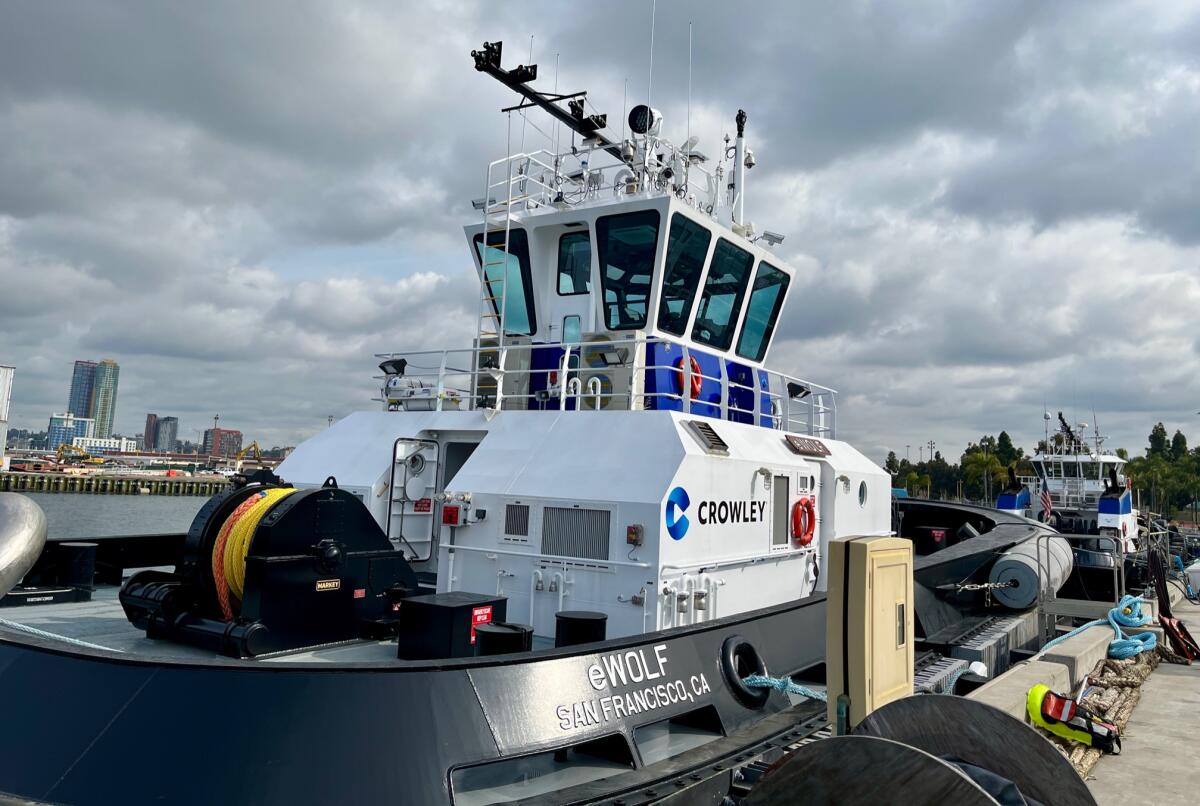
The 82-foot eWolf expects to eliminate 3,100 metric tons of carbon dioxide
- Show more sharing options
- Copy Link URL Copied!
The nation’s first all-electric tug boat has docked at the Port of San Diego and expects to begin emissions-free operations in about a month.
Operated by Crowley Maritime Corporation , the 82-foot eWolf will escort ships entering and leaving the Tenth Avenue Marine Terminal using electric power instead of diesel fuel, helping slash greenhouse gas emissions at the port and its neighbors in Barrio Logan and National City.
For the record:
1:58 p.m. March 13, 2024 This story has been updated to show the correct amount of government funding that went to the project.
“This is a big deal,” said port chairman Frank Urtasun at a news conference Monday. “This is new technology.”
Capable of speeds of up to 12 knots, the eWolf is powered by a 6.2 megawatt-hour main propulsion battery and two electric drives. The tug has thrust — also known as bollard pull in the parlance of the shipping industry — of 76.8 short tons, which is more powerful than the diesel-powered counterparts at the port.
Constructed in Alabama, the eWolf is equipped with two small generators for emergency use that allow the boat to travel longer distances at a reduced speed.
“Like an electric car, you step on the gas and it jumps,” said Paul Manzi, vice president of Crowley Shipping, based in Jacksonville, Fla. “All of the attributes that you have with an electric motor operation in a car or in an electric truck, you see here in the (eWolf) at massive scale. And it’s extremely quiet so when it pulls away from the dock you literally won’t hear any noise.”
The tug boat’s electricity will come from a charging station that is part of a microgrid facility equipped with two energy storage containers. Battery modules in each container have storage capacity of nearly 1.5 megawatt-hours.
Interconnected with the help of San Diego Gas & Electric, the charging station at the port is designed to allow the vessel to recharge quickly and reduce peak loads on the electric grid.
Operators plan to charge the eWolf overnight so it can perform its chores during daytime hours.
“This technology has individually been around for a while, but it hasn’t necessarily been integrated and optimized to all work together — and that’s kind of our role,” said Bruce Strupp, vice president at ABB Marine & Ports , the company that designed the boat’s propulsion system. “Some of the technology is our technology, some of it’s third-party technology, but we integrate it all together.”
The electric tug boat is expected to begin commercial operations at the port in mid- to late-April, depending on the completion of the charging station.

Officials at Crowley did not release the eWolf’s price tag Monday, saying only that it cost about twice as much as a conventional diesel-powered tug boat of comparable size.
But, Manzi said, the company expects the eWolf’s maintenance and operating costs will be “dramatically lower” than what’s spent on a diesel-powered tug boat because the electric model has fewer moving parts.
The entire project — the vessel as well as the charging station — received four grants that added up to $13.67 million, with two grants of $10.9 million from the San Diego Air Pollution Control District, one grant of just over $2 million from the U.S. Environmental Protection Agency and $750,000 from the federal government’s Maritime Administration.
In 2020, Gov. Gavin Newsom signed an executive order that directed state agencies to transition off-road vehicles — including tug boats — and equipment to 100 percent zero emissions by 2035.
By replacing one of the port’s diesel-powered tugs, the eWolf is expected to eliminate the consumption of about 35,000 gallons of diesel fuel per year. In its first 10 years of use, the electric tug boat is expected to reduce about 3,100 metric tons of carbon dioxide from the port and its surrounding areas such as Barrio Logan and National City.
“We’re trying to be good neighbors and trying to be able to help to reduce emissions here to help the electrification movement,” Urtasun said, adding that the port has spent about $130 million on various electrification projects.
Last year, the Port of San Diego became the first in North America to install a pair of all-electric cranes to load and off-load heavy cargo. Each 262 feet high, the cranes replaced an older crane that ran on diesel fuel. Together, the cranes expect to help the port reduce greenhouse gas emissions by 47 metric tons per year.
Get U-T Business in your inbox on Mondays
Get ready for your week with the week’s top business stories from San Diego and California, in your inbox Monday mornings.
You may occasionally receive promotional content from the San Diego Union-Tribune.

More from this Author
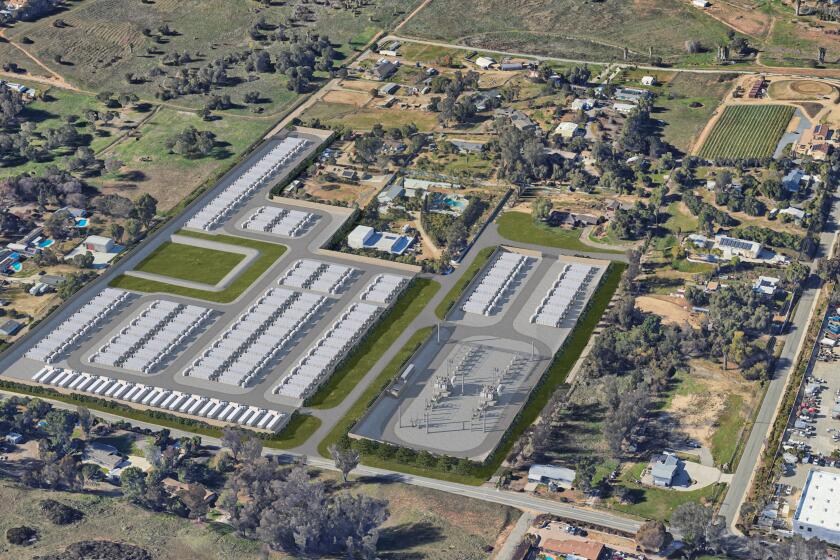
Why this battery storage plant between Escondido and San Marcos has some residents upset
March 29, 2024
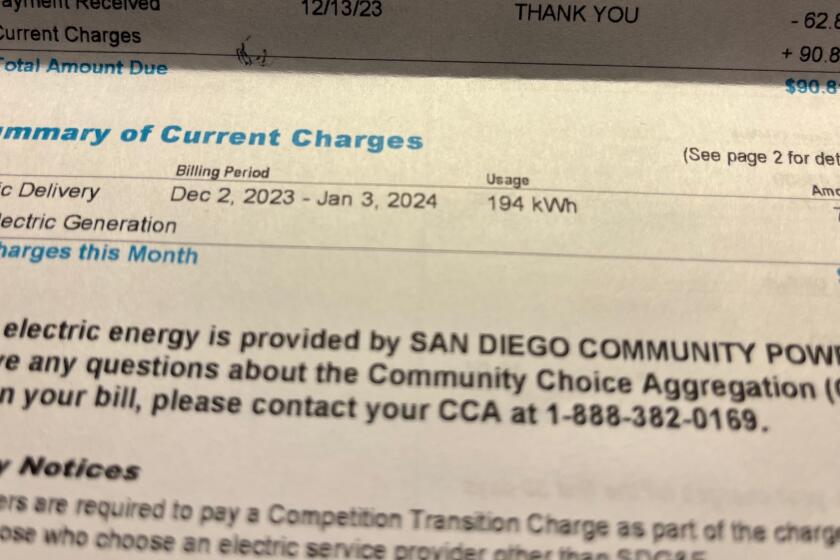
Is a $24 fixed, monthly charge on SDG&E utility bills coming your way?
March 28, 2024
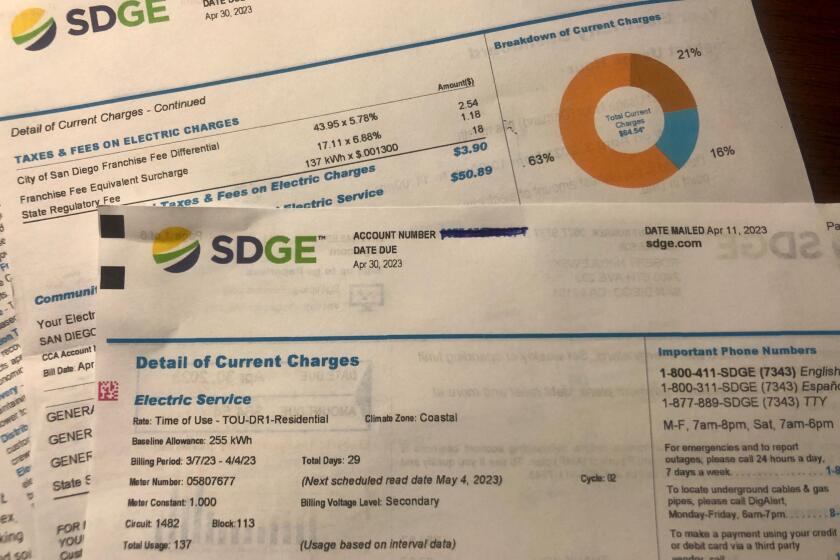
SDG&E customers will get credits on their bill next month as part of a state program
March 26, 2024
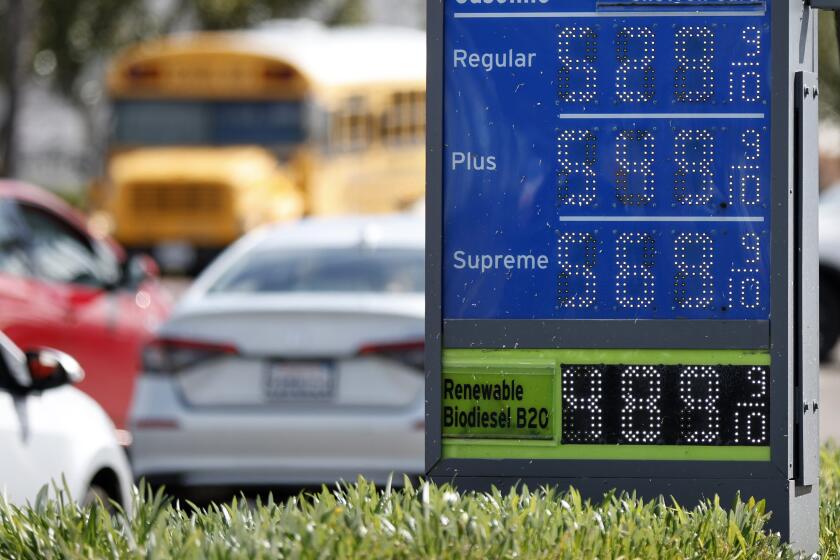
Here’s why San Diego gas prices are going up again
March 25, 2024
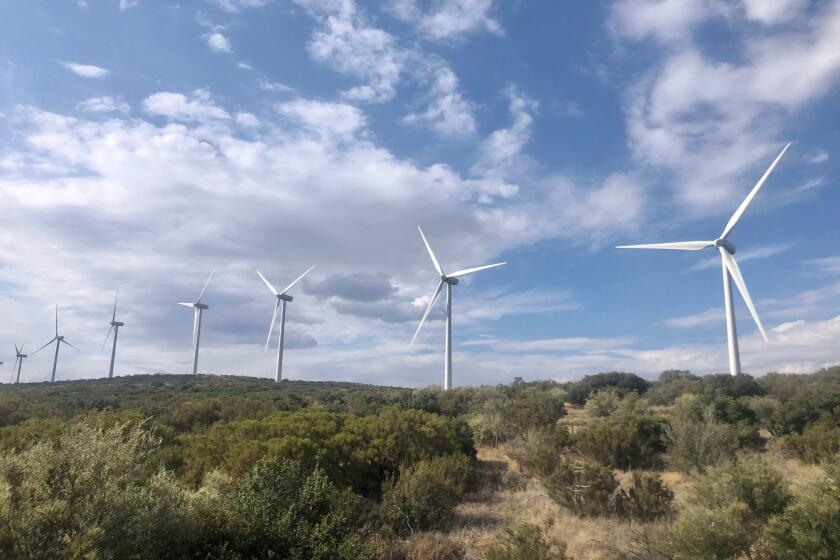
Wind project in San Diego’s backcountry runs into turbulence
March 22, 2024
More in this section
National Business
US probes complaints that Ford pickups can downshift without warning, increasing the risk of a crash
U.S. auto safety regulators are investigating complaints that more than 540,000 Ford pickup trucks can abruptly downshift to a lower gear and increase the risk of a crash

The Texas attorney general is investigating a key Boeing supplier and asking about diversity
The Texas attorney general says he’s investigating a key Boeing supplier that is already under scrutiny by federal regulators over the quality of its work on Boeing planes

Powell says Fed wants to see ‘more good inflation readings’ before it can cut rates
Federal Reserve Chair Jerome Powell reiterated a message he has sounded in recent weeks: While the Fed expects to cut interest rates this year, it won’t be ready to do so until it sees “more good inflation readings’’ and is more confident that annual price increases are falling toward its 2% target

Wrexham takes step closer to promotion with win over Mansfield
Wrexham, the fourth-tier Welsh team co-owned by actor Ryan Reynolds, has taken a step toward another promotion by beating Mansfield 2-0
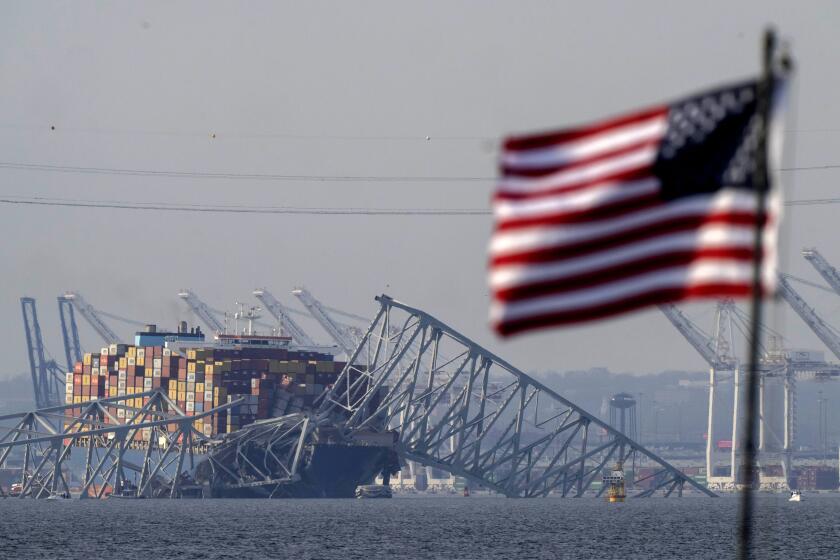
Could tugboats have helped avert the bridge collapse tragedy in Baltimore?
Tugboats were not escorting the massive cargo ship Dali when it lost power in the Port of Baltimore and slammed into the Francis Scott Key Bridge, toppling the span and killing six people

What stores are open on Easter Sunday 2024? See Walmart, Target, Costco hours
Don’t count on a favorite store being open on Easter Sunday
super yacht viva

The Stunning Ritz Carlton EVRIMA Yacht
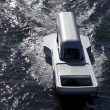
Gliding Across Tokyo’s Sumida River: The Mesmerizing Zipper Boat
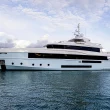
CROCUS Yacht: An 48 Meter Beauty by Admiral
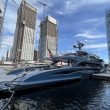
PHI Yacht – Royal Huisman’s $45 Million Superyacht
- Zuretti Interior Design
- Zuretti Interior
- Zuccon International Project
- Ziyad al Manaseer
- Zaniz Interiors. Kutayba Alghanim
- Yuriy Kosiuk
- Yuri Milner
- Yersin Yacht
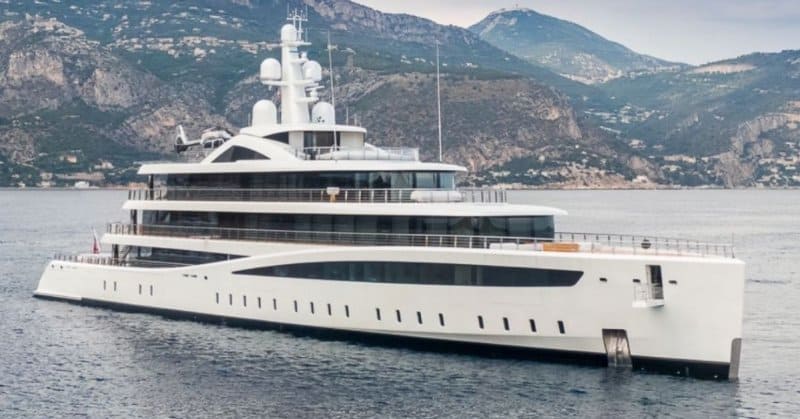
- Superyachts
VIVA Yacht – Incredible $175 Million Superyacht
VIVA yacht is a masterpiece built by the renowned Feadship De Voogt Naval Architects , a Netherlands-based yacht designer, in their Kaag shipyard.
She was built in 2021 and is considered one of the largest motor yachts in the world that can accommodate up to 14 guests in luxurious comfort and 18 crew for excellent service.
This majestic 308-foot superyacht is considered to be the first in a line of future luxury yachts that also focus on significantly reducing its carbon footprint by running on diesel-electric power.
According to the AIS data , she is currently sailing under the flag of the Cayman Islands.
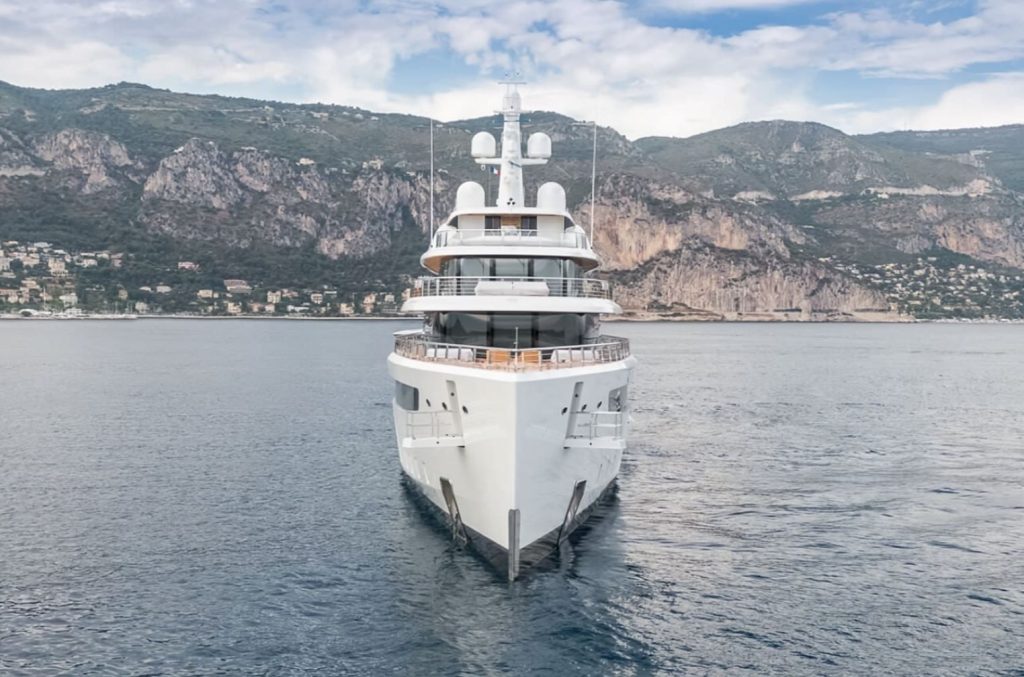
VIVA yacht interior
The VIVA yacht is a luxury yacht with an emphasis on environmentalism. Her design was penned by Peter Marino featuring “great edifices” of glass, including floor-to-ceiling windows that allow for natural light and ventilation throughout the interior spaces.
Marino’s theme for this superyacht is an open beach house style with a touch of minimalism clearly shown in the design’s abundance of clean lines.
She boasts of a movie theatre, beauty salon, underwater lights, elevator, beach club, gym, and air conditioning for the guests’ enjoyment.
She features an exterior design by Azure Yacht Design & Naval Architecture with an aluminum superstructure and teak decks for a classic look.
The superyacht’s exterior is created with a modern, minimalistic design in a special pearl-white livery.
The clean lines and abundance of glass draw attention from all who see it as she sails across blue waters.
Her hull is built to be as efficient as possible, reducing the engine power required to sail through the waters.
Additionally, she features the largest tender and the longest hull doors ever seen on a Feadship.

VIVA Yacht specifications
The VIVA yacht is a stunning 94-meter-long luxury yacht with an incredible 13.6m beam and a volume of 2999 gross tonnage, making it one of the largest yachts in its class.
Her water tanks can store around 71,000 liters of fresh water that the guests can use.
The yacht is powered by twin MTU engines with a maximum speed of 20 knots, a cruising speed of 12 knots, and a range that extends over 5k nautical miles. She is also equipped with at-anchor stabilizers to provide exceptional comfort levels.
She is hailed as the most environmentally-friendly luxury vessel of its kind because of her eco-friendly waste treatment plant and heat recovery systems on board.
She has been installed with an exceptionally advanced hybrid propulsion system to keep the environmental impact at around the same levels as his previous Feadship, despite that being 32 meters shorter in length.
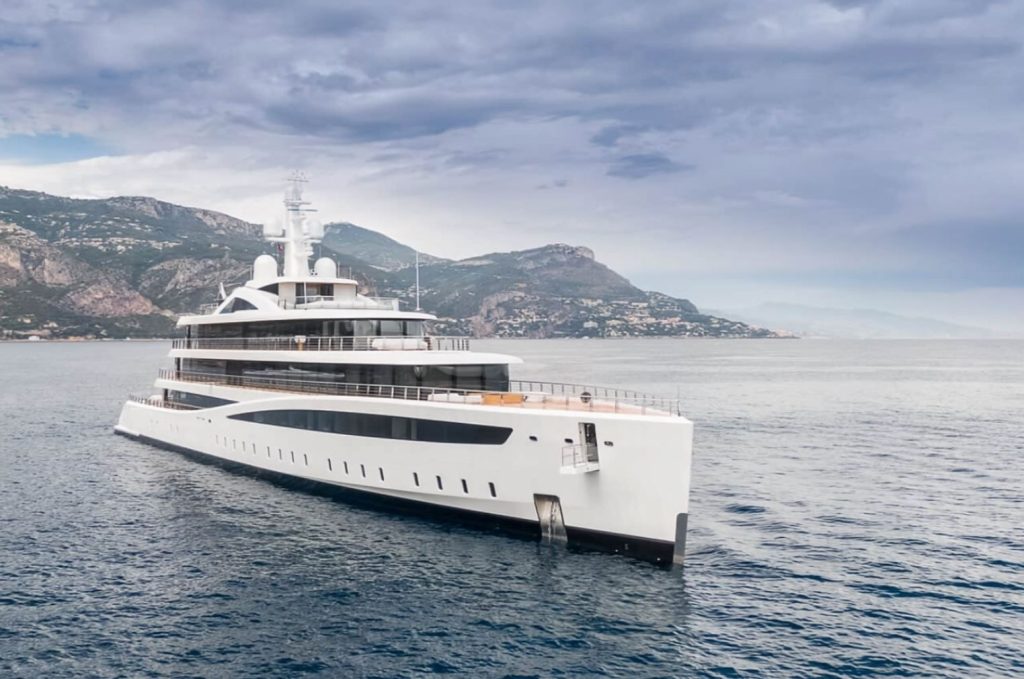
VIVA yacht price
Her price is $175 million and her annual running cost is at around US$ 17.5 million yearly. She is currently not believed to be for sale nor available for private charter.

As a private yacht, little is known about her owner who is a billionaire and features his initials on the helicopter register N702FF.
VIVA yacht summary
VIVA yacht is a remarkable masterpiece built by Feadship De Voogt Naval Architects, showcasing luxury and environmental consciousness.
With its sleek design and innovative diesel-electric power system, it stands as one of the largest and most eco-friendly motor yachts in the world.
The interior, designed by Peter Marino, exudes a minimalist beach house style, offering a bright and inviting atmosphere for guests.
On the exterior, VIVA’s modern and minimalistic design, along with its efficient hull, captures attention as it sails across the waters.
With a price tag of $175 million, VIVA sets new standards for luxury and sustainability in the yachting industry, reflecting the owner’s commitment to excellence and environmental responsibility.
Do you have anything to add to this listing?
- Azure Yacht design & Naval Architecture
- Peter Marino
Love Yachts? Join us.
Related posts.
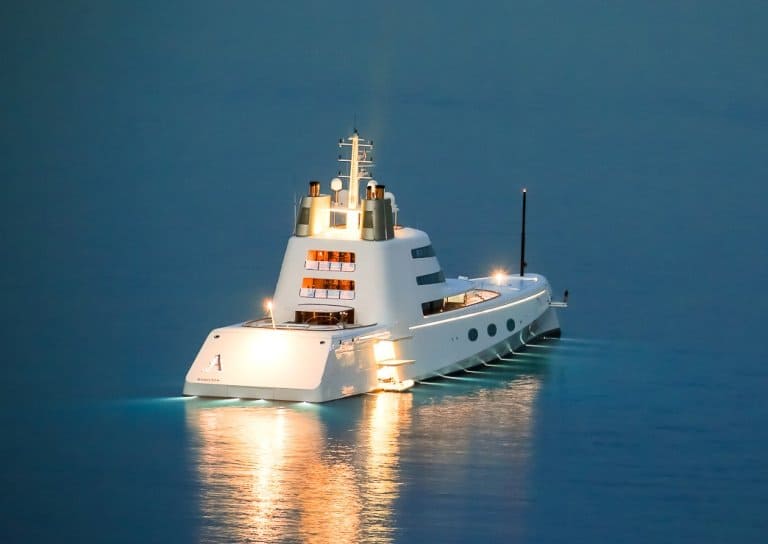
MOTOR YACHT A – Cutting-edge $300M Superyacht
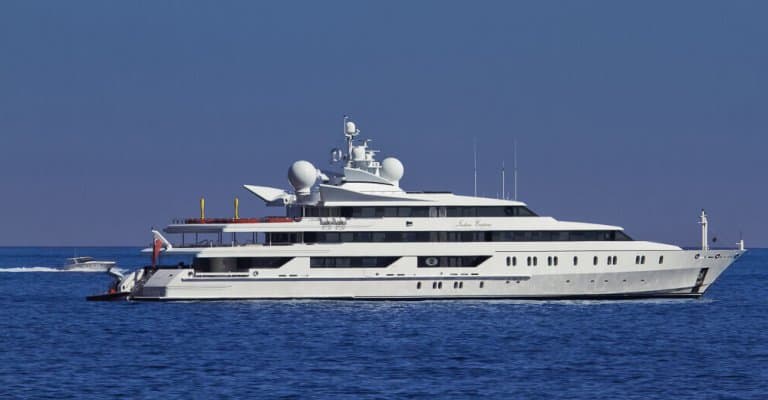

H Yacht – Extraordinary $150M Superyacht
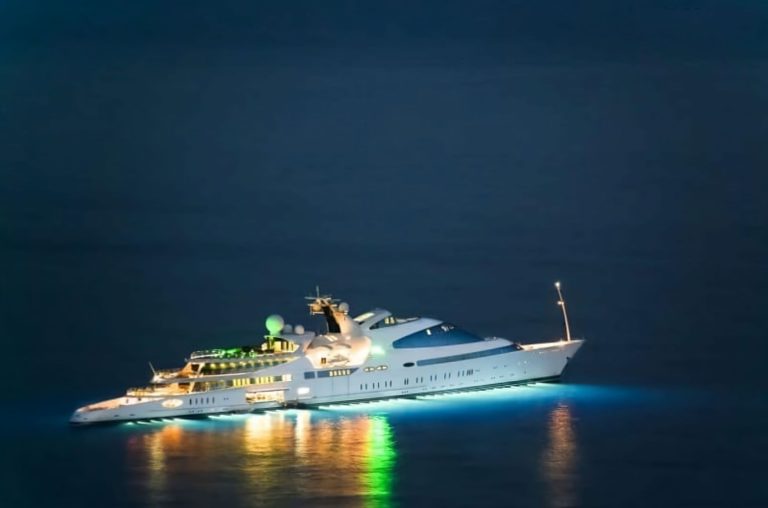
YAS Yacht – High-end $180M Superyacht
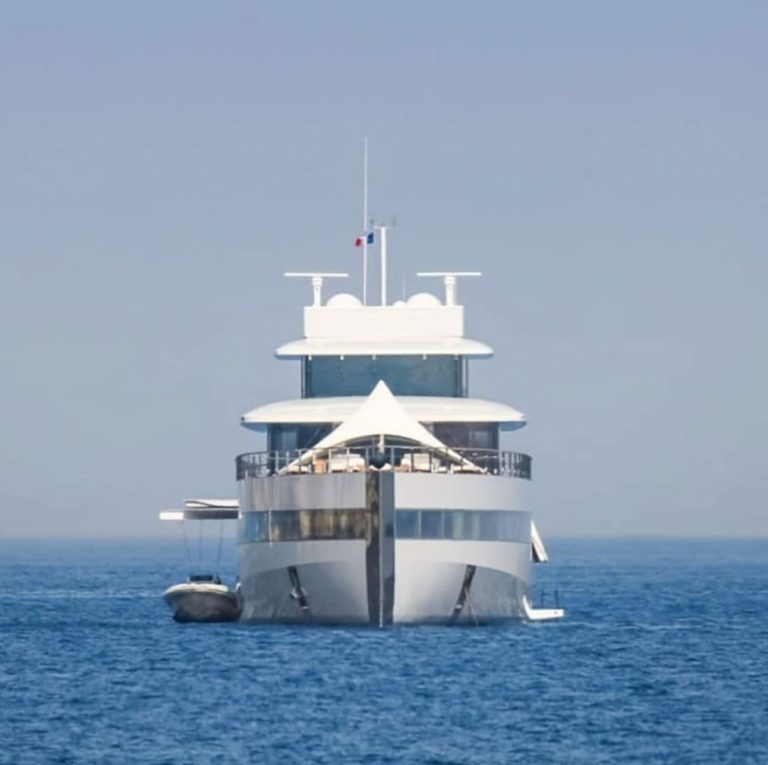
VENUS Yacht – Captivating $120M Superyacht
Please use a modern browser to view this website. Some elements might not work as expected when using Internet Explorer.
- Landing Page
- Luxury Yacht Vacation Types
- Corporate Yacht Charter
- Tailor Made Vacations
- Luxury Exploration Vacations
- View All 3564
- Motor Yachts
- Sailing Yachts
- Classic Yachts
- Catamaran Yachts
- Filter By Destination
- More Filters
- Latest Reviews
- Charter Special Offers
- Destination Guides
- Inspiration & Features
- Mediterranean Charter Yachts
- France Charter Yachts
- Italy Charter Yachts
- Croatia Charter Yachts
- Greece Charter Yachts
- Turkey Charter Yachts
- Bahamas Charter Yachts
- Caribbean Charter Yachts
- Australia Charter Yachts
- Thailand Charter Yachts
- Dubai Charter Yachts
- Destination News
- New To Fleet
- Charter Fleet Updates
- Special Offers
- Industry News
- Yacht Shows
- Corporate Charter
- Finding a Yacht Broker
- Charter Preferences
- Questions & Answers
- Add my yacht
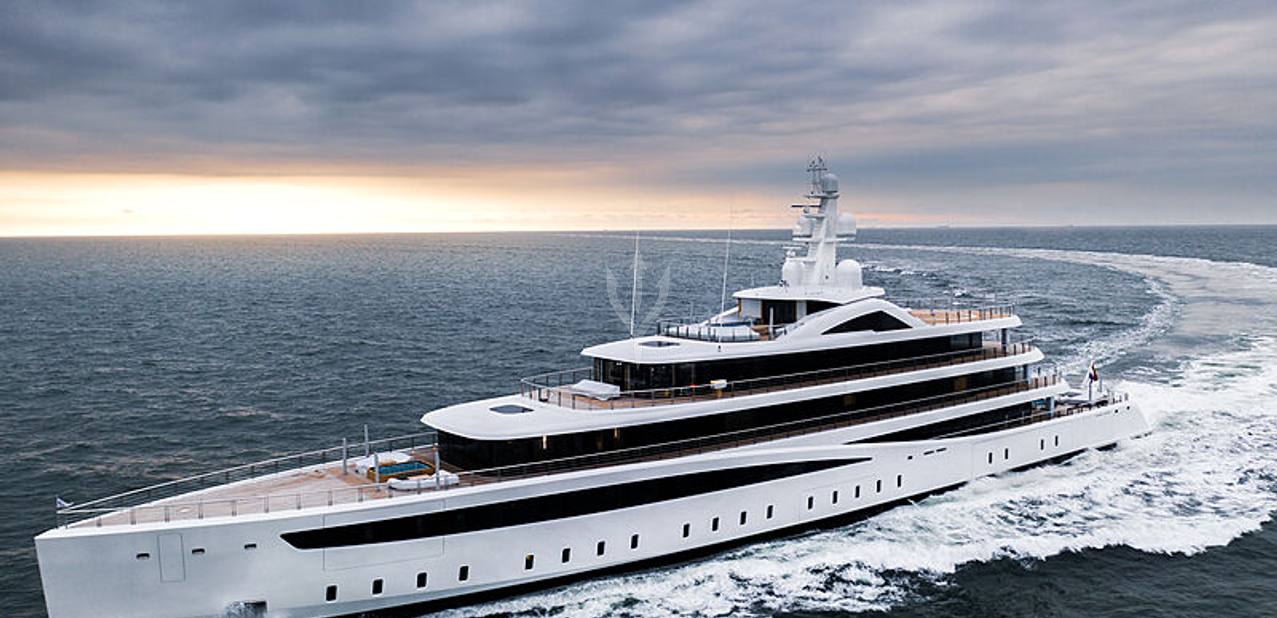
NOT FOR CHARTER *
This Yacht is not for Charter*
SIMILAR YACHTS FOR CHARTER
View Similar Yachts
Or View All luxury yachts for charter
- Luxury Charter Yachts
- Motor Yachts for Charter
- Amenities & Toys
VIVA yacht NOT for charter*
94m / 308'5 | feadship | 2021.
Owner & Guests
- Previous Yacht
Special Features:
- Elevator for convenient access
- Multi-award winning
- Comfortable Movie Theatre
- Inviting pool
- Lloyds Register ✠ 100A1 SSC Yacht, Mono, G6 ✠ LMC, UMS classification
The multi-award winning 94m/308'5" motor yacht 'Viva' was built by Feadship in the Netherlands at their Kaag shipyard. Her interior is styled by design house Peter Marino and she was delivered to her owner in June 2021. This luxury vessel's exterior design is the work of Azure Yacht Design.
Guest Accommodation
Viva has been designed to comfortably accommodate up to 16 guests in 8 suites. She is also capable of carrying up to 38 crew onboard to ensure a relaxed luxury yacht experience.
Onboard Comfort & Entertainment
Her features include a movie theatre, beauty salon, elevator, underwater lights, beach club, gym and air conditioning.
Range & Performance
Viva is built with a steel hull and aluminium superstructure, with teak decks. Powered by twin diesel-electric MTU (16V 4000 M73L) 16-cylinder 3,916hp engines running at 2050rpm, she comfortably cruises at 12 knots, reaches a maximum speed of 20 knots. Viva features at-anchor stabilizers providing exceptional comfort levels. Her water tanks store around 71,000 Litres of fresh water. She was built to Lloyds Register ✠ 100A1 SSC Yacht, Mono, G6 ✠ LMC, UMS classification society rules.
*Charter Viva Motor Yacht
Motor yacht Viva is currently not believed to be available for private Charter. To view similar yachts for charter , or contact your Yacht Charter Broker for information about renting a luxury charter yacht.
Viva Yacht Owner, Captain or marketing company
'Yacht Charter Fleet' is a free information service, if your yacht is available for charter please contact us with details and photos and we will update our records.
Viva Photos
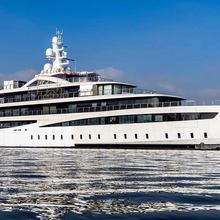
Viva Awards & Nominations
- The World Superyacht Awards 2022 Best Displacement Motor Yacht of 2,000GT and above Winner
- The World Superyacht Awards 2022 Motor Yacht of the Year Winner
- Boat International Design & Innovation Awards 2022 Outstanding Exterior Motor Yacht Design - 60m and above Winner
NOTE to U.S. Customs & Border Protection
Specification
M/Y Viva
SIMILAR LUXURY YACHTS FOR CHARTER
Here are a selection of superyachts which are similar to Viva yacht which are believed to be available for charter. To view all similar luxury charter yachts click on the button below.
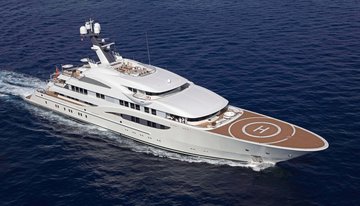
85m | Lurssen
from $0 p/week ♦︎
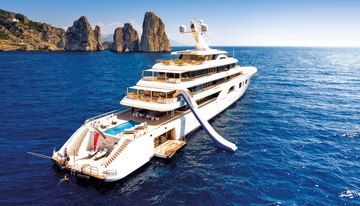
92m | Feadship
from $1,500,000 p/week
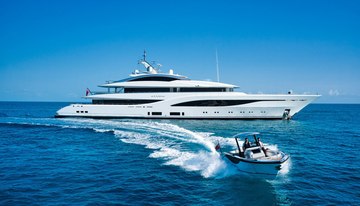
75m | Feadship
from $900,000 p/week *
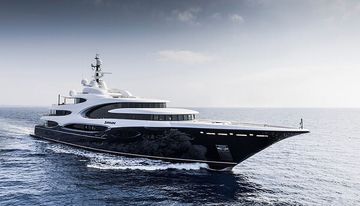
89m | Oceanco
from $1,100,000 p/week

90m | Oceanco
from $1,300,000 p/week ♦︎
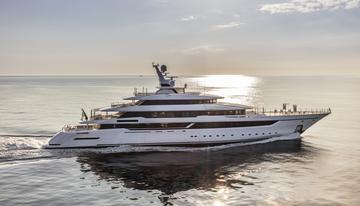
80m | Columbus Yachts
from $921,000 p/week ♦︎

80m | Yachtley
from $867,000 p/week ♦︎
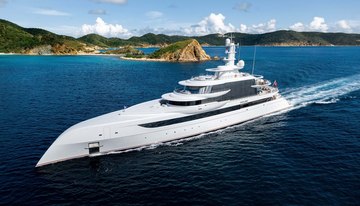
80m | Abeking & Rasmussen
from $1,150,000 p/week
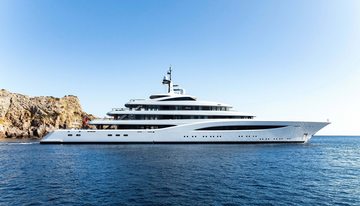
97m | Feadship
from $1,733,000 p/week ♦︎
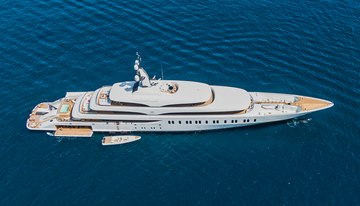
108m | Benetti
from $1,950,000 p/week ♦︎
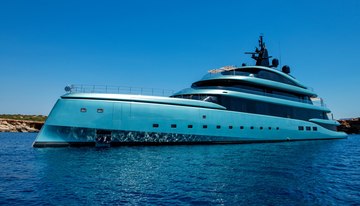
75m | Admiral Yachts
from $975,000 p/week ♦︎

93m | Feadship
from $1,517,000 p/week ♦︎
As Featured In
The YachtCharterFleet Difference
YachtCharterFleet makes it easy to find the yacht charter vacation that is right for you. We combine thousands of yacht listings with local destination information, sample itineraries and experiences to deliver the world's most comprehensive yacht charter website.
San Francisco
- Like us on Facebook
- Follow us on Twitter
- Follow us on Instagram
- Find us on LinkedIn
- Add My Yacht
- Affiliates & Partners
Popular Destinations & Events
- St Tropez Yacht Charter
- Monaco Yacht Charter
- St Barts Yacht Charter
- Greece Yacht Charter
- Mykonos Yacht Charter
- Caribbean Yacht Charter
Featured Charter Yachts
- Maltese Falcon Yacht Charter
- Wheels Yacht Charter
- Victorious Yacht Charter
- Andrea Yacht Charter
- Titania Yacht Charter
- Ahpo Yacht Charter
Receive our latest offers, trends and stories direct to your inbox.
Please enter a valid e-mail.
Thanks for subscribing.
Search for Yachts, Destinations, Events, News... everything related to Luxury Yachts for Charter.
Yachts in your shortlist

The global authority in superyachting
- NEWSLETTERS
- Yachts Home
- The Superyacht Directory
- Yacht Reports
- Brokerage News
- The largest yachts in the world
- The Register
- Yacht Advice
- Yacht Design
- 12m to 24m yachts
- Monaco Yacht Show
- Builder Directory
- Designer Directory
- Interior Design Directory
- Naval Architect Directory
- Yachts for sale home
- Motor yachts
- Sailing yachts
- Explorer yachts
- Classic yachts
- Sale Broker Directory
- Charter Home
- Yachts for Charter
- Charter Destinations
- Charter Broker Directory
- Destinations Home
- Mediterranean
- South Pacific
- Rest of the World
- Boat Life Home
- Owners' Experiences
- Interiors Suppliers
- Owners' Club
- Captains' Club
- BOAT Showcase
- Boat Presents
- Events Home
- World Superyacht Awards
- Superyacht Design Festival
- Design and Innovation Awards
- Young Designer of the Year Award
- Artistry and Craft Awards
- Explorer Yachts Summit
- Ocean Talks
- The Ocean Awards
- BOAT Connect
- Between the bays
- Golf Invitational
- Boat Pro Home
- Pricing Plan
- Superyacht Insight
- Product Features
- Premium Content
- Testimonials
- Global Order Book
- Tenders & Equipment

Specifications
- Yacht Type: Motor Yacht
- Yacht Subtype: Displacement
- Builder: Feadship
- Naval Architect: Feadship De Voogt Naval Architects
- Exterior Designer: Azure Yacht Design and Naval Architecture , Studio De Voogt
- Interior Designer: Peter Marino
Yacht featured in
Yachts like this, from our partners, sponsored listings.
- Super Yachts
- The Billionaires Club

- Favorites 0

Description
Similar listings.
- WhatsApp Facebook Twitter Pinterest Linkedin Email
M/Y VIVA 94m Super Yacht by Feadship
- €200,000,000
- Property ID
✨ Viva: A Maritime Symphony of Opulence 🚢🌟
Embark on a voyage of luxury aboard the magnificent superyacht Viva, a true masterpiece born from the skilled hands of Feadship in 2021. Let’s delve deeper into the opulent world that this 94m nautical wonder, owned by the illustrious billionaire Frank Fertitta, unfolds.
🌐 Design & Craftsmanship:
- Crafted by Feadship, a Dutch yacht-building legend 🇳🇱
- Azure Yacht Design & Naval Architecture’s exterior allure 🎨
- Interior elegance curated by Peter Marino 🛋️
🚀 Technical Marvels:
- Powered by cutting-edge MTU engines 🚤
- Maximum speed of 20 knots for swift journeys 🌊
- Impressive range of over 5,000 nautical miles ⚓
🛏️ Luxurious Living:
- Accommodates up to 14 guests in lavish quarters 🛏️
- A dedicated crew of 18 ensures seamless service 💼
👨💼 Ownership & Legacy:
- Proudly owned by Frank Fertitta, the visionary billionaire 💰
- Personalized touch with helicopter N702FF, a nod to Fertitta’s initials 🚁
🔱 Feadship Excellence:
- Founded in 1949, Feadship is synonymous with Dutch yachting excellence 🌐
- Custom-built luxury ranging from 40m to over 100m 🏆
🌍 Current Status & Locations:
- Track Viva’s real-time location as it graces different waters 📍
- Currently anchored in Turkish waters, showcasing the yacht’s global exploration 🌍
🔒 Security & Privacy:
- Ensured by advanced technology, making Viva a secure haven ⚔️
- Reflects Fertitta’s commitment to privacy in every ocean crossing 🌊
🔥 Financial Prowess:
- Viva’s cost price: $175 million, reflecting Frank Fertitta’s dedication to yachting excellence 💸
- Annual running costs approximately $18 million, ensuring top-notch maintenance 🛠️
- Frank Fertitta boasts a substantial net worth of $2.8 billion, accumulated through successful business endeavors.
2. Residence:
- His primary residence is in Las Vegas, a city synonymous with entertainment, luxury, and high-stakes ventures.
3. Private Jet:
- Frank Fertitta owns a Bombardier Global 7500 private jet with the registration N762F. The Bombardier Global 7500 is known for its long range and luxurious amenities.
4. Superyacht VIVA 94m:
- The crown jewel of Fertitta’s maritime pursuits is the superyacht Viva, a 94-meter vessel crafted by Feadship in 2021. Viva represents the epitome of luxury and sophistication on the high seas.
5. Source of Wealth:
- Fertitta’s wealth is derived from various sources, including his involvement in the UFC (Ultimate Fighting Championship) and Station Casinos.
6. UFC (Ultimate Fighting Championship):
- Fertitta is a key figure in the world of mixed martial arts, having been involved in the UFC. The UFC is a premier organization in the sport, contributing significantly to Fertitta’s wealth.
7. Station Casinos:
- Fertitta has interests in Station Casinos, a chain of hotel and casinos in the Las Vegas area. His involvement in the gaming and hospitality industry has been a lucrative venture.
🛳️ Feadship Legacy:
- Feadship’s portfolio includes iconic yachts like Anna, SYMPHONY, and Faith 🏆
- Continues to be the choice of discerning yacht owners worldwide 🌎
⚓ Unveiling Nautical Luxury: #VivaYacht #LuxuryLifestyle #YachtingElegance #FeadshipExcellence 🌊✨
Embark on a visual journey by swiping through breathtaking images of Viva’s interiors, exteriors, and mesmerizing ocean views. Each photo captures the essence of Viva’s opulence, making it a timeless addition to the world of luxury yachting. 📸✨
M/Y VIVA at the Monaco Yacht Show 2021
2021 The latest yacht to be completed by Feadship, Viva is a state-of-the-art hybrid superyacht that is capable of cruising up to 12 knots under green power. Viva’s hull sides have been finished in a special pearl-white finish for a glistening effect in the sunlight.
Superyacht Viva: A Marvel of Elegance and Efficiency
1. Anchored Elegance:
- Witness the breathtaking presence of the 94-meter superyacht Viva as she gracefully anchors off the Lerins Islands in the South of France. Her majestic silhouette reflects the epitome of maritime luxury.
2. Feadship Craftsmanship:
- Crafted with precision and artistry, Viva was built and launched in February 2021 at the esteemed Dutch shipyard Feadship in Kaag, the Netherlands. Feadship’s legacy of excellence is evident in every detail of this extraordinary vessel.
3. Project 817 Unveiled:
- Formerly known as Project 817, Viva emerges as one of the largest superyachts to be launched by Feadship. This nautical masterpiece is the collaborative design work of Azure Yacht Design and Feadship’s Studio De Voogt.
4. Peter Marino’s Interior Brilliance:
- The interior of Viva is a testament to the brilliance of Peter Marino’s design studio. Described as a beach house by the builder, the yacht’s interior resonates with the owner’s ‘less is more’ philosophy, showcasing clean lines and uncluttered elegance.
5. Natural Light Abundance:
- A standout feature of Viva is the curved floor-to-ceiling windows adorning both upper decks. These architectural marvels flood the interior with an abundance of natural light, creating a serene and inviting atmosphere.
6. Hybrid Propulsion Excellence:
- Viva is equipped with a state-of-the-art hybrid propulsion system, exemplifying efficiency and environmental consciousness. The yacht can cruise on diesel-electric power at a comfortable 12 knots, reaching an impressive 20 knots under diesel propulsion.
7. Owner’s Vision:
- The owner’s vision permeates every aspect of Viva’s design, emphasizing a harmonious blend of elegance, functionality, and efficiency. The ‘less is more’ philosophy extends beyond aesthetics to the vessel’s operational efficiency.
As Viva graces the waters with her presence, she stands as a symbol of maritime excellence, where craftsmanship, design, and technological innovation converge to create an unparalleled yachting experience. From the Lerins Islands to the open seas, Viva invites admiration for her timeless beauty and forward-thinking design. #SuperyachtViva #FeadshipExcellence #YachtingElegance #AzureYachtDesign #PeterMarinoDesign #HybridPropulsion #LuxuryAtSea #NauticalInnovation #FeadshipCraftsmanship
VIVA Superyacht departing the port of Gibraltar 31/1/2022
IMO: 9798246 Name: VIVA Vessel Type – Generic: Pleasure Craft Vessel Type – Detailed: Houseboat Status: Active MMSI: 319179500 Call Sign: ZGKK9 Flag: Cayman Is [KY] Gross Tonnage: 2999 Summer DWT: 401 t Length Overall x Breadth Extreme: 94 x 14 m Year Built: 2021
- Property ID: 129516
- Price: €200,000,000
- Property Type: FEADSHIP
- Property Status: Monaco Yacht Show, New Costruction, Sold
- Yacht Name: VIVA
- Ship Yard: Feadship
- Yacht Designer: Azure Yacht Design
- Naval Design: Exterior
- IMO: 9798246
- MSSI: 319179500
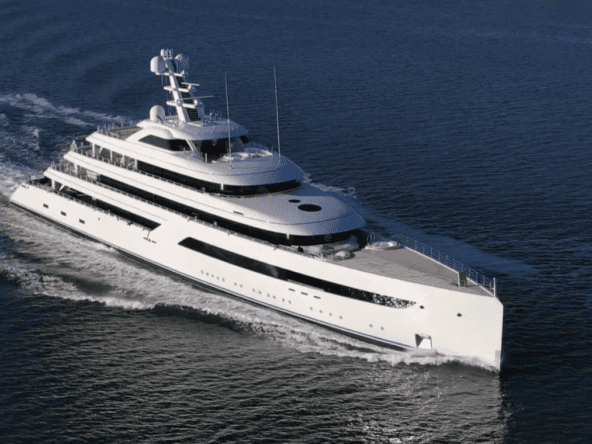
Project NB 1010 119m Super Yacht by Feadship
- €300,000,000
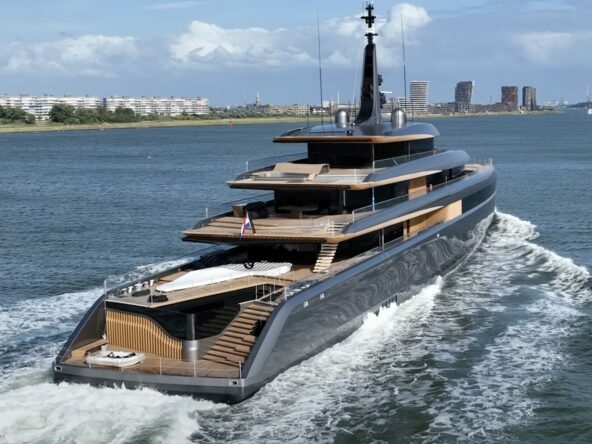
M/Y OBSIDIAN 84m Super Yacht by Feadship
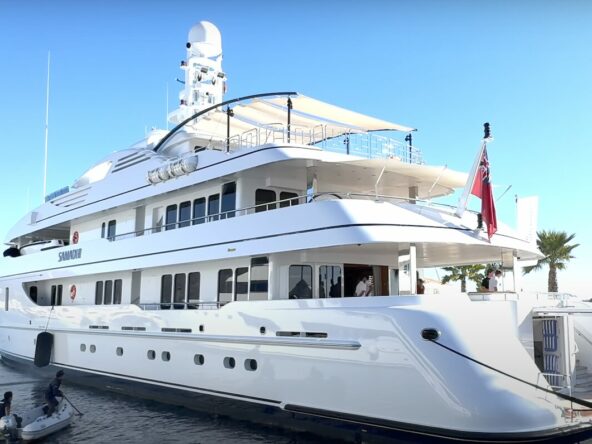
M/Y SAMADHI 50m Super Yacht by Feadship
- €45,000,000
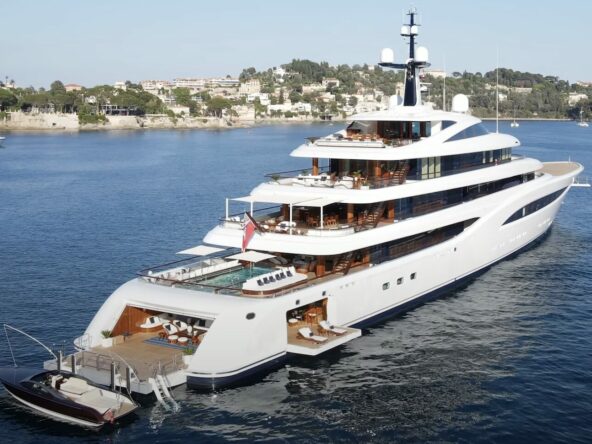
M/Y FAITH 97m Super yacht by Feadship
- €250,000,000
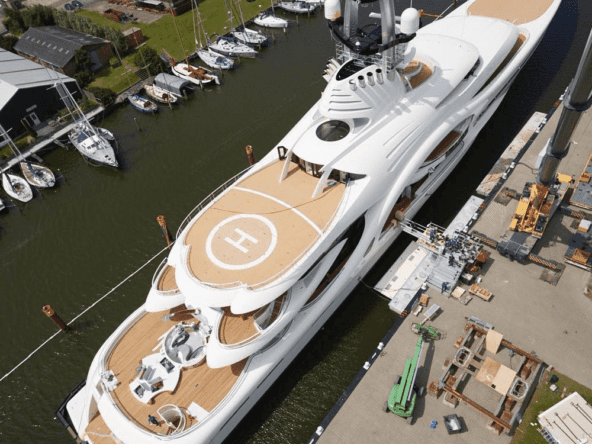
M/Y ANNA 110m Private Super Yacht by Feadship
- €230,000,000
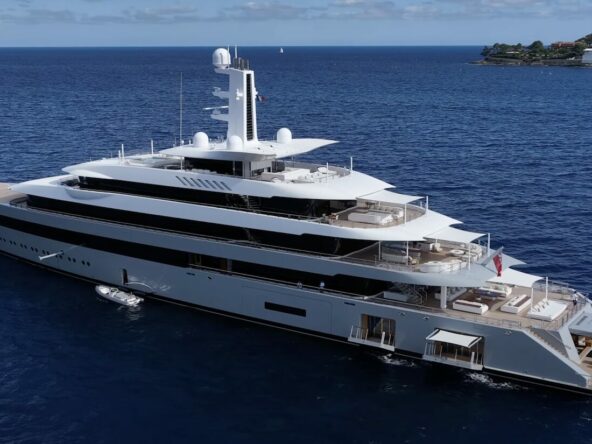
M/Y MOONRISE 99.95m Super yacht by Feadship
- €175,000,000
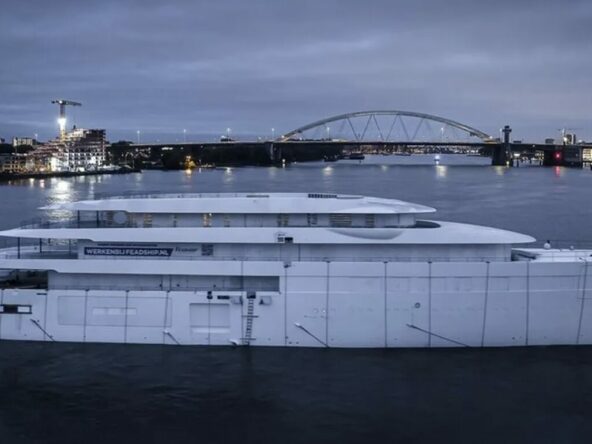
PROJECT 1013 101m Super Yacht by Feadship
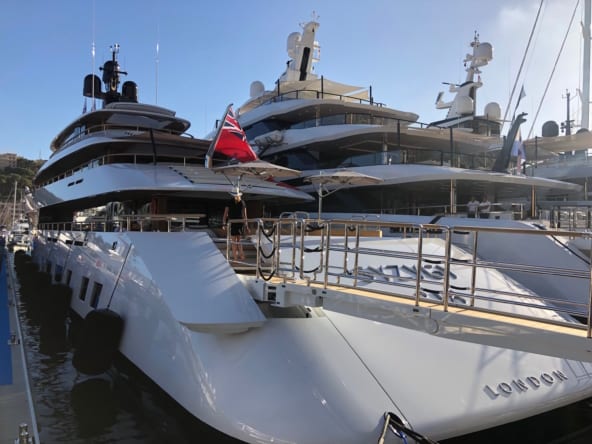
M/Y PI ex SYZYGY 818 a 77.25m Super Yacht by Feadship
- €130,000,000
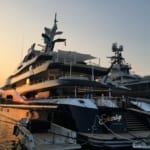
Compare listings
Reset Password
Please enter your username or email address. You will receive a link to create a new password via email.
- stefan katafai
- View Listings

- Share WhatsApp Facebook Twitter Pinterest Linkedin Email
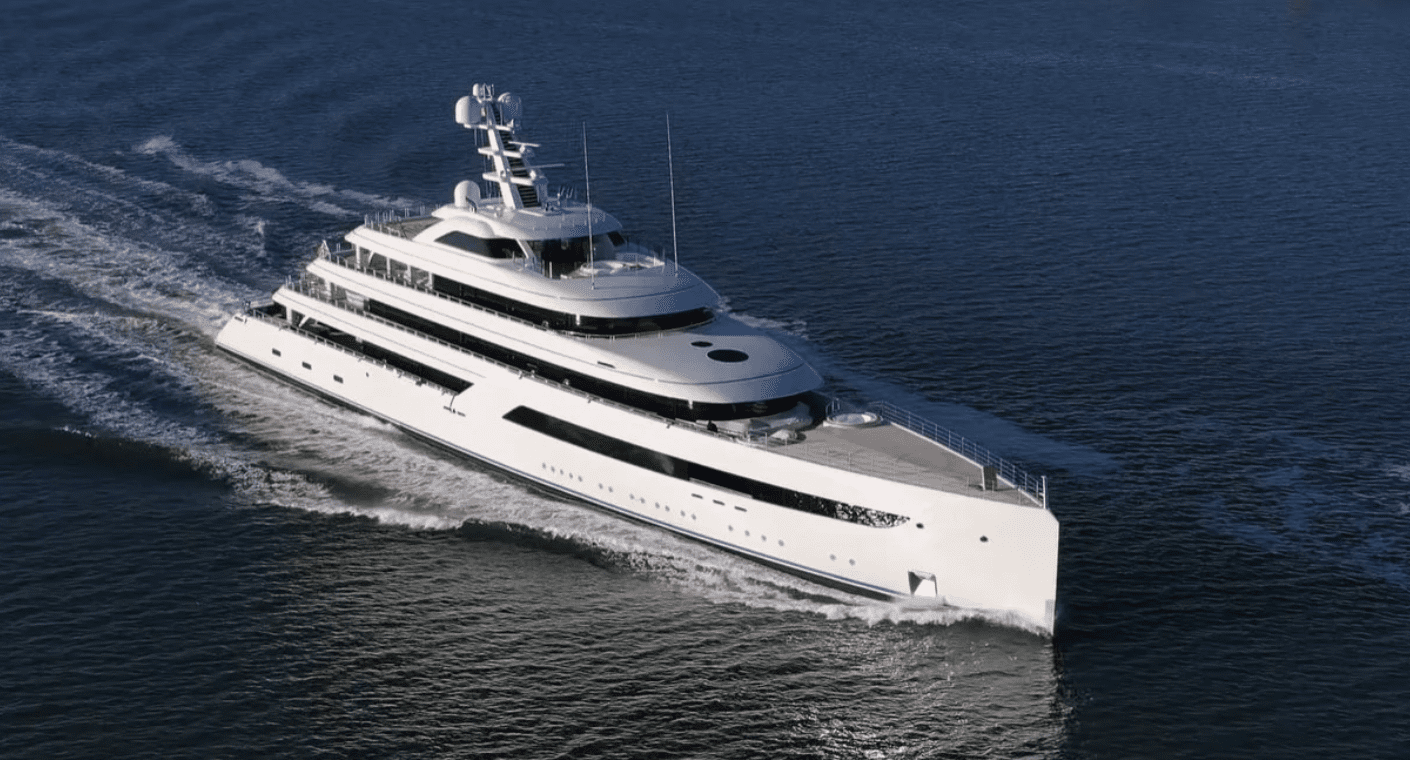
Join our Newsletter
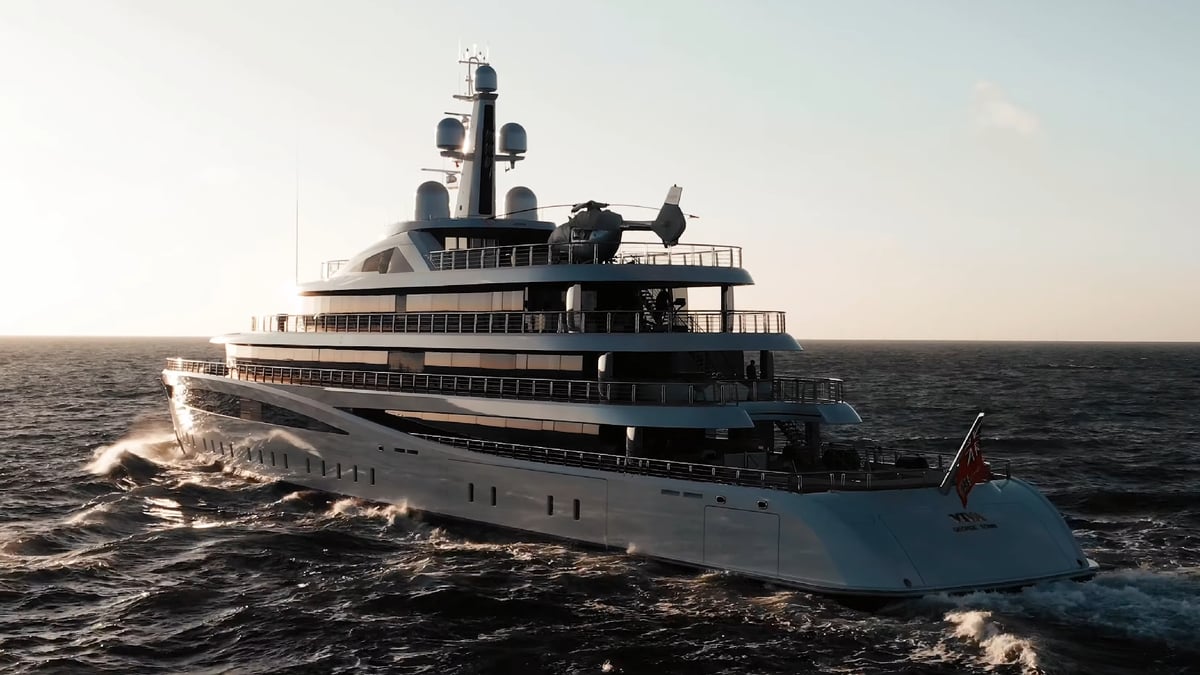
VIVA: The $250 Million Superyacht Of UFC Owner Frank Fertitta III

From his current position as CEO of Station Casinos to how he – alongside brother Lorenzo and childhood friend Dana White – transformed the UFC into a multi-billion-dollar promotion , there’s virtually endless information about how Frank Fertitta III made his fortune. How he chooses to spend said fortune, however, is a little more mysterious (at least for the fun stuff). One such indulgence we know the elder Fertitta brother has treated himself to is the ultra-luxurious Feadship-built superyacht known as Viva, which comes with an eye-watering price tag of US$175 million / AU$252 million.
Conceptualised by Azure Yacht Design & Naval Architecture in collaboration with De Voogt Naval Architects, while also showcasing interiors accomplished by Peter Marino, Viva was only completed in the Netherlands last year and delivered shortly thereafter.
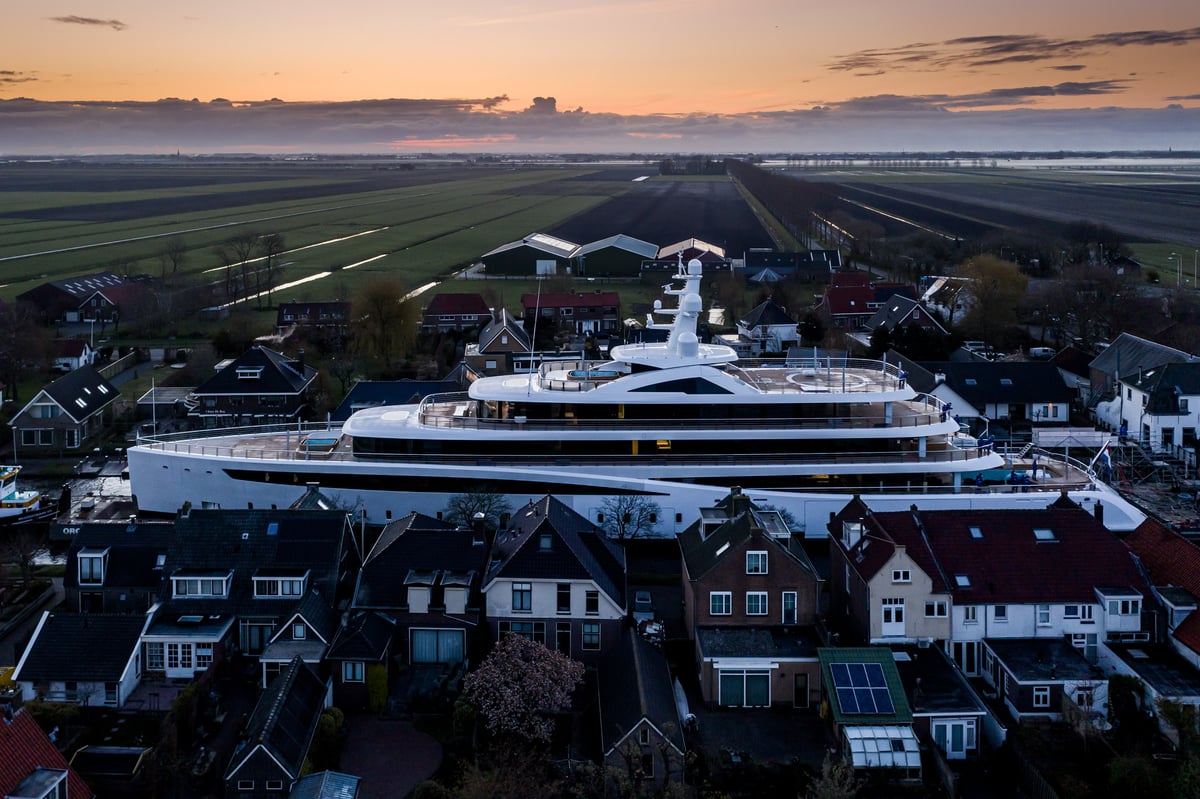
RELATED: Inside Lawrence Stroll’s $282 Million Superyacht ‘Faith’
Back to the matter of Viva, it boasts an overall length of 308 feet / 94 metres with a 13.6-metre beam and gross tonnage of 2,999 – making it the 85th largest superyacht in the entire world; seventh largest ever constructed by Feadship – and can comfortably accommodate 14 guests across seven cabins alongside a capable crew of 18.
Viva has been called the “most environmentally-friendly luxury vessel of its kind” due to it featuring a hybrid propulsion system that allows the boat to cruise using diesel-electric power, as well as a waste treatment plant and heat recovering systems.
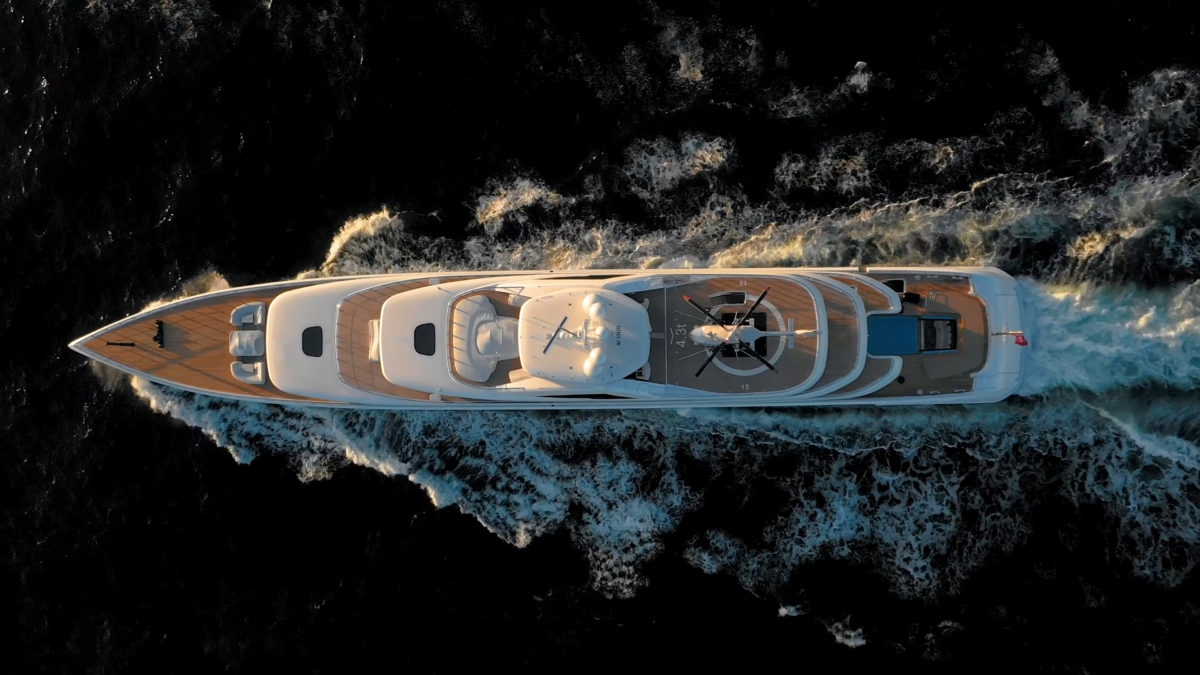
RELATED: Inside Aussie Rich Lister Ian Malouf’s Stunning €35 Million Superyacht Rebuild
- Formal dining area
- Beauty salon
- Helipad w/ helicopter registered as N702FF (believed to have been chosen for Frank’s initials)
Viva has a steel hull and aluminium superstructure.
The annual running cost of this enviable billionaire’s toy? Over US$17.5 million / AU$25 million.
Viva was last sighted en route to Martha’s Vineyard by way of Nantucket — but you can check it out for yourself via the Superyacht Times’ video below.
NOTE : As interior photos have yet to be released, the shots embedded are just samples.
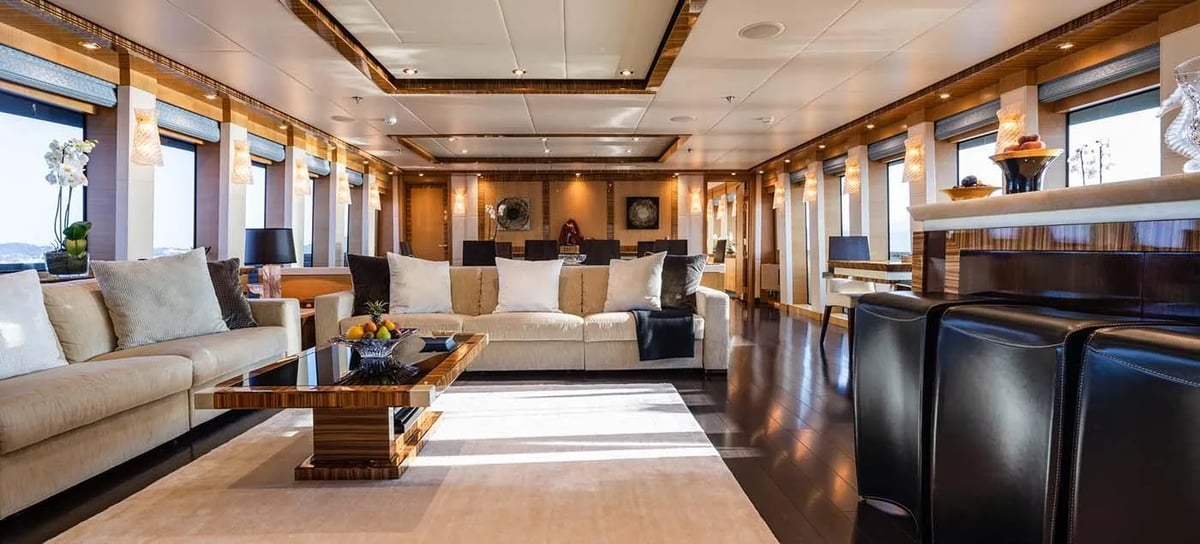
Share the article
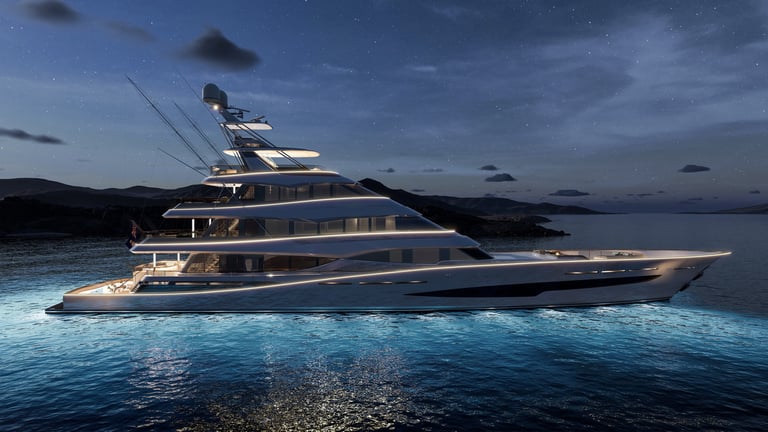
Royal Huisman’s Project 406 Is The World’s Largest Purpose-Built Fishing Boat

Ferrari Is Officially Entering The Yacht Game

Steven Spielberg Takes Delivery On His Cinematic $250 Million Superyacht

The 33-Metre Sanlorenzo SP110 ‘Steel It’ Motor Yacht Is A Jet-Powered Masterpiece

Conor McGregor Enjoyed The Monaco Grand Prix From His $5.5 Million Lamborghini Yacht
Related articles.

BMW Debuts ‘The Icon’ Boat With Soundscape Designed By Hans Zimmer

Step Inside The 75m Kenshō: 2023’s Motor Yacht Of The Year

Russian Superyacht’s Crew Spends Past Year Playing ‘Call Of Duty’ & Chilling By Pool

Superyacht Private Security Engaged In A Gun Battle With Pirates Off The Coast Of Yemen

The Feadship Project 710 Is 84m Of Sustainable Superyacht
$175 million superyacht viva moored off nantucket.
Jason Graziadei • Jul 06, 2022
If you’ve arrived or departed from the island by boat over the past few days, you couldn’t have missed the gargantuan visitor lurking just offshore.
The 308-foot superyacht Viva was moored off Nantucket earlier this week, just outside the jetties, as the massive vessel was too large to navigate into the harbor. It departed for Martha's Vineyard Wednesday night.
The $175 million Viva, which was built by Feadship in the Netherlands and completed just last year, features its own helicopter which has been spotted circling around the island this week. It is the 85th largest superyacht in the world, and is believed to be owned by billionaire Frank Fertitta III , the CEO of Station Casinos in Las Vegas and founder of Zuffa LLC, the parent company of the Ultimate Fighting Championship (UFC).
The yacht’s helicopter sports the tail number N702FF, which was believed to have been chosen for Fertitta’s initials.
"That's definitely one of the biggest vessels I've seen around Nantucket in my 20 years here," Harbormaster Sheila Lucey said on Wednesday.
The yacht has been called the “most environmental-friendly luxury vessel of its kind” as it features a hybrid propulsion system that allows the boat to travel at 12 knots under diesel-electric power, as well as a waste treatment plant and heat recovering systems on board. Its annual running costs are reported to be in excess of $17.5 million .
Viva has a steel hull and an aluminum superstructure. Among its many amenities are a cinema, a beauty salon, a gym, and, of course, a helipad on the upper deck.
Following its construction in the Dutch shipyard, the massive yacht had to squeeze through narrow canals to make it out to sea, as documented in these photos shared by CNN last year.
Current News

- Staged Operas
- Collections
- Links & FAQ
- DMITRY KORCHAK Playlist 57 great video clips
FULL DMITRY KORCHAK Playlist 57 great video clips
Information on the Performance
- Work Title: DMITRY KORCHAK Playlist
- Composer: various
- Libretto: various Libretto Text, Libretto Index
- Venue & Opera Company: various
- Recorded: various
- Type: Staged Opera Live
- Singers: Dmitry Korchak
- Conductor: various
- Orchestra: various
- Stage Director:
- Costume Designer:
Information about the Recording
- Published by: OoV
- Date Published: 2023
- Format: Streaming
- Quality Video: 3 Audio: 3
- Subtitles: nosubs
- Video Recording from: YouTube FULL VIDEO
ADDITIONAL INFORMATION ON THIS PERFORMANCE
Dmitry Korchak (born February 19, 1979 in Elektrostal/Moscow Oblast) is a Russian tenor and conductor.
Korchak received his musical education at the Moscow Choral Academy. In 2004 he won prizes at the “Francisco Viñas” International Singing Competition in Barcelona and at the Plácido Domingo Operalia International Competition in Los Angeles.
As a singer he has appeared at La Scala in Milan, the Vienna State Opera, the Berlin State Opera Unter den Linden, the Paris Opera Bastille, London’s Covent Garden and New York’s Carnegie Hall. He has collaborated with artists such as Daniel Barenboim, Riccardo Chailly, Plácido Domingo, Lorin Maazel, Zubin Mehta and Kent Nagano.
From 2017 to 2020, Dmitry Korchak was Principal Guest Conductor at the Novosibirsk Academic Opera and Ballet Theater, where he directed his own festival, and Guest Conductor at the Mikhailovsky Theater in Saint Petersburg.
Korchak has made several guest appearances at the Kissinger Sommer, the Salzburg Festival and the Rossini Festival in Pesaro, where he also worked as a conductor. Korchak also worked with the Bavarian Radio Orchestra and the Chicago Symphony Orchestra, among others.
Comment ( 1 )
Thank you for this, he’s brilliant!
Post A Comment For The Creator: Flamand Cancel reply
Your email address will not be published. Required fields are marked *
Please enable JavaScript to submit this form.
- Bahasa Indonesia
- Slovenščina
- Science & Tech
- Russian Kitchen
Why were so many metro stations in Moscow renamed?

Okhotny Ryad station in Soviet times and today.
The Moscow metro system has 275 stations, and 28 of them have been renamed at some point or other—and several times in some cases. Most of these are the oldest stations, which opened in 1935.
The politics of place names
The first station to change its name was Ulitsa Kominterna (Comintern Street). The Comintern was an international communist organization that ceased to exist in 1943, and after the war Moscow authorities decided to call the street named after it something else. In 1946, the station was renamed Kalininskaya. Then for several days in 1990, the station was called Vozdvizhenka, before eventually settling on Aleksandrovsky Sad, which is what it is called today.

The banner on the entraince reads: "Kalininskaya station." Now it's Alexandrovsky Sad.
Until 1957, Kropotkinskaya station was called Dvorets Sovetov ( Palace of Soviets ). There were plans to build a monumental Stalinist high-rise on the site of the nearby Cathedral of Christ the Saviour , which had been demolished. However, the project never got off the ground, and after Stalin's death the station was named after Kropotkinskaya Street, which passes above it.

Dvorets Sovetov station, 1935. Letters on the entrance: "Metro after Kaganovich."
Of course, politics was the main reason for changing station names. Initially, the Moscow Metro itself was named after Lazar Kaganovich, Joseph Stalin’s right-hand man. Kaganovich supervised the construction of the first metro line and was in charge of drawing up a master plan for reconstructing Moscow as the "capital of the proletariat."
In 1955, under Nikita Khrushchev's rule and during the denunciation of Stalin's personality cult, the Moscow Metro was named in honor of Vladimir Lenin.

Kropotkinskaya station, our days. Letters on the entrance: "Metropolitan after Lenin."
New Metro stations that have been opened since the collapse of the Soviet Union simply say "Moscow Metro," although the metro's affiliation with Vladimir Lenin has never officially been dropped.

Zyablikovo station. On the entrance, there are no more signs that the metro is named after Lenin.
Stations that bore the names of Stalin's associates were also renamed under Khrushchev. Additionally, some stations were named after a neighborhood or street and if these underwent name changes, the stations themselves had to be renamed as well.
Until 1961 the Moscow Metro had a Stalinskaya station that was adorned by a five-meter statue of the supreme leader. It is now called Semyonovskaya station.

Left: Stalinskaya station. Right: Now it's Semyonovskaya.
The biggest wholesale renaming of stations took place in 1990, when Moscow’s government decided to get rid of Soviet names. Overnight, 11 metro stations named after revolutionaries were given new names. Shcherbakovskaya became Alekseyevskaya, Gorkovskaya became Tverskaya, Ploshchad Nogina became Kitay-Gorod and Kirovskaya turned into Chistye Prudy. This seriously confused passengers, to put it mildly, and some older Muscovites still call Lubyanka station Dzerzhinskaya for old times' sake.
At the same time, certain stations have held onto their Soviet names. Marksistskaya and Kropotkinskaya, for instance, although there were plans to rename them too at one point.
"I still sometimes mix up Teatralnaya and Tverskaya stations,” one Moscow resident recalls .
“Both have been renamed and both start with a ‘T.’ Vykhino still grates on the ear and, when in 1991 on the last day of my final year at school, we went to Kitay-Gorod to go on the river cruise boats, my classmates couldn’t believe that a station with that name existed."
The city government submitted a station name change for public discussion for the first time in 2015. The station in question was Voykovskaya, whose name derives from the revolutionary figure Pyotr Voykov. In the end, city residents voted against the name change, evidently not out of any affection for Voykov personally, but mainly because that was the name they were used to.
What stations changed their name most frequently?
Some stations have changed names three times. Apart from the above-mentioned Aleksandrovsky Sad (Ulitsa Kominterna->Kalininskaya->Vozdvizhenka->Aleksandrovsky Sad), a similar fate befell Partizanskaya station in the east of Moscow. Opened in 1944, it initially bore the ridiculously long name Izmaylovsky PKiO im. Stalina (Izmaylovsky Park of Culture and Rest Named After Stalin). In 1947, the station was renamed and simplified for convenience to Izmaylovskaya. Then in 1963 it was renamed yet again—this time to Izmaylovsky Park, having "donated" its previous name to the next station on the line. And in 2005 it was rechristened Partizanskaya to mark the 60th anniversary of victory in World War II.

Partizanskaya metro station, nowadays.
Another interesting story involves Alekseyevskaya metro station. This name was originally proposed for the station, which opened in 1958, since a village with this name had been located here. It was then decided to call the station Shcherbakovskaya in honor of Aleksandr Shcherbakov, a politician who had been an associate of Stalin. Nikita Khrushchev had strained relations with Shcherbakov, however, and when he got word of it literally a few days before the station opening the builders had to hastily change all the signs. It ended up with the concise and politically correct name of Mir (Peace).
The name Shcherbakovskaya was restored in 1966 after Khrushchev's fall from power. It then became Alekseyevskaya in 1990.

Alekseyevskaya metro station.
But the station that holds the record for the most name changes is Okhotny Ryad, which opened in 1935 on the site of a cluster of market shops. When the metro system was renamed in honor of Lenin in 1955, this station was renamed after Kaganovich by way of compensation. The name lasted just two years though because in 1957 Kaganovich fell out of favor with Khrushchev, and the previous name was returned. But in 1961 it was rechristened yet again, this time in honor of Prospekt Marksa, which had just been built nearby.

Okhotny Ryad station in 1954 and Prospekt Marksa in 1986.
In 1990, two historical street names—Teatralny Proyezd and Mokhovaya Street—were revived to replace Prospekt Marksa, and the station once again became Okhotny Ryad.

Okhotny Ryad in 2020.
If using any of Russia Beyond's content, partly or in full, always provide an active hyperlink to the original material.
to our newsletter!
Get the week's best stories straight to your inbox
- 7 things that the USSR unexpectedly put on WHEELS
- Why did the USSR build subway stations inside residential buildings? (PHOTOS)
- How Russian trains deal with winter
This website uses cookies. Click here to find out more.

Viva boasts impressive specifications that make her a true marvel on the high seas. Powered by top-of-the-line MTU engines, this superyacht achieves a maximum speed of 20 knots and cruises comfortably at 12 knots. With a remarkable range of over 5,000 nautical miles, Viva is designed for long-distance voyages and endless exploration.
Viva is a motor yacht with an overall length of m. The yacht's builder is Feadship from The Netherlands, who launched Viva in 2021. The superyacht has a beam of m and a volume of . GT.. Viva features exterior design by Azure Yacht Design & Naval Architecture and interior design by Peter Marino. Viva has a steel hull and an aluminium superstructure. She is powered by 2 MTU engines, which give ...
VIVA yacht interior. The VIVA yacht is a luxury yacht with an emphasis on environmentalism. Her design was penned by Peter Marino featuring "great edifices" of glass, including floor-to-ceiling windows that allow for natural light and ventilation throughout the interior spaces.. Marino's theme for this superyacht is an open beach house style with a touch of minimalism clearly shown in ...
Special Features: The multi-award winning 94m/308'5" motor yacht 'Viva' was built by Feadship in the Netherlands at their Kaag shipyard. Her interior is styled by design house Peter Marino and she was delivered to her owner in June 2021. This luxury vessel's exterior design is the work of Azure Yacht Design.
Viva is a custom motor yacht launched in 2021 by Feadship, in the Netherlands. Based in the Netherlands and with roots dating back to 1849, Feadship is recognised as the world leader in the field of pure custom superyachts. Viva measures 94.0 metres in length and has a beam of 14 feet. Her exterior design is by Azure Naval Architects.
The 94 metre Feadship superyacht Viva, previously known as Project 817, has been delivered and is now en route to Gibraltar. It comes after the yacht completed sea trials after hitting the water for the first time in February. Viva features exterior design penned by Azure Yacht Design and Studio De Voogt and an interior by Peter Marino ...
"Viva" is a motor yacht with a length of 308-Feet ⚡️ The yacht's builder is Feadship from Netherlands who delivered her Viva in 2021 🌊 Her exterior design ...
Westport • $10,250,000 • 34.14 m • 8 guests. WIDER 210. Wider • €62,400,000 • 64.01 m • 14 guests. VIVA is a 94m superyacht built by Feadship in Netherlands and delivered in 2021. Explore her photos and specifications here.
The latest yacht to be completed by Feadship, Viva is a state-of-the-art hybrid superyacht that is capable of cruising up to 12 knots under green power. Viva...
No doubt VIVA's standout feature is her advanced hybrid propulsion system, allowing the yacht to travel at 12 knots comfortably on diesel-electric power. A large battery bank ensures optimum generator loading and a smooth power grid. All-diesel mode allows the 94m to reach a top speed of 20 knots.
Interviews. Feadship's 94-metre Viva has now been spotted returning to her builder in the Netherlands for the first time since her delivery in 2021. Viva, previously known as Project 817, was penned by Azure Yacht Design & Naval Architecture and De Voogt Naval Architects, who is also responsible for her naval architecture.
2021 The latest yacht to be completed by Feadship, Viva is a state-of-the-art hybrid superyacht that is capable of cruising up to 12 knots under green power. Viva's hull sides have been finished in a special pearl-white finish for a glistening effect in the sunlight. Superyacht Viva: A Marvel of Elegance and Efficiency. 1. Anchored Elegance:
SuperYacht VIVAViva, hailed as the most environmental-friendly luxury vessel of its kind and was delivered in June 2021.This 94 meter SuperYacht was built by...
RELATED: Inside Lawrence Stroll's $282 Million Superyacht 'Faith'. Back to the matter of Viva, it boasts an overall length of 308 feet / 94 metres with a 13.6-metre beam and gross tonnage of 2,999 - making it the 85th largest superyacht in the entire world; seventh largest ever constructed by Feadship - and can comfortably accommodate ...
The 308-foot superyacht Viva was moored off Nantucket earlier this week, just outside the jetties, as the massive vessel was too large to navigate into the harbor. It departed for Martha's Vineyard Wednesday night. The $175 million Viva, which was built by Feadship in the Netherlands and completed just last year, features its own helicopter ...
Find anything, super fast. Fastfind $ € m ft Open search. For sale Yacht Search ... Viva Type. Motor Model. Custom Sub Type - Year. 2021 Flag - MCA - Class ... Yacht Builder Feadship View profile . Naval Architect
Searchable database with 27000 performances, 21000 linked full videos - NO REGISTRATION- OPERA on VIDEO is FREE for you, the opera fan or professional.Join FACEBOOK Group. Funded entirely privately. Please DONATE to keep this site running and expanded. Donors LOGIN to get AD-FREE
Get directions to Yuzhny prospekt, 6к1 and view details like the building's postal code, description, photos, and reviews on each business in the building
The Moscow metro system has 275 stations, and 28 of them have been renamed at some point or other—and several times in some cases. Most of these are the oldest stations, which opened in 1935.
Along with the journey through the Golden Ring of Russia, every travel guide includes a trip to another interesting ring. The ring of Moscow metro stations. We have collected for you the best metro stations of Moscow. Just look for yourself at what amazing art is presented in underground area.
- Skip to main content
- Keyboard shortcuts for audio player
Loss of ship's power and stiff current may have led to bridge collision, experts say
Scott Neuman

Jackie Northam

The container ship Dali after it ran into and collapsed the Francis Scott Key Bridge on Tuesday in Baltimore. Win McNamee/Getty Images hide caption
The container ship Dali after it ran into and collapsed the Francis Scott Key Bridge on Tuesday in Baltimore.
Details are still scant on what might have caused a giant container ship to collide with Baltimore's Francis Scott Key Bridge early Tuesday, sending the span crashing into the water.
While authorities have said a "momentary loss of propulsion" could have caused the incidents, videos appear to also indicate a loss of electrical power aboard the nearly 1,000-foot ship as it careened into the structure's support.
The Singapore-flagged, Grace Ocean-owned vessel, Dali was departing Baltimore harbor destined for Colombo, Sri Lanka , at 1:27 a.m. EDT Tuesday, when the collision with the bridge span occurred.
More from WYPR in Baltimore:
- Construction worker says friends, colleagues missing in bridge collapse
- Federal government pledges full support to rebuild FSK bridge, reopen port
For the latest from member station WYPR in Baltimore head to wypr.org
The Maritime and Port Authority of Singapore issued a statement Tuesday saying that the ship's management company, Synergy Marine Pte Ltd, reported "that just prior to the incident, the vessel, Dali had experienced momentary loss of propulsion" and that "As a result, it was unable to maintain the desired heading and collided with the Francis Scott Key bridge."
If propulsion was lost on the Dali just as the vessel was maneuvering in a tight channel in Baltimore's Patapsco River, it may well have triggered a cascade of events leading to the collision, experts tell NPR.

The Francis Scott Key bridge in Baltimore collapses after a ship crashed into it
"Generally, believe it or not, today's ships do not have much redundancy, especially these big ships," says Basil Karatzas, the CEO of Karatzas Marine Advisors.
Matthew Collette, a professor of naval architecture at the University of Michigan notes, "there's one propeller on the ship. It is the only engine that can turn the propeller."
However, Collette speculates an electrical failure suggested by the video of the accident could have been a contributing factor. The lights on the ship could be seen switching on and off several times before it struck the bridge.

The Picture Show
Photos: baltimore's key bridge collapses; search and rescue efforts continue.
He says the engine has redundant systems, but the fuel system requires electricity to keep fuel feeding it. A ship the size of the Dali "would have either three or four independent diesel generators" to provide electricity and another above the main deck ready to "automatically start in a blackout condition," Collette says.
"But it's not instantaneous. It might take 30 seconds or 60 seconds" to start them and restore power to the ship, he says. Without electrical power, both the engine and the steering system could have been disabled in the critical moments leading to the collision, he says.
While, the steering system is triply redundant, Collette notes, each of the backups is dependent on electricity to run pumps that then pressurize the hydraulics and activate the ship's massive rudder.
At the time of the collision, an ebb tide was also running, meaning that the current would have been flowing out of the harbor — the same direction the vessel was traveling. When a tide is running with the ship, it makes maneuvering more difficult, according to Collette. Compounding that difficulty, the collision occurred just one day past a full moon , when tidal current velocities are especially strong .
In its statement, the Singapore port authority said the Dali dropped its anchor before the collision.
"It's standard practice in this situation to try to anchor the ship," to stop it, Collette says. "If they have room and they have channel depth."
"That's an evolution that's going to be taking minutes," he says.
The ship reportedly had aboard two harbor pilots — personnel with specialized knowledge of the port who assist with navigation — to assist in transiting the narrow channel leading to the Chesapeake Bay. With an engine and/or a steering failure, there is little else the crew could have done to prevent catastrophe, Karatzas says.
"I suppose they were praying just to get power," he says.
The collision also occurred at night, which could well be another factor, according to Jonathan Roach, a container market analyst at London-based Braemar ACM shipbroking.
The entrance to the harbor is "quite narrow," he says. "And, it's quite late at night. It's dark. You have to make allowances for that."
Correction March 27, 2024
An earlier version of this story said the container ship Dali is owned by Maersk. The vessel is owned by Grace Ocean and was being chartered by Maersk when it crashed into Baltimore's Francis Scott Key Bridge.
- francis scott key bridge
- Baltimore bridge collapse
- POWER Plant ID
- POWER Events
- Connected Plant
- Distributed Energy
- International
- COVID-19 Coverage
- Carbon Capture
- Climate change
- Cybersecurity
- Distributed Power
- Electric Vehicles
- Energy Storage
- Environmental
- Instrumentation & Controls
- Legal & Regulatory
- Legislative
- Ocean/Marine
- Physical security
- Plant Design
- Power Demand
- Research and Development
- Supply Chains
- Tidal Power
- Waste to Energy
- About POWER
- Privacy Policy
- Diversity, Equity, Inclusion & Belonging
- Accessibility Statement
New modification of Russian VVER-440 fuel loaded at Paks NPP in Hungary
DECEMBER 14, 2020 — After the recent refueling at power unit 3 of the Hungarian Paks NPP, its VVER-440 reactor has been loaded with a batch of fresh fuel including 18 fuel bundles of the new modification. The new fuel will be introduced at all four operating power units of the Paks NPP, and the amount of new-modification bundles in each refueling will be increased gradually.
Development of the new VVER-440 fuel modification was completed in 2020 under the contract between TVEL JSC and MVM Paks NPP Ltd. Its introduction would optimize the hydro-uranium ratio in the reactor core, enabling to increase the efficiency of fuel usage and advance the economic performance of the power plant operation. All VVER-440 fuel modifications are manufactured at the Elemash Machine-Building Plant, a facility of TVEL Fuel Company in Elektrostal, Moscow Region.
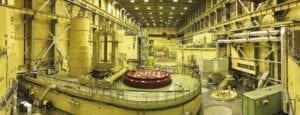
“Introduction of a new fuel is an option to improve technical and economic performance of a nuclear power plant without substantial investment. We are actively engaged in development of new models and modifications of VVER-440 fuel for power plants in Europe. The projects of the new fuels for Loviisa NPP in Finland, Dukovany NPP in the Czech Republic, Mochovce and Bohunice NPPs in Slovakia, are currently at various stages of implementation. Despite the same reactor model, these projects are quite different technically and conceptually, since we take into account the individual needs and requirements of our customers,” commented Natalia Nikipelova, President of TVEL JSC.
For reference:
The project of development and validation of the new fuel has been accomplished with participation of a number of Russian nuclear industry enterprises, such as OKB Gidropress (a part of Rosatom machine-building division Atomenergomash), Bochvar Institute (material science research facility of TVEL Fuel Company), Elemash Machine-building plant and Kurchatov Institute national research center. At the site of OKB Gidropress research and experiment facility, the new fuel passed a range of hydraulic, longevity and vibration tests.
Paks NPP is the only functioning nuclear power plant in Hungary with total installed capacity 2000 MWe. It operates four similar units powered by VVER-440 reactors and commissioned one by one in 1982-1987. Currently, Paks NPP is the only VVER-440 plant in the world operating in extended 15-monthes fuel cycle. The power plant produces about 15 bln kWh annually, about a half of electric power generation in Hungary. In 2018, the project of increasing the duration of Paks NPP fuel cycle won the European competition Quality Innovation Award in the nomination “Innovations of large enterprises”. Russian engineers from TVEL JSC, Kurchatov Institute, OKB Gidropress, Bochvar Institute and Elemash Machine-building plant provided assistance to the Hungarian colleagues in accomplishment of the project.
TVEL Fuel Company of Rosatom incorporates enterprises for the fabrication of nuclear fuel, conversion and enrichment of uranium, production of gas centrifuges, as well as research and design organizations. It is the only supplier of nuclear fuel for Russian nuclear power plants. TVEL Fuel Company of Rosatom provides nuclear fuel for 73 power reactors in 13 countries worldwide, research reactors in eight countries, as well as transport reactors of the Russian nuclear fleet. Every sixth power reactor in the world operates on fuel manufactured by TVEL. www.tvel.ru
118 wallypower yacht

The global authority in superyachting
- NEWSLETTERS
- Yachts Home
- The Superyacht Directory
- Yacht Reports
- Brokerage News
- The largest yachts in the world
- The Register
- Yacht Advice
- Yacht Design
- 12m to 24m yachts
- Monaco Yacht Show
- Builder Directory
- Designer Directory
- Interior Design Directory
- Naval Architect Directory
- Yachts for sale home
- Motor yachts
- Sailing yachts
- Explorer yachts
- Classic yachts
- Sale Broker Directory
- Charter Home
- Yachts for Charter
- Charter Destinations
- Charter Broker Directory
- Destinations Home
- Mediterranean
- South Pacific
- Rest of the World
- Boat Life Home
- Owners' Experiences
- Interiors Suppliers
- Owners' Club
- Captains' Club
- BOAT Showcase
- Boat Presents
- Events Home
- World Superyacht Awards
- Superyacht Design Festival
- Design and Innovation Awards
- Young Designer of the Year Award
- Artistry and Craft Awards
- Explorer Yachts Summit
- Ocean Talks
- The Ocean Awards
- BOAT Connect
- Between the bays
- Golf Invitational
- Boat Pro Home
- Pricing Plan
- Superyacht Insight
- Product Features
- Premium Content
- Testimonials
- Global Order Book
- Tenders & Equipment

Iconic yachts: 118 WallyPower
The 118 WallyPower remains as striking today as when it was first launched in August 2003. The futuristic lines are reminiscent of a Stealth bomber, and it’s easy to imagine Darth Vader at the controls, skimming over the waves. This boat still generates discussion, still turns heads, still mesmerises.
Luca Bassani , founder of Wally, is so in love with the 118 WallyPower that once a year he goes out on the tender, switches off the engine and instructs the crew to surge past him at top speed. ‘The motion is not actually the speed; the motion is first of all the shape of the boat and the fact that you don’t hear anything. It’s just this great, beautiful sheet passing by at high speed with the only sound a light whistle.’ He makes a hissing sound between his teeth and laughs. ‘Another thing I like is that from the outside, when the boat is anchored in a bay, you really don’t see it… the sage colour blends and changes with the colour of the coast, the rocks and the green of the water.’
Bassani took the plunge from sailboat to motor yacht design when he noticed a 15 to 20 per cent increase in the open power boat market over ten years. The 118 WallyPower took four years to develop. He had a client in mind but no contract, but this was enough to give him the impetus to move forward without the constraints of working within a client’s needs. The objective was to create a very fast boat perfect for short Mediterranean day cruises and able to maintain high speeds even in rough seas. The solution was a deep V hull which, with the shape of the bow and the use of interceptors, allows the boat to pierce the waves comfortably, even at high speeds. ‘Extensive research and tank testing resulted in a hull design different and better than any other,’ he claims. ‘Like our sailboats, the design is an evolution of all our experience. For us the ride of the hull is the key to our sales.’
The new hull design will be used for all the range, starting with the tender. ‘It is really fantastic. If weather conditions allow, you would rather cruise at 60 knots, but in reasonable conditions, at 40 knots you can do all the missions you have to do.’
After the hull, Bassani is most satisfied with the forward ‘liveable’ cockpit of the 118 WallyPower. ‘When I say liveable I’m talking about quality of life aboard. This foredeck feels as if you are on a sailboat, not a power boat, which I like a lot.’ He is also pleased with the water jet propulsion: ‘The noise is very low – no vibration, fantastic manoeuvrability, no problem with draught. We see only advantages.’ And he believes carbon fibre is essential for cutting through the waves: ‘You need a very rigid, light hull. You don’t use carbon fibre for the bottom of the hull because it would become too brittle, but the structure inside has to be carbon.’
The 118 WallyPower’s gas turbines deliver 17,000hp, and diesel is used for manoeuvring and cruising at night at up to 10 knots. ‘With the two diesels you have a great range – 1,800 miles – while if you went with the gas turbines at 40 to 60 knots the range is 400 to 500 miles, no more.’ This brings up the subject of sustainable power: ‘We are studying a new concept that will substantially improve the sustainability of powerboats,’ says Bassani.
More about this yacht
Similar yachts for sale, more stories, most recent, from our partners, sponsored listings.
BoatNews.com
118 WallyPower, a stealthy superyacht for billionaire owners..
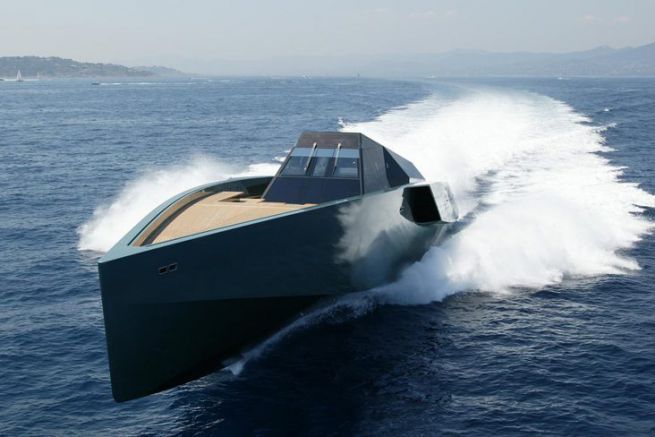
The 118 WallyPower is a 36 m superyacht built by the famous Wally shipyard in the 2000s. With its futuristic military inspired look and its 3 large gas turbines, she was a UFO when she was launched.
A futuristic construction
The 118 WallyPower is the largest motor yacht produced by the famous Monegasque shipyard Wally Yachts . It was built in the early 2000's according to the drawings of Luca Bassani for a client who wanted a motor yacht inspired by the 27 m sloop built by the shipyard and with the Argentinean naval architect Frers, called Tiketitan.
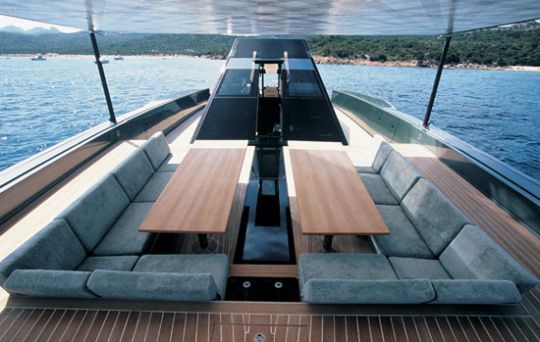
Luca Bassani Antivari, founder of Wally and an accomplished former sailor is passionate about sailing. But through this project of a 36 m superyacht, he will launch the Wallytender, then the 118 WallyPower.
Its angular lines associated with the glass superstructure are reminiscent of a stealth ship. The result is a sense of power and speed . In fact, Wally's founder describes it as ".. a stealth bomber with a sailboat bow, Formula One-style air intakes and a stripped-down Asian-inspired interior design."
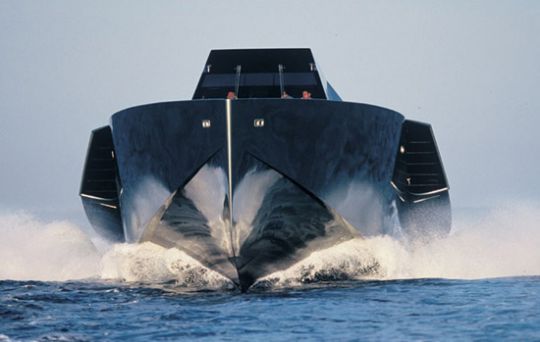
An exceptional motorization
The engines - i.e. 3 gas turbines of 5?600 CH each - develop a total of 16?800 CH (12?500 kW). They power a Rolls-Royce Kamewa jet-type transmission consisting of 2 steerable side jets and a fixed central jet. Two 370 HP (280 kW) Cummins diesel engines can take over from the turbines. In the first configuration, the 118 WallyPower will reach more than 60 knots (110 km/h), but only 9 knots in the second version, which will be preferred for long distance manoeuvres.
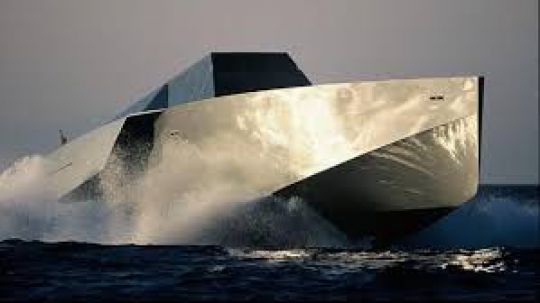
State-of-the-art construction
The hull of the 118 WallyPower is the result of an extensive research and development program that included tests in the hull tank in Gothenburg, Sweden and in the wind tunnel at Ferrari in Maranello, Italy . Stability at high speed is guaranteed by a deep V-shaped hull (22° degrees) and a wave piercing straight bow. The air intakes of the gas turbines have been optimized to minimize vibration and exhaust backflow on deck and into the hull. The hull conceals a tender garage.
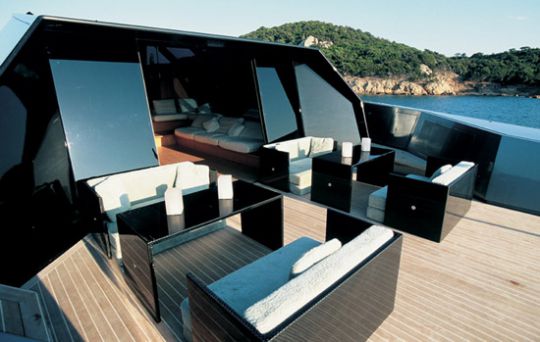
The bottom of the hull is constructed of monolithic fibreglass. The dead works with a hybrid of balsa sandwich and fiberglass/carbon. The deck is made of Nomex (Kevlar honeycomb)/carbon. The superstructure of the deck is made of a carbon frame on which glass panels are glued. Inside, part of the interior layout is made of carbon to reduce weight. The dark green metallic paint changes with the reflections of the changing lights and landscape. On the deck, in the cockpit, the bulwarks tilt to enjoy an incredible view of the sea from the saloon but also to take advantage of the large outside space.
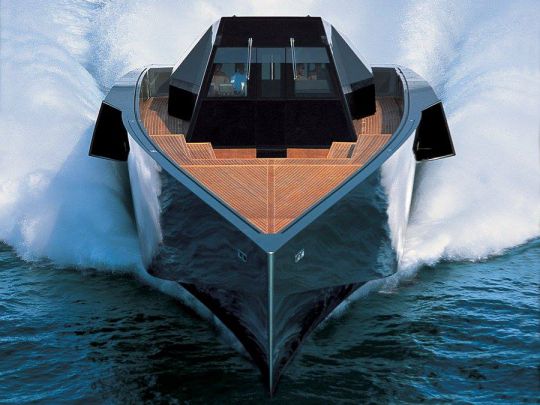
A luxurious and uncluttered layout
Inside, on the main deck, the open space offers 3 distinct areas, from bow to stern: the helm station, the raised dining/meeting area and the large saloon below, which opens onto the outside without a break in continuity, introducing the concept of the inside-outside living area. A 360° view is available from the dining area thanks to the raised floor. Under the dining table - which seats 8 people - long rectangular glazing brings light to the lower floor. This keeps the dining area at the front away from the heat of the engines. The boat also has 6 plasma screen televisions.

Below deck, the owner's cabin is located forward and has a deck porthole for light. There is a large double bed, a private bathroom and a large dressing room. Two guest cabins have a queen-size bed, a dressing room and a bathroom.
The kitchen (with the pantry) includes an oven, stove, television and several refrigerators.

A millionaire's boat
The price of the 118 Wallypower is $33 million for the triple gas turbine version, or $22 million for the dual diesel engines. Its range is 1800 miles at 9 knots or 300 miles at 60 knots. Finally, its fuel tank has a capacity of 22 tons.
At the maximum speed of 60 knots, the gas turbine uses 58 litres of fuel per mile, or 3?500 litres per hour. For example, to travel from Cannes to Saint-Tropez and back at 50 knots, it takes 90 minutes for 6?000 to get from Cannes to Saint-Tropez and back, using dépensé?! The WallyPower 118 weighs 95 tons and can accommodate 6 crew members and 6 guests on board.
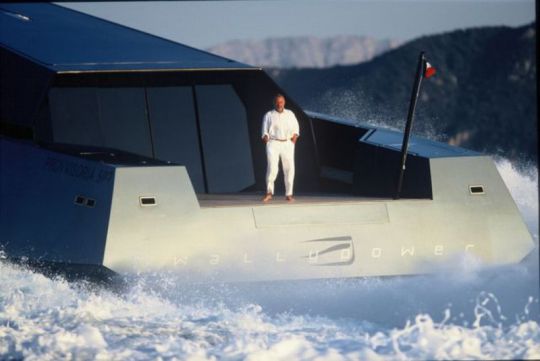
Prestigious awards
The 118 WallyPower won the MYDA, Millennium Yacht Design Award, organised by Seatec (the Carrarafiere sailing and navigation technology trade fair) for "Design for the third millennium". It was the only boat in the architecture and design exhibition of the Museum of Modern Art in San Francisco in 2004/2005), for the exhibition "Glamour : Fabricating Affluence".
- Subscribe Now
- Digital Editions

World’s coolest boats: Wallypower 118 looks like Darth Vader’s superyacht
- Superyachts
- Top stories
Each month we pick out an iconic boat that can lay claim to the title of world’s coolest boat. This month, we take a closer look at the 118 Wallypower.
Michael Bay’s 2005 sci-fi thriller movie The Island was about a group of people isolated in a compound, they’re told, due to nuclear fallout.
As the film progresses, we learn that these people are in fact clones of wealthy individuals, created for organ-harvesting should it ever be needed.
Because they are clones, they experience dreams based on lives they have not lived. One of them is a clone of a famous yacht designer, and so his dreams are of superyachts .
The studio needed the most dramatic, the most outstanding, the most iconic superyacht on the water to illustrate this, and so, of course, they chose the Wallypower 118.
Article continues below…
Recommended videos for you
Wally why200 yacht tour: inside the most extraordinary superyacht of the year, iguana 29 yacht tour and test drive: is the world’s coolest amphibious boat.
The brainchild of Luca Bassani, heir to a Milanese lighting fortune and owner of Monaco-based Wally Yachts , it was the first foray into large motor yachts for his yard, noted up until then for building edgy sailboat designs and being named after the Hanna-Barbera cartoon character, Wally Gator (a favourite of his young son).
The most outstanding feature of this sensational beast is the styling. At 118ft long and completely unique, it appears to have been constructed using origami. The hull is carbon fibre and GRP composite, and the superstructure is triple-laminated tinted glass on a carbon frame.
And if that’s not wacky enough, everything on the exterior of the yacht, from the cleats to the tables to the seating, is concealed – rising out of the deck when required. If Darth Vader had a superyacht, it would look like this.

Movie-star styling and minimal-luxe interiors combine to create the ultimate superyacht
Such an outstanding design deserves supreme performance, so the pair of 370hp diesel engines, producing a top speed of 9 knots, appears initially underwhelming. But fear not, these are merely an amuse-bouche, fitted only to manoeuvre the boat out of the harbour.
Once at sea the captain is free to light up the three Vericor TF50 gas turbines, unleashing over 16,800hp through three water jets (two steerable, one fixed) and propelling this incredible machine past 60 knots, according to the manufacturer.
Although conceived as a production yacht, reportedly only one was ever built. The price at the time? An impressive £17 million.
118 Wallypower specifications
Year: 2004 LOA: 118ft 1in (36.0m) Beam: 29ft 6in (9.0m) Power: 16,800hp Top speed: 65 knots Price: £17 million Cool rating: Absolute zero (-273° C)
To submit your suggestion for the world’s coolest boat, head over to the MBY forum .
Revealed: The true cost of running a $3 million superyacht
Navan s30 & c30 tour: exceptional new axopar rival, axopar 29 yacht tour: exclusive tour by the man behind it, latest videos, galeon 440 fly sea trial: you won’t believe how much they’ve packed in, parker sorrento yacht tour: 50-knot cruiser with a killer aft cabin, yamarin 80 dc tour: a new direction for the nordic day cruiser.
- THE PRINCESS PASSPORT
- Email Newsletter
- Yacht Walkthroughs
- Destinations
- Electronics
- Best Marine Electronics & Technology
- Boating Safety
Wallypower 118
- By Dennis Caprio
- Updated: October 4, 2007
If Wallygator , the first of Luca Bassani’s brainchildren, was a breath of fresh air when it appeared on the sailing scene in the waning years of the last century, the Wallypower 118 motoryacht is a full gale. On the outside, she combines elements of Marcello Gandini’s masterpiece Lamborghini Countach of the middle 1980s and the U.S. Air Force Stealth Fighter. On the inside, she reinforces Bassani’s predilection for simple, open spaces defined by areas of use, instead of bulkheads. Bassani, il padrone of Wally Yachts, didn’t design the 118, but his signature is all over it.
Like the Countach and the Stealth Fighter, this 118-foot speedster is a riot of hard edges, straight lines and serious functionality. Her extraordinary elegance and simplicity suggest a child of 10 could have produced her topsides and house, but these elements are the work of modern artists set free from the shackles of traditional thinking about how boats should look.
As far as I can tell from the drawings, only one of the design elements above the waterline exists purely for its own sake. Everything else serves a purpose. The sheerline in profile is reversed, higher amidships than at either end. This is typical of high-performance boats and had its origin in an attempt to make the topsides aerodynamic. The Wally’s recessed deck kills that theory, so we have to regard the reverse sheer as a styling exercise that places the 118 in the high-performance category.
We could easily dismiss the prominent side pods as a gimmick, mostly because we’re so used to seeing fake scoops and vents on modern automobiles and boats. These, however, are real. They draw, via the forward opening, mega-volumes of fresh air to the gas turbine engines, and they house the exhaust system. The top section of each pod (above deck height) hinges outboard to become a teak-paved boarding platform served by a ladder/gangplank that appears to slide out of the pod.
As a styling device, the side pods, combined with the rise of the chine from amidships forward, carve the massive topsides area into manageable sections, letting us process her statement at our leisure instead of forcing us to absorb the whole in one glance. The design team’s confidence in the 118’s dramatic statement is illustrated by the choice of color. The designers rendered her in titanium gray on the topsides and charcoal gray for the house, proudly showing exactly how this sculpture defines itself in shadows and highlights. She may be the only large powerboat in the hyper-performance class that doesn’t need “oh boy” murals on her topsides.
Flat planes at various angles to one another form a deckhouse that reminds me of the Stealth Fighter. Claudio Lazzarini, of the Lazzarini & Pickering design firm, calls it a crystal prism. The entire structure is made of flat transparent panels-flat to permit the use of power-operated doors and windows, and to prevent the distorted view that often comes with transparent curvatures. This crystal prism, the designers said, creates in the saloon the relaxed atmosphere of a cockpit. Tinting the structure filters ultraviolet rays, keeps the interior from being too bright and too hot, and contributes to the yacht’s purposeful look. Decks of natural-finish teak color-a touch of the early 20th century on an otherwise futuristic concept-ease the extreme tension generated by her sharp edges and no-nonsense demeanor.
Teak planes, vertical and horizontal, inside the crystal prism divide the area into a landscape of functions, or islands in a sea of teak. Right abaft the helm, a sliding teak table seats 14 adults in a formal or a casual setting. Among the many islands, one contains a single seat for reading or working at a computer housed in a nearby cabinet. Beneath this chair is a small, drawer-style refrigerator most people would stock with mineral water, soft drinks and beer. Another island lets you stretch out to watch the TV perched atop an end table, which also contains a stereo.
“The navigation area,” Carl Pickering said, “is more similar to a flight deck than its usual nautical equivalent and can be used as an office or dining area, thanks to sliding tables.”
Lazzarini & Pickering continue the system of teak planes belowdecks to create the corridors and staterooms, though details about the area weren’t available. Outside, the teak theme appears in the after cockpit and a playpen on the foredeck. Here, we find picnic tables that retract flush with the deck, forming a sunbathing area.
The 118’s hull is narrow monohull with training wheels. It has its roots in high-speed naval craft and, as far as I can determine from the renderings, marries an extremely fine entry to an inverted W-shape planing surface. The design team volunteered only that the bow sections reduce vertical accelerations by 50 percent. This means a relatively smooth ride in a seaway. Her fine entry will split the waves, but the bow sections will gain buoyancy as the high chines dig into the water. By this time, most of the energy will have dissipated, so the crew won’t get slammed into the cabin sole. If I were drawing this bottom, I’d make the chine area a tunnel of something close to a semicircle. Ridding the bottom of flat surfaces reduces pounding. On the other hand, a flat surface at the planing area, which won’t leave the water, creates lift, so let’s look for a delta-shape flat way back aft.
Wally expects a top speed of 70 knots from the 118’s four engines-a pair of gas turbines and two diesel auxiliaries-turning two KaMeWa waterjets. I call the diesels auxiliaries because the helmsman will use them for low-speed maneuvering, turbines disengaged, and cruising at very low speeds. Each turbine/diesel duet couples to a clutched transfer box, which permits running one or both engines each side. This, too, is common on military craft.
If my assumptions about the bottom are skewed, I’ll be the first to admit it, but we’ll have to wait until hull number one splashes or I see her under construction. I do know the shape benefits from extensive tank testing.
Wally expects to launch hulls one and two during 2002. Right now, though, I think the Wallypower 118 is the most significant design of the past 14 years, the period I’ve devoted to studying how boats work and why. Like all brilliant works of art, functional or decorative, the 118 defies a simple interpretation. Her statement is far too powerful to permit any observer to settle on a middle ground. They’ll love her or hate her.
Let me be the first to say, “I love this design.”
Contact: Wally Yachts, (011) 377 93 1000 93; fax (011) 377 93 1000 94; [email protected] ; www.wallyyachts.com .
- More: Motoryachts , Wally
- More Yachts
New Flagship for Bering Yachts: The B165
Power catamaran popularity rising, “energy observer” zero-emission boat showcases sustainability, princess yachts’ y95: a flagship flybridge, for sale: sunseeker predator 68, for sale: cl yachts clb 72, 10 yachts under $500,000 you can have today, how to swing a compass on a boat.
- Digital Edition
- Customer Service
- Privacy Policy
- Email Newsletters
- Cruising World
- Sailing World
- Salt Water Sportsman
- Sport Fishing
- Wakeboarding

Find anything, super fast.
- Documentaries
We don't have any additional photos of this yacht. Do you?
Motor Yacht
Luxury motor yacht Wallypower 118 was built in 2002 by Italian shipyard Rodriquez Intermarine. With a composite hull and superstructure, she features naval architecture by Wally and Intermarine, and exterior and interior design by Lazzarini Pickering and Wally. This three waterjet and twin screw propulsion yacht measures 36 metres and can accommodate up to six guests cruising and sleeping.
Motor yacht Wallypower 118 is easily one of the most distinctive vessels on the water with her unique and striking exterior design. Capable of reaching high cruising speeds, her design was the result of extensive development and research that included exhausting testing. She has a steeply angled V-shaped and a stand-out deckhouse that crowns the super yacht.
Her hull colour can be likened to that of a chameleon; it’s dark green tone changes with alterations in the outside landscape and light. Her glass-sided deckhouse hides a generous saloon aft dressed in white and wood that creates somewhat of a beach house feel. Here also lies a dining table for 14, relaxing nooks and entertainment areas.
Her interior is of minimalist design, and instead of showy extras, the majority of her features serve a purpose; towards weight minimisation, speed enhancement or must-have comfort. However she also boasts her share of soft furnishings that give the interior a look not far from a New York style loft.
Amongst her three cabins are an indulgent owner’s stateroom, and two Queen-size guest cabins. The owner’s stateroom features an en suite with his and hers shower and large tub, while each guest cabin also features an en suite. The crew’s quarters on the lower deck includes three lower cabins that sleep six and include en suite facilities.
Luxury yacht Wallypower 118 is powered by three DDC TF50 gas Turbines and two Cummins 370 horsepower engines; a combination quite common on smaller warships but not so on super yachts. She can achieve a range of 380 nautical miles while cruising at a speed of 60 knots or 1,500 nautical miles at nine knots.
Featuring a dedicated crew, Wallypower 118 is an excellent charter yacht for luxury vacations. The yacht cruises comfortably at 60 knots while her crew of six ensure the needs of every guest are met. The luxury vessel has been built to R.I.N.A classification.
- Yacht Builder Intermarine No profile available
Yacht Specs
Other intermarine yachts, related news.
Galeocerdo a WallyPower 118 Superyacht
Inspiration, galeocerdo has 5 photos.
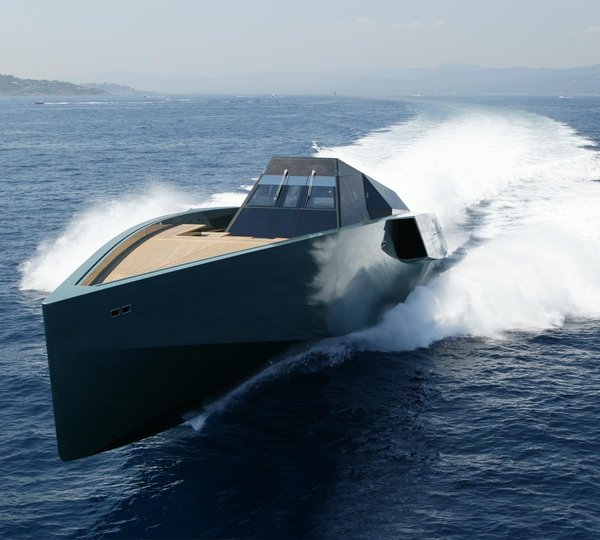
Galeocerdo News
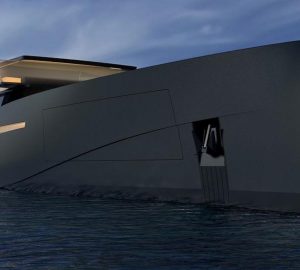
New 83m Explorer Yacht by Wally, ...
Similar yachts.
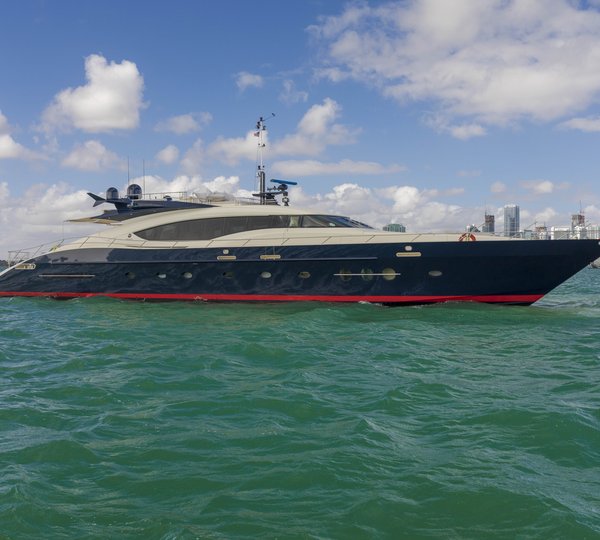
BURN RATE | From US$ 74,000/wk
- Yachts >
- All Yachts >
- All Motor Yachts Over 100ft/30m >
If you have any questions about the Galeocerdo information page below please contact us .
Measuring 36 meters in length, luxury yacht Galeocerdo (Wally//118) represents undoubtedly one of the most distinctive and fastest motor yachts in the world. Motor yacht Galeocerdo features naval architecture by Wally and Intermarine, while her exterior styling is by Wally and Lazzarini Pickering Architects. Boasting a striking vertical bow, the vessel provides unmatched stability and control, even at high speeds.
Galeocerdo Specifications
WallyPower 118 superyacht Galeocerdo features bright and spacious interiors, comfortably sleeping 6 guests in total, looked after by a professional crew of 6. She represents a truly unique combination of the thrills of a high-performance sport boat, with the comforts of a luxury cruising yacht.
The impressive three gas turbine Vericor TF50 diesel engines produce 17,000 horsepower, propelling the WallyPower 118 yacht Galeocerdo to the amazing top speed of over 60 knots.
Yacht Accommodation
A total number of 6 guests are offered maximum comfort and luxury aboard WallyPower 118 superyacht Galeocerdo. There is also accommodation for an attentive crew of 6 members.
Amenities and Extras
We do have available further amenity, owner and price information for the 36m (118') yacht Galeocerdo, so please enquire for more information.
Galeocerdo Disclaimer:
The luxury yacht Galeocerdo displayed on this page is merely informational and she is not necessarily available for yacht charter or for sale, nor is she represented or marketed in anyway by CharterWorld. This web page and the superyacht information contained herein is not contractual. All yacht specifications and informations are displayed in good faith but CharterWorld does not warrant or assume any legal liability or responsibility for the current accuracy, completeness, validity, or usefulness of any superyacht information and/or images displayed. All boat information is subject to change without prior notice and may not be current.
Quick Enquiry
“You look around the market today and I would say that 95 per cent of yachts from 40 to 140 feet have copied Genie of the Lamp. That kind of layout, that kind of style and deck, it’s clear. I don’t think it’s too much to say that Genie has influenced the last 20 years.” - "Today, everyone has ‘invented’ the vertical bow. We didn’t invent it, it was invented in the 19th century, even before that, but when we introduced it in 2003, everyone was against it. Even the naval architects, they were saying, ‘no, this boat will have big problems’. And now everyone understands that there are a lot of advantages in having a vertical bow. And everyone is claiming they invented it!” - Luca Bassani, founder and president of Wally
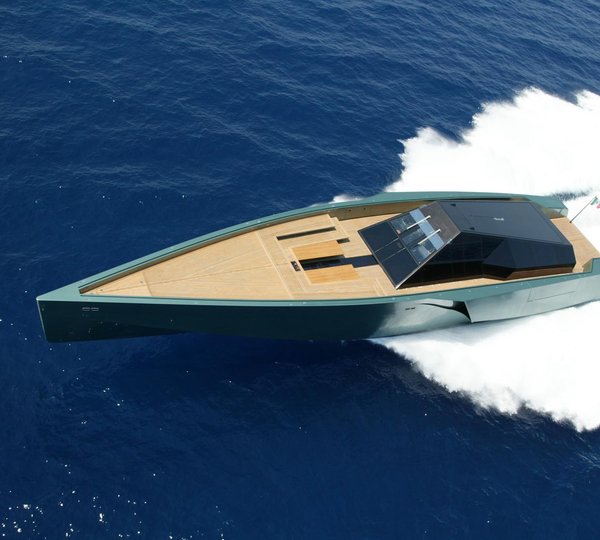
AURA | From EUR€ 94,500/wk
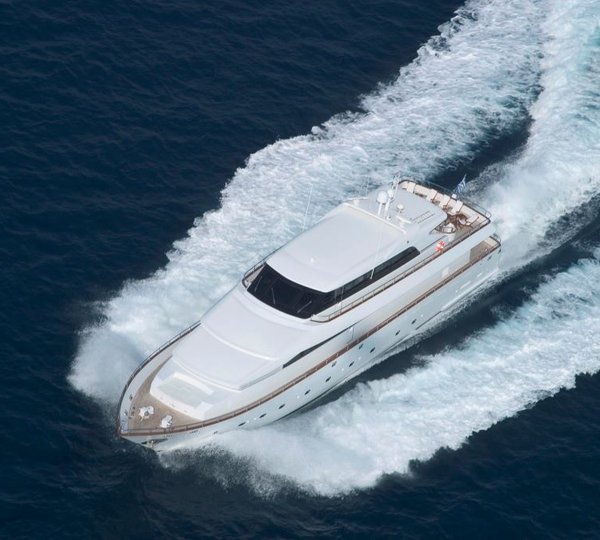
Let It Be | From EUR€ 60,000/wk
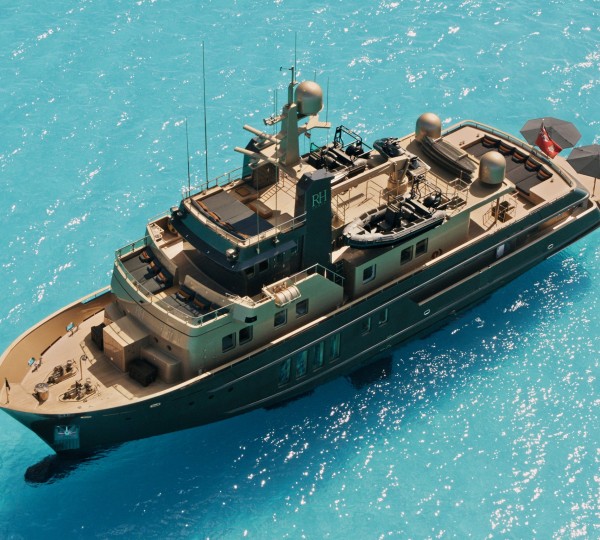
RH THREE | From US$ 125,000/wk
You are using an outdated browser. Please upgrade your browser to improve your experience.
118 WallyPower High Speed Luxury Yacht
The 118 WallyPower is one of the most eye-catching yachts in today’s luxury boating market, created by the Monaco-based Wally Yachts. It is narrow and angular in design with black glass housing. It is 118 feet long and is capable of reaching speeds as fast as 60 knots (70 mph, 110 km/h). It is capable […]
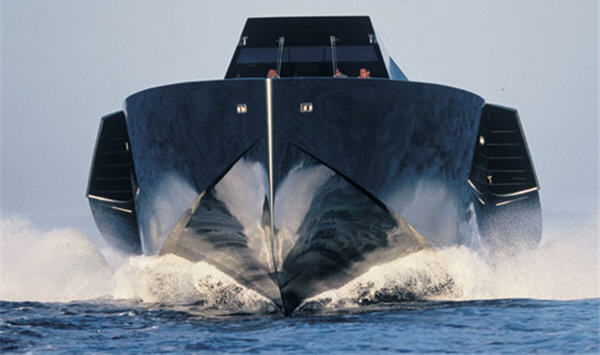
The 118 WallyPower is one of the most eye-catching yachts in today’s luxury boating market, created by the Monaco-based Wally Yachts. It is narrow and angular in design with black glass housing.
It is 118 feet long and is capable of reaching speeds as fast as 60 knots (70 mph, 110 km/h).
It is capable of this feat due to three Vericor TF50 gas turbines generating 16,800 hp. The three gas turbines each drive a Rolls-Royce Kamewa water jet, two steerable outboard and a non-steering booster on centerline. The steerable water jets also have a diesel engine input for a 370 hp Cummins diesel hence these two wing drive trains are Combined Diesel and Gas Turbine (CODOG).
Wally Yachts did extensive testing in the SSPA facility in Gothenburg, Sweden and at Ferrari’s windtunnel in Italy.

The 118 WallyPower is superbly crafted of exotic materials in and out, with thin wood veneers over honeycomb cores and lots of exposed black carbon fiber.
The 118 WallyPower won the MYDA, Millennium Yacht Design Award, organised by Seatec (the yachting and shipping technology show of Carrarafiere) for the “Layout of the Third Millennium.”
The WallyPower is also being honoured by the San Francisco Museum of Modern Art as the sole boat in its major architecture and design exhibition, ‘Glamour: Fabricating Affluence’, which ran from October 9 2004 to January 16 2005.
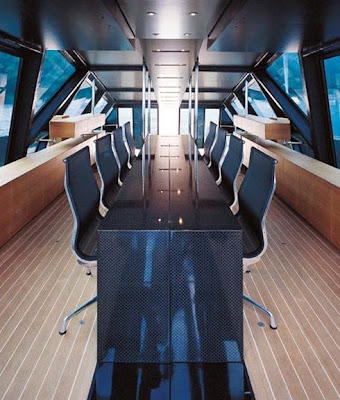
Wally Yachts has only produced one, and it currently resides in the Mediterranean. The 118 is known by most from its role as the “Renovatio” in the 2005 science-fiction film The Island.
Price? $24 million- and the Wally owner should budget, say, $400,000 a year for a professional crew. Wally is awaiting a firm order before building the next 118.
The company might have to wait a while. “I don’t think it’s a marketable product,” says Roger Marshall, a yacht designer and boating writer.
“It’s a high-speed boat that is way overpowered and expensive as hell to run, so the market consists of very few people.”

RECOMMENDED FOR YOU

VERICOR NEWS
Vericor power systems’ tf50 gas turbines to power wallypower 118 high-speed yachts.
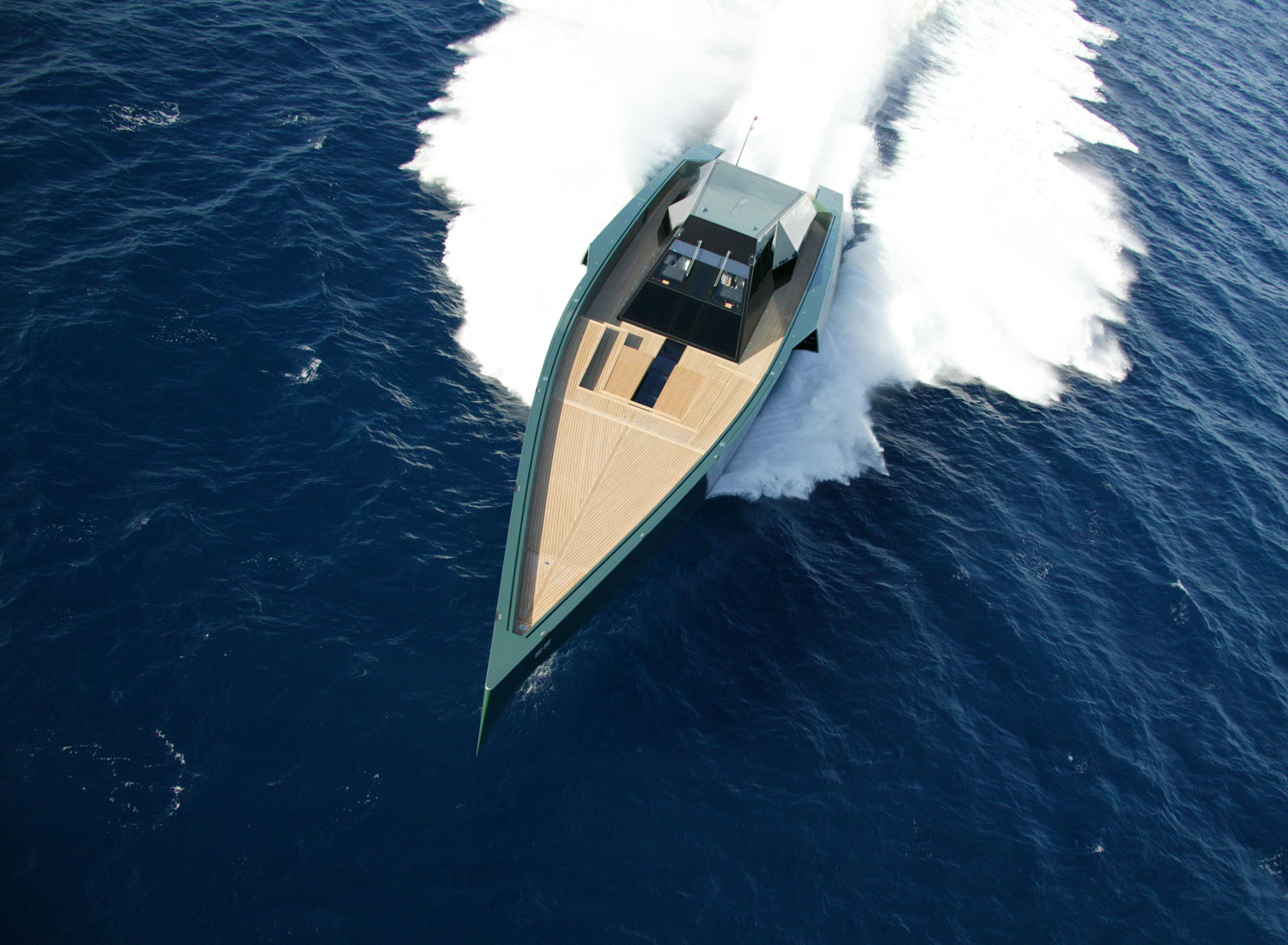
Three Vericor Power Systems' TFT50 marine aeroderivative gas turbines have been selected to power the 118 Wallypower high-speed yacht being built by Intermarine Shipyard, Sarzana, Italy for Wally Yacht.
This is Wally Yacht's first foray into high-speed power yachts, and the company's initial application of gas turbines. Wally Yacht, based in Monte Carlo, Monaco, is a world-renowned designer of high-speed sailing and power yachts.
The 118-foot yacht will feature three TF50 gas turbines in a Combined Diesel Or Gas (CODOG) turbine configuration. Two TF50s will be used as side or "wing" engines, with one small auxiliary diesel engine connected to each wing engine. The diesels will provide for very slow maneuvering only. The wing engines will drive steerable waterjets while the center boost TF50 will drive a fixed waterjet. Total propulsion system output will be 16,800 horsepower/ 12,533 kilowatts (see attached line drawing of the propulsion system configuration).
Cruising speed will be 60 knots, with a maximum speed of 70 knots. Table 1 shows the technical specifications for the 118 Wallypower yacht.
Detroit Diesel Corporation (DDC) packaged the CODOG system for the 118 Wallypower yacht. DDC, a Vericor Power Systems marine systems distributor, is part of MTU-Friedrichshafen, a division of DaimlerChrysler Powersystems. DaimlerChrysler is one of the world's leading manufacturers of marine propulsion engines and systems.
The integrated system includes three TF50 gas turbines, controls, Maag gears, as well as fuel, lube, cooling and exhaust components. Table 2 illustrates the commercial marine specifications for the TF50 gas turbine.
A team comprised of Vericor Power Systems and DDC field service engineers will install and conduct sea trials for the high-speed yacht. Installation of the CODOG system on the Wally Yacht is scheduled for March 2002. Sea trials are to follow in April/ May 2002.
Yacht Experience Other commercial applications of Vericor's TF engines include the high-speed yacht Detroit Eagle. The vessel uses a TF50 aeroderivative marine gas turbine, marking the first such engine to begin operation. The megayacht, which can reach a comfortable cruising speed of approximately 35 knots, completed sea trials in the spring of 2001 and is now in operation.
The yacht was built at the Feadship de Vries shipyard in The Netherlands. This is the second Feadship yacht fitted with TF gas turbines. The 161-foot Sussurro yacht launched in 1998 features a TF80 (2xTF40) gas turbine system.
The "Mangusta" series yachts, being built by Overmarine Shipyard, in Viareggio, Italy, use TF40 and TF50 gas turbines. Five yachts use a total of five TF40 and two TF50 gas turbines in a variety of configurations. Four Mangusta yachts are now in full operation, with the fifth yacht in the series under construction.
The TF engines for all of the above applications were provided by Vericor Power Systems.
Product Spotlight
Marine gas turbine.
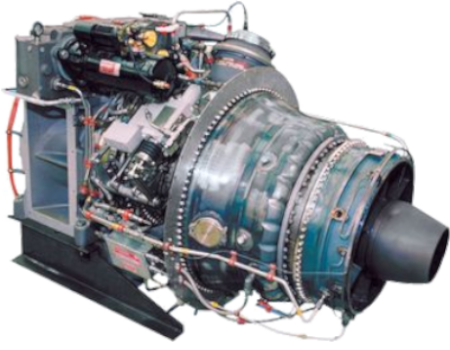
LEARN MORE ABOUT
Vericor's marine propulsion solutions, interested in more information.
WALLYPOWER 118 YACHT TRIBUTE
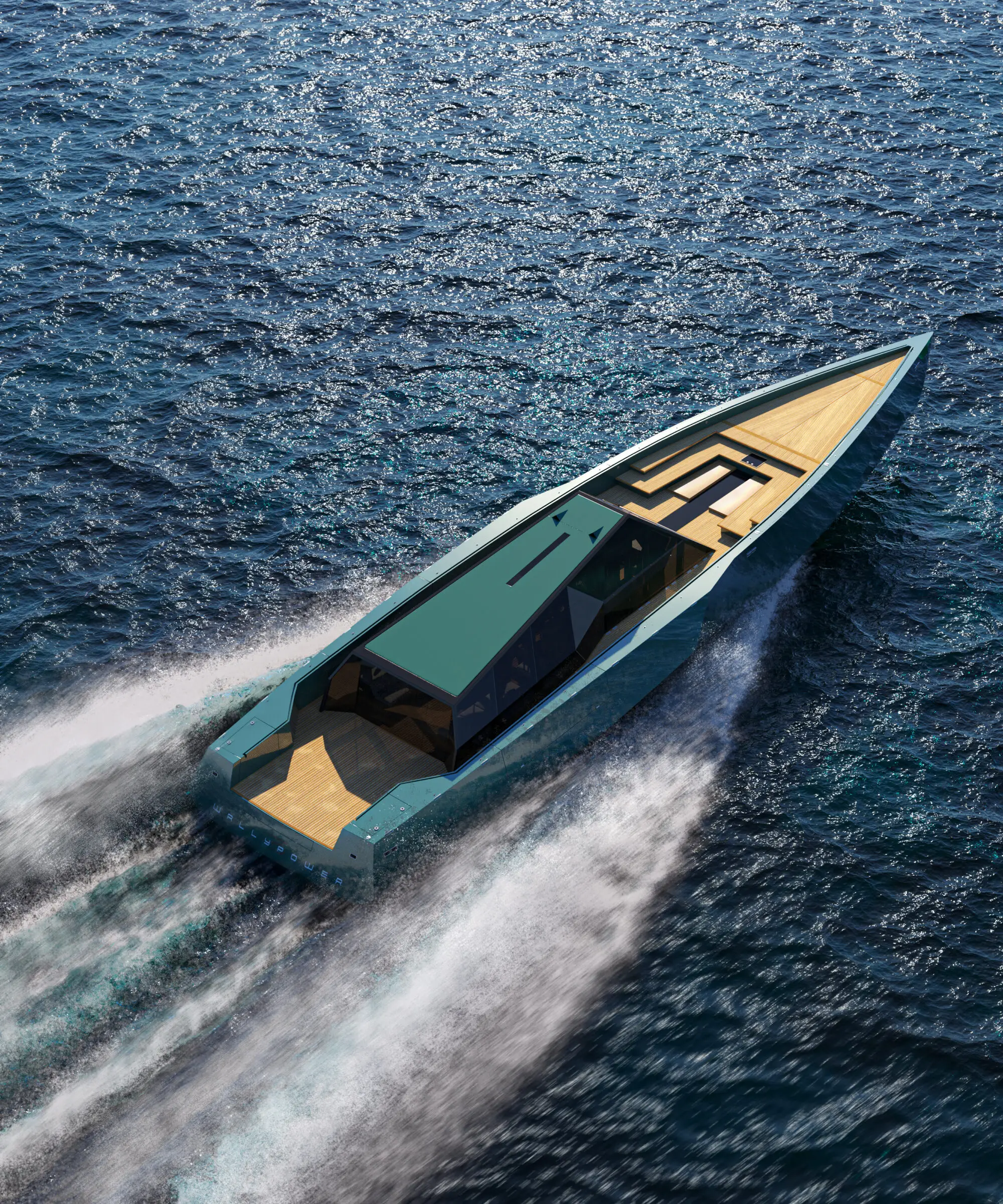
We are delighted to introduce you to our tribute to an iconic model of the nautical industry, such as the WallyPower 118 .
Through visual storytelling , we show the uniqueness of this yacht in its marine habitat. Our goal is to bring the viewer on a short emotional journey.
Research is at the core of our work.
A meticulous study that aims to enhance every project and make it unique.
VIDEO ANIMATION
Through the careful direction of the video, the story takes shape. WallyPower 118 has been gradually revealed through its details. At last, shown in all its magnificence, sailing in the open sea.
The change of light throughout the day enhances the details of the yacht’s materials and highlights its realism .
Above all our aim was to make the viewer feel part of the scene. We’ve shown the yacht from different perspectives. The military-inspired design, elegant style, and technological innovations make the Wally yacht so iconic.
In addition to our creative approach, all our 3D visualizations start from a meticulous analysis of the characteristics of the model, we take care of every aspect of the project, achieving realistic and unique visual communication for WallyPower 118.
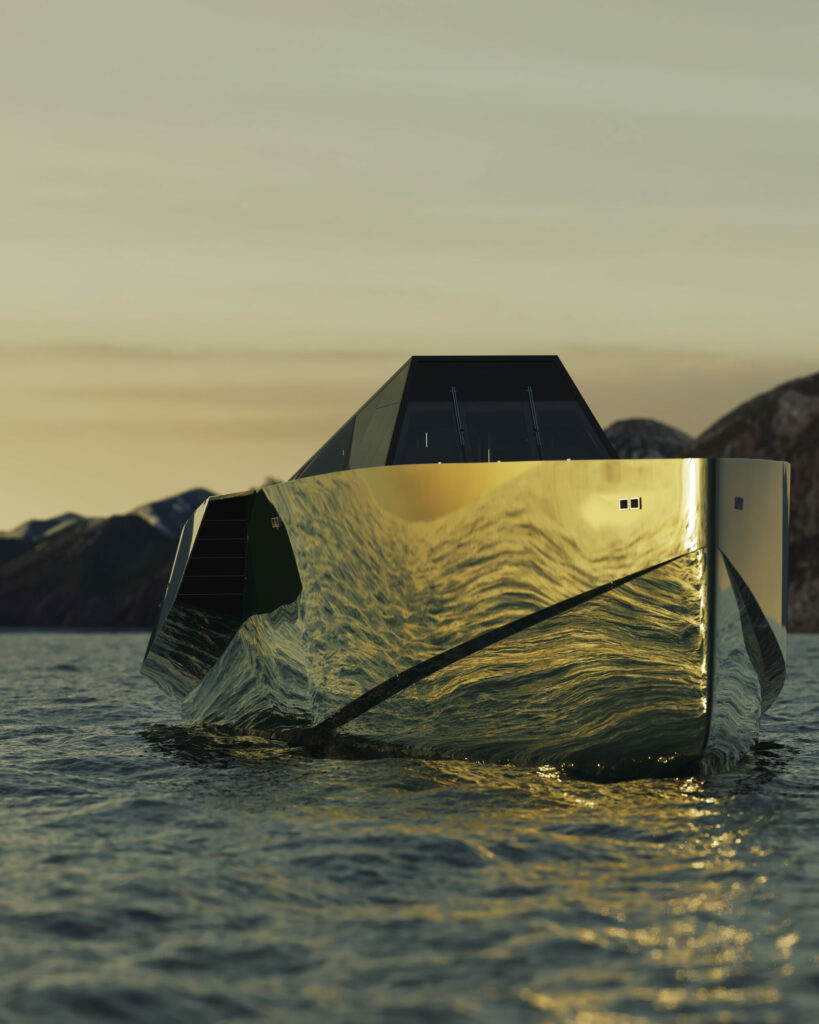
Wallypower 118 - the coolest luxury yacht in the world
The Wallypower 118 is a luxury yacht that gained widespread attention after it was featured in the 2005 science-fiction thriller movie "The Island." The yacht was designed and built by the Italian yacht manufacturer Wally Yachts and was launched in 2006. It is an ultra-modern and luxurious vessel that is designed to combine speed, style, and comfort.
In the movie "The Island," the Wallypower 118 is the personal yacht of the main antagonist, Dr. Merrick, played by Sean Bean . The yacht is depicted as an impressive vessel, sleek and stylish with a futuristic design that is fitting for the movie's sci-fi theme.
It measures 118 feet in length, thus the name, with a beam of 26 feet, and a draft of 5 feet. It can accommodate up to ten guests in five staterooms, and it has a crew of six. The yacht is powered by three gas turbines that generate a total of 16,800 horsepower, allowing it to reach a top speed of 60 knots, or about 70 miles per hour, making it one of the fastest yachts on the open seas .
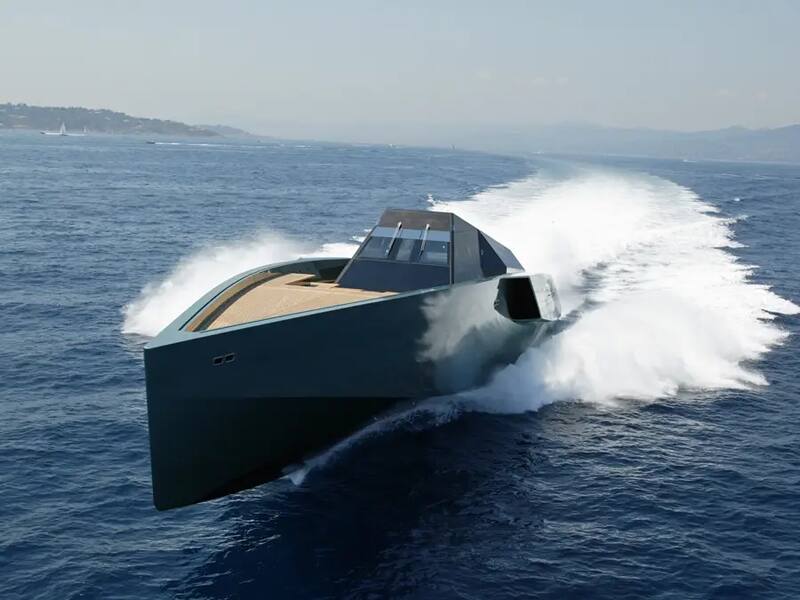
It's exterior design is striking and unique, with sleek lines and a minimalist style. The superstructure is made of carbon fiber, which makes the yacht lightweight and adds to its impressive speed. It's innovative propulsion system includes water jets instead of traditional propellers , which further contribute to its speed and maneuverability.
The interior is equally impressive , with a contemporary minimalist design, much like the outside. The main salon features floor-to-ceiling windows that offer stunning views of the surrounding water. The yacht's state-of-the-art entertainment system includes a plasma screen TV, satellite TV, and a surround-sound system. The master suite is located on the main deck and features a king-size bed, an en-suite bathroom, and a private balcony. The guest cabins are located on the lower deck and offer similar amenities and luxurious finishes.
It has become an icon in the world of yachting, renowned for its futuristic design and advanced technology. In "The Island," the Wallypower 118 is portrayed as the ultimate symbol of power and luxury , a fitting representation of the antagonist's character.
In conclusion, this is a remarkable yacht that has captured the imagination of people worldwide. Its characteristics have made it a standout vessel in the yachting world, and its appearance in a hollywood production has only added to its mystique.
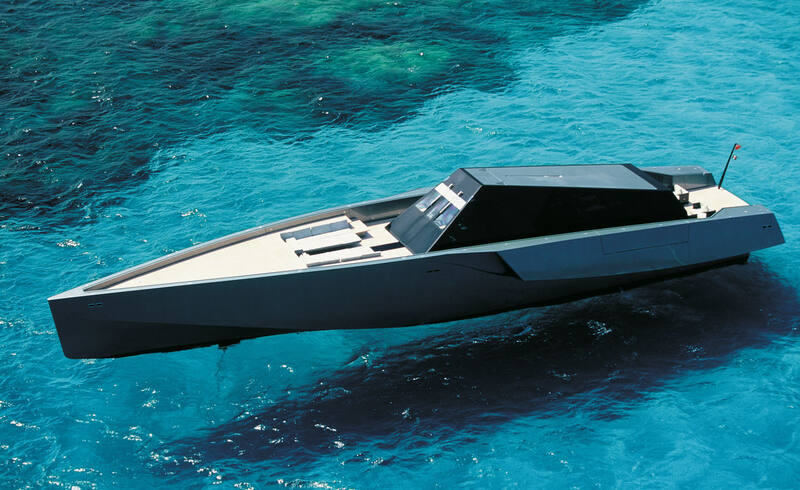
The price of the 118 Wallypower is US$33 million for the triple gas turbine version , or $22 million for twin diesels. It has a range of 1,500 nautical miles (2,800 km) at 9 knots (17 km/h), or 300 nautical miles (560 km) at 60 knots (110 km/h). Fuel capacity is 22,000 liters (5800 US gallons). At the maximum speed of 60 knots (110 km/h) the gas turbine uses 15 US gallons / 58 liters of fuel per nautical mile, 900 gallons / 3500 liters per hour . The boat displaces only 95 tons because of the sophisticated building technology that uses a hybrid structure to save weight, and can accommodate six guests and six crew.
It is worth noting that the final cost of a Wallypower 118 can be significantly higher than the base price due to the customization options available. Owners of the yacht can choose from a range of options such as interior finishes, materials, and technology upgrades, all of which can add to the cost of the yacht.
Exactly one has been built .

Coming Events
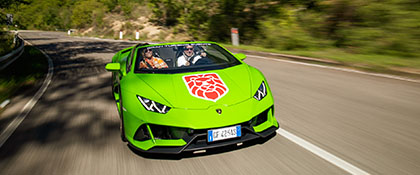
Subscribe to our newsletter
The latest news and stories. All the best roads, hotels and restaurants. Invitations to exciting events. Be the first to know by subscribing to our newsletter.
Mondo Gran Turismo
More news and stories from the world of Gran Turismo
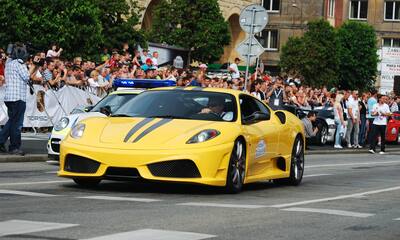
La Guida - The Supercar Owner's Guide to Europe
Our favourite roads, hotels, restaurants and places to visit
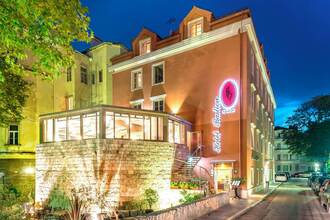
Events Calendar
Beautiful road trips and famous racing tracks since 2002. Supercars only.

While our head offices are in Geneva, Switzerland, the team is spread throughout Europe: Sweden, Poland, Italy and Croatia. Please select the appropriate team member to contact below.
For general enquiries, you can always use [email protected] . For event registrations, please use [email protected] .

© 2002 Gran Turismo SA (Geneva / Switzerland)
The LION LOGO, GRAN TURISMO EVENTS, KING OF GRAN TURISMO, LIKE THERE IS NO TOMORROW, SPECIAL EVENTS DEPARTMENT, CARS AND COFFEE STOCKHOLM, FULL RETARD, MONDO GRAN TURISMO and LA FAMIGLIA are registered trademarks
Do not use any of our brands without written approval
Gran Turismo SA c/o PKF | Rue des Battoirs 7 | 1205 Geneve | Switzerland | [email protected]

- Watches & Jewels
- Real Estate

Sign up to receive exclusive content updates!
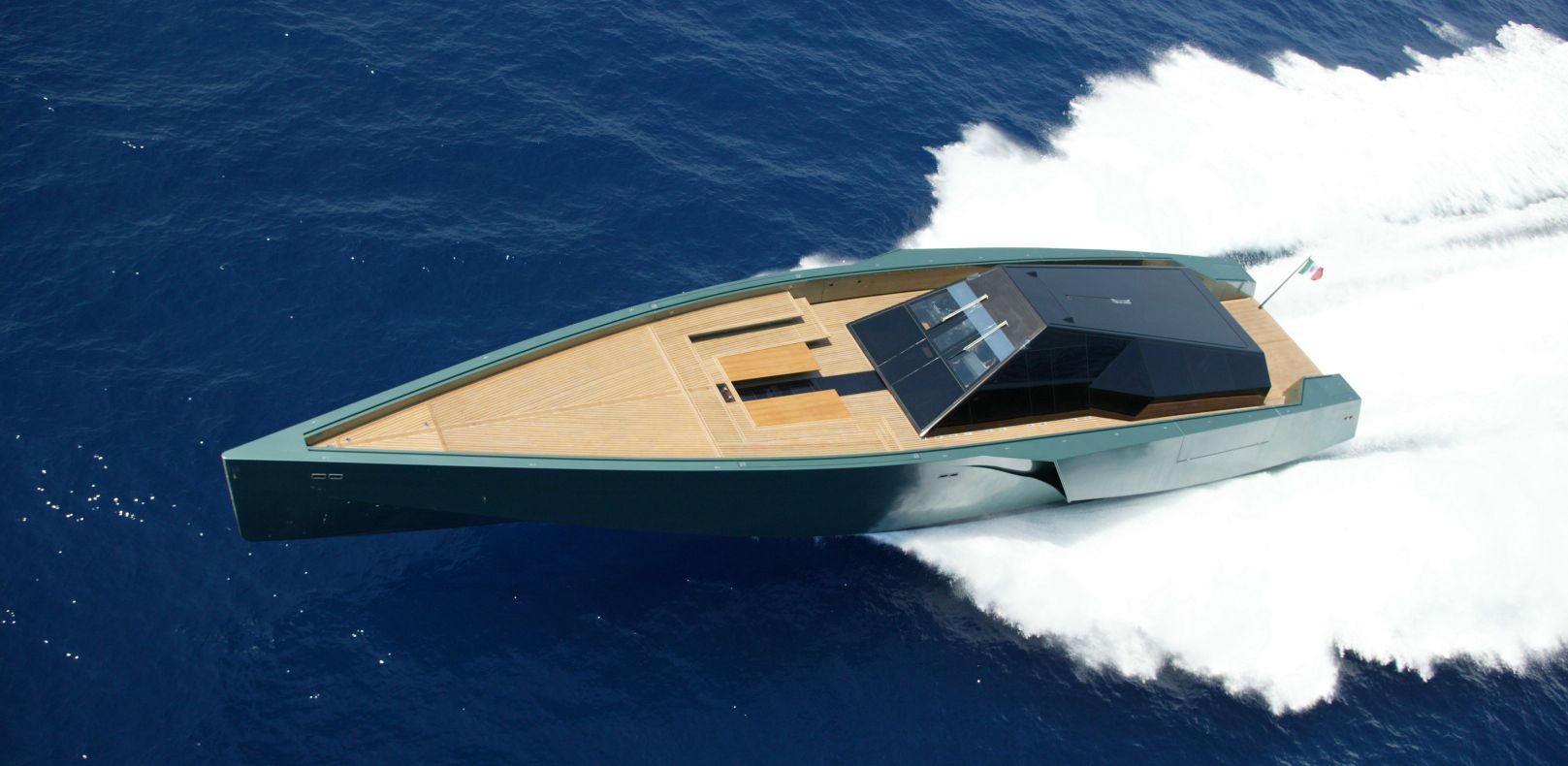
118 WallyPower Yacht… The Majesty of the See
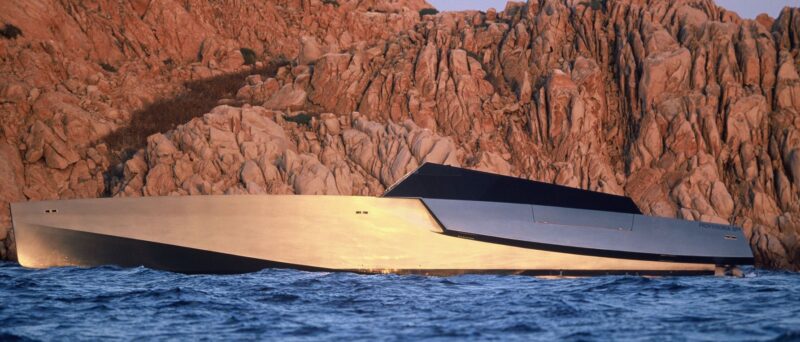
The 118 WallyPower yacht is, to put it in the briefest terms, an undisputed masterpiece. Christened the “Galeocerdo”, it has grabbed the eye of all who see its dark visage, and though its appearance alone is, to say the very least, impressive, the finer details are just as incredible. You could scour the excellent yacht harbours of Monaco or Abu Dhabi, glimpse all their seafaring wonders and yet fail to spot something that carries the same honed, dramatic presence. Beneath the exterior lies three gas turbines. These turbines pump out a gargantuan 5,600 bhp, and each drives a Rolls Royce KaMeWa Waterjet. A 370 bhp diesel engine aids the two jets that help steer the vast craft. Overall, the 118 WallyPower rockets across the waves with a combined output of 16,800 bhp. Such colossal power bolts the yacht to a top speed of 60 knots or 70 mph. Such speed is hardly reached even for far smaller boats.
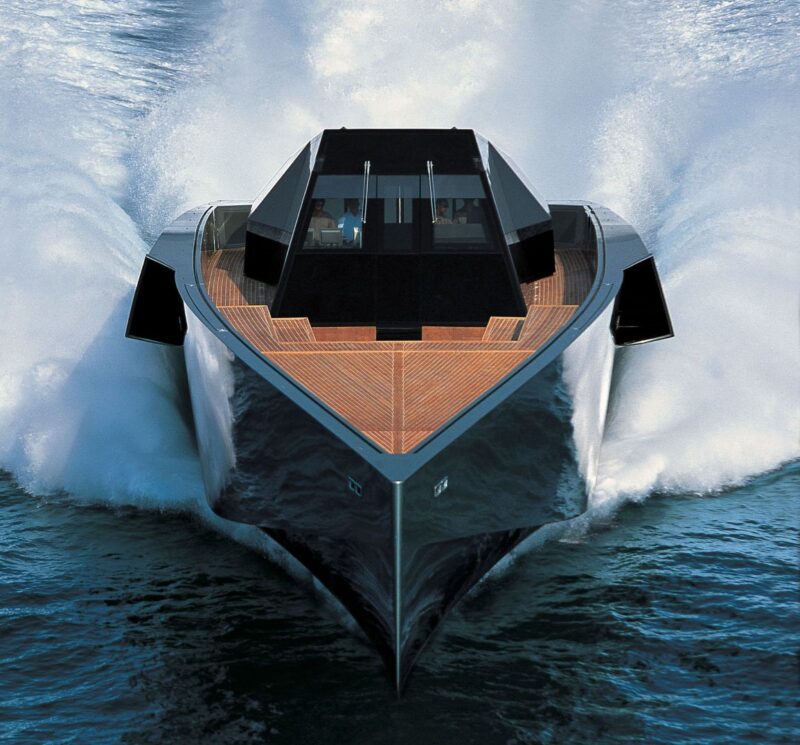
And it can keep up such a speed for a range of 300 nautical miles. However, its power source isn’t totally thanks, as the sharp knife body shape, with smoke testing conducted at Ferrari’s wind tunnel in Maranello, helps cut through the waves like scissors through the cloth.
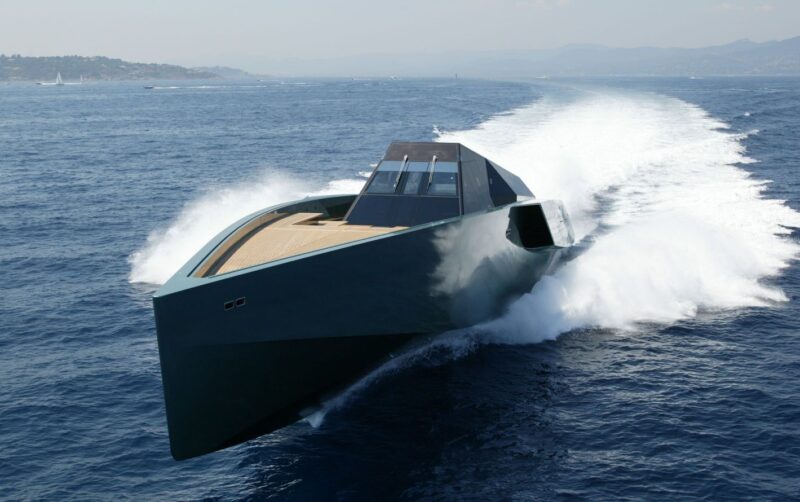
Beyond its mechanical prowess lies the most exquisite interior, where the focus on performance can still be visible. Inside the cabin are carbon fibre window frames, and the whole deck’s superstructure is a carbon frame in the 118 WallyPower’s pursuit of lightness. Even the bath fixtures and the dining tables are made from the carbon in the drive to keep the weight low. Such advanced and clever building ideas allow the boat only to weigh 95 tons.
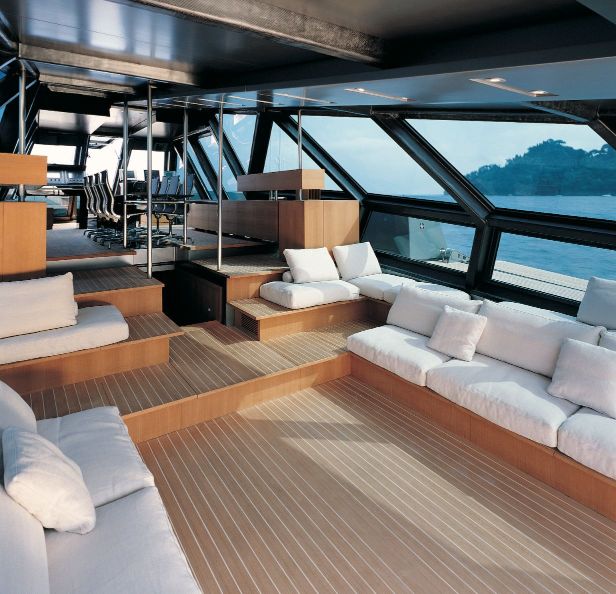
This less is more approach cannot only be seen in its engineering but also in its cabin style. The dining area, deck, navigation and cockpit are all continuous elements, creating an open space that suits the 118 WallyPower’s breezy nature. Comparisons can easily be drawn to that of a swanky, new-age metropolitan apartment or even the understated flamboyance of a spy villain’s lair! The deck’s appearance has a sense of practicality too. Two of the dining tables can be mechanically lowered to offer more room, and the dining and lounge area is placed away from the heat of the engines.
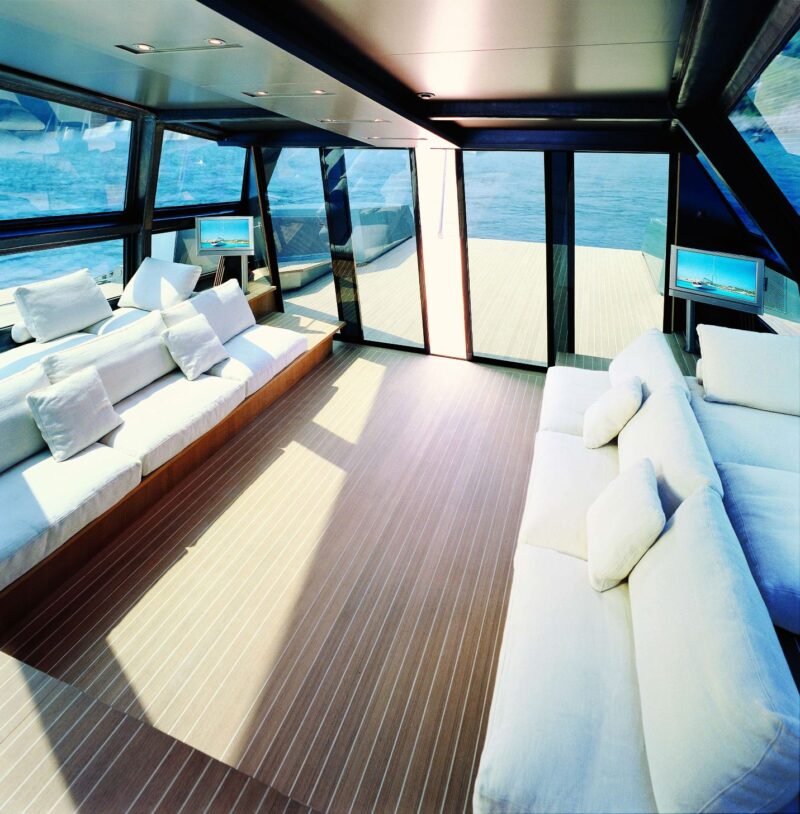
Head deeper inside this gloriously suave vessel, and you’ll find six televisions at your leisure and a small, stainless steel kitchen that wouldn’t look too out of place on the set of science fiction films. Coincidently, the 118 WallyPower did indeed gets its moment in the spotlight by appearing in the 2005 thriller “The Island”.
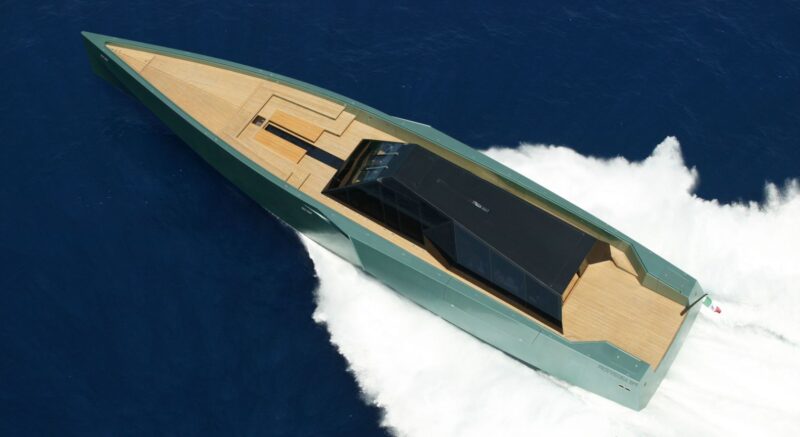
Three bedrooms can be found below the deck. The owner’s stateroom acts as the largest, bearing the comfort of a king-size bed and a pair of en suites, complete with a skylight. A couple of guest rooms are also available, each with a queen-size bed and an en suite. Putting into detail how a yacht perfectly capable of housing six people in refined, palatial splendour truly puts into perspective the technological brilliance in achieving such a low weight and high speed.
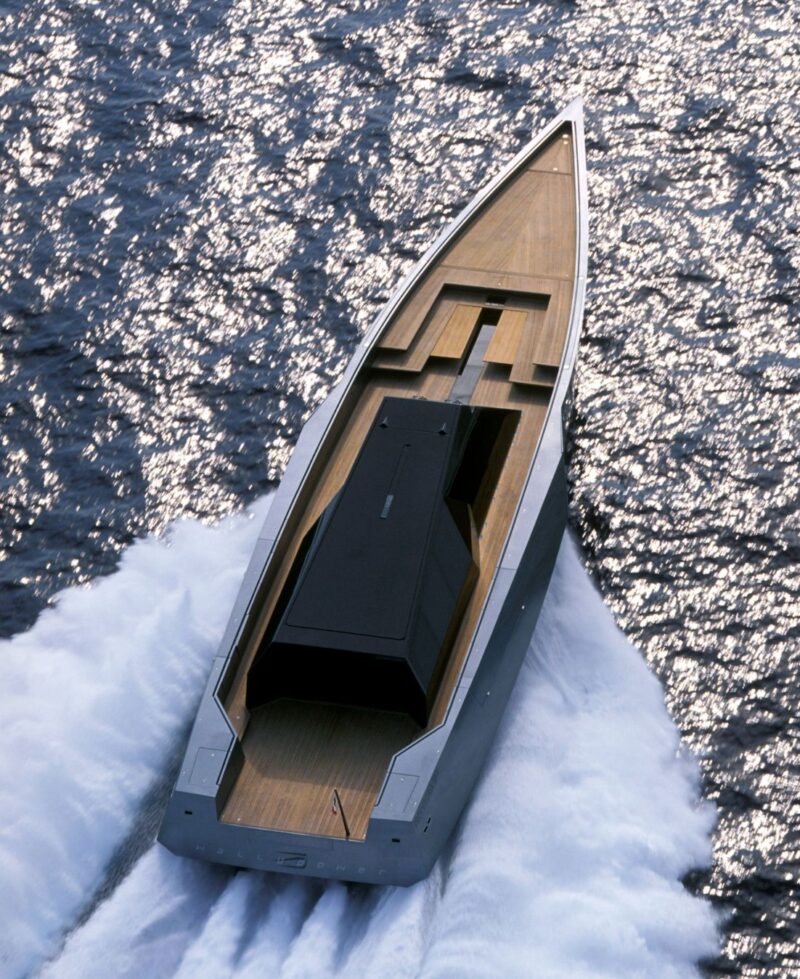
In such a vast world of water, it seems a shame to have such a masterpiece be so rare to find. That being said, perhaps it only fits and remains one of a kind. Currently, the 118 WallyPower is one of a kind and owned by the Kondakji family. That exclusivity level can reinforce its place as an icon on the waves and a marvellous representative of pushing the boundaries of yacht design. Some day there will be faster and more luxurious power yachts than the 118 WallyPower, but they will never make anyone forget their mesmerising presence.
Enjoy even more @ Wally Yacht World
Edit by Roberto Castellucci

You Might Also Like

Rolls-Royce announces new director of global communications
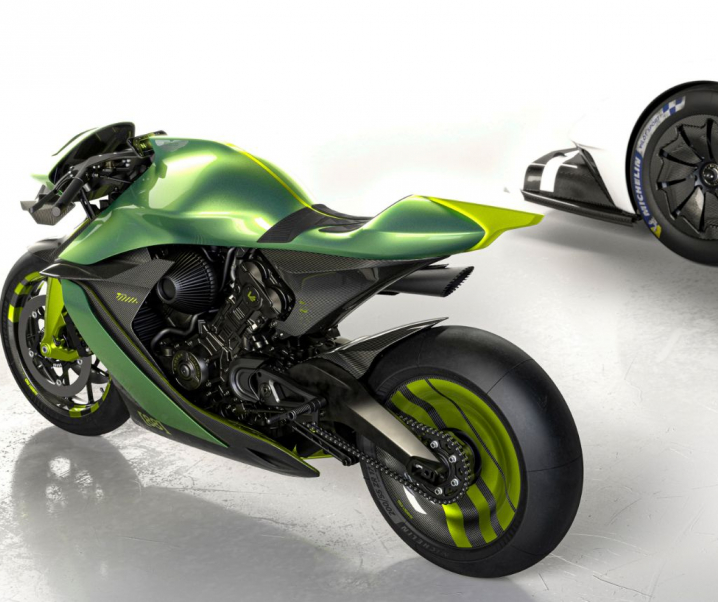
Aston Martin AMB 001 PRO Limited Edition: a new level of hyperbike
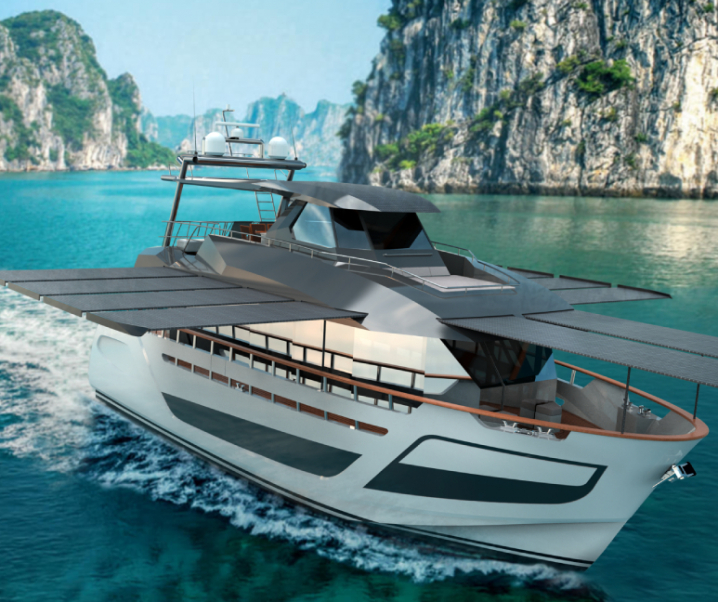
Fabiani Yacht, the best way to invest in Yacht World

Lamborghini Revuelto: Powerfully hybrid
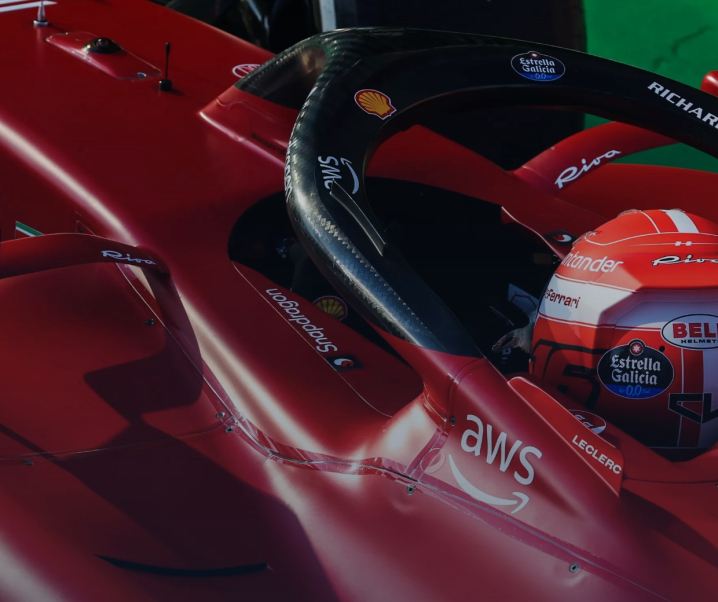
Riva & Ferrari, perfectly together in Formula 1

Lamborghini Urus achieves a new production record… 20,000 units in four years
Platinum partners.

Please go to the Instagram Feed settings page to create a feed.

Lazareth LM 847… $550.000 dream motorcycle

Uncovering secrets of Leonardo da Vinci

Romero Britto between Cubism and Pop Art

Carpegna Suite 92, luxury and excellence signed by Paolo Canto
Korantina homes: leaders in shaping lavish homes.
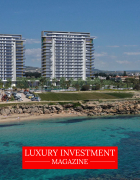
We use cookies to ensure you get the best experience on our website.
WALLYPOWER 118

WallyPower 118 is the fastest motor yacht on water. Three gas turbines generating 16,800 HP power allows the 118 WallyPower to cruise a leisurely 60 knots in flat seas and tackle rough waters with ease. The yacht is narrow and angular in design, driven by three Vericor TF50 gas turbines generating 5,600 horsepower (each driving a Rolls-Royce Kamewa water jet), two steerable outboard and a non-steering booster on the centerline. The steerable water jets also have a diesel engine input for a 370 hp, thus making the ship a Combined Diesel or Gas Turbine configured vessel. If the gas turbine engines are all out, the 118 WallyPower uses 14 gallons for every mile at 60 knots. At this rate it uses 951 gallons an hour.

The hull of the 118 WallyPower is the result of an extensive R&D program including tank testing at the SSPA facility in Gothenburg, Sweden, and smoke testing in the Ferrari Wind Tunnel Facility in Maranello, Italy. It is stable at speed thanks to the deep V (22 degrees) hull shape and a straight stem bow designed to pierce waves.
The 118's deck, cockpit, navigation, dining and saloon areas have been designed as one continuous element. The open space incorporates three areas, from stern to bow: the saloon, the dining/seating area, and the navigation cockpit. There is a 360-degree view from the dining area. The deck of the Wally 118 has a hidden crane and compartment for a tender.

This primarily wood model of the WallyPower 119 features detailed Rolls-Royce Kamewa water jet, with two steerable outboard and a non-steering booster on the centerline. Only the owners of our models can see them, as we do not want to reveal that to copycat builders.
30" long x 9" tall x 8" wide $2,970 Shipping and insurance in the contiguous USA included, other places: $300.
24" long $2,740 Shipping and insurance in the contiguous USA included, other places: $200.
We have another beautiful Wally here: Wallytender 48
Learn more about the Wallypower 118: https://en.wikipedia.org/wiki/118_WallyPower

- Phone: +90 (212) 875 19 08
- E-Mail: [email protected]
- Company Profile
- Company Policy
- Mission and Vision
- Certificates
- Aluminium Windows
- Aluminium Doors
- Aluminium Sliding Elements
- Aluminium Curtain Walls
- Aluminium Skylight Elements
- Aluminium Frames for Safety and Security
- Aluminium Conservatories
- Metal Panel Sheet Claddings
- Aluminium Entrance Frames
- Glass Structures
- Complementary Items
- Lightweight Steel Structures
- Human Resources OPEN
Metropolis Office & Shopping Center
Sheremetyevo airport, new georgian parliament building, be ready to view the world from our frame.
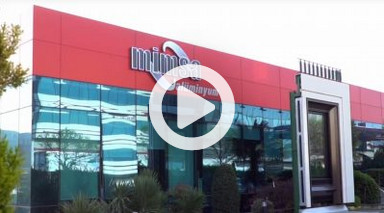
Our Projects
New airport, tobolsk, russia.
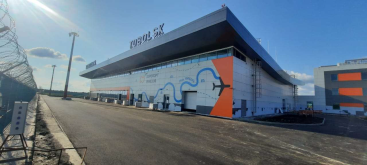
In progress
Rumyantsevo Home City Residential, Russia

200 East 20th Street, USA

St Pancras Campus, London, United Kingdom

Central Bank of Iraq

Poklonnaya 9, Moscow, Russia

Dar Es Salaam Station, Tanzania

Msk Symphony 34 Residential, Moscow, Russia

Morogoro Station,Tanzania

Multifunctional Medical Center, St. Petersburg, Russia

Setun (JK Hide), Moscow, Russia

Donbass Arena, Donetsk, Ukraine

ЖК FORIVER, Moscow, Russia

AFI PARK, Moscow, Russia

Paveletskaya Plaza, Moscow, Russia

Upside Berlin, Germany

Nobu Hotel London Portman Square, London, United Kingdom

Perrymount Road, London, United Kingdom

Nusr-ET Restaurant, Knightsbridge, London, United Kingdom

Istanbul Grand Airport, Turkey

New Georgian Parliament Building, Georgia

Anthill Residence, Istanbul, Turkey

Arcus III Office Center, Moscow, Russia

168-176 Shoreditch High Street, London, United Kingdom

Apex House, London, United Kingdom

Addlestone Town Centre, London, United Kingdom

Dream Island, Moscow, Russia

Skolkovo Business Center ‘Gallery’, Moscow, Russia

Cisco IT Skolkovo, Moscow, Russia

Studio Stage ‘Mosfilm’, Moscow, Russia

Sheremetyevo Airport, Moscow, Russia

Varobevskoe Housing, Moscow, Russia

Tushino Housing, Moscow, Russia

Yasniy Housing, Moscow, Russia

One Trinity Place (2nd Phase), St. Petersburg, Russia

Trinity Place, St. Petersburg, Russia

Action 44, Moscow, Russia

White Gardens, Moscow, Russia
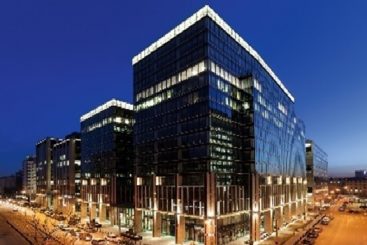
I’m Moscow, Russia

Metropolis Office & Shopping Center, Moscow, Russia

Mayak Housing, Moscow, Russia

Dostoyanie Housing

Nasledie Housing 1

Nasledie Housing 2

Nasledie Housing 3

Life Botanic Garden Residential Complex

K2 Business Park, Moscow, Russia

Prisma Business Center

V-House Housing

Kuntsevo Office Complex

House of Justice
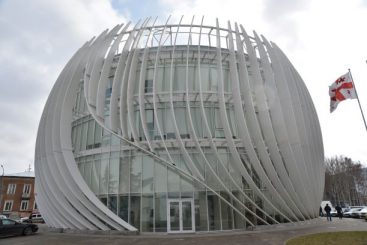
Algoritm Business Center, Moscow, Russia

Demidov Business Center

Rublevo Park Housing

Novopetrovskaya Shopping Center

Shopping-entertainement Complex ‘Kaleidoskop’

Barrikadnaya Bank Building

Beyoglu Loft
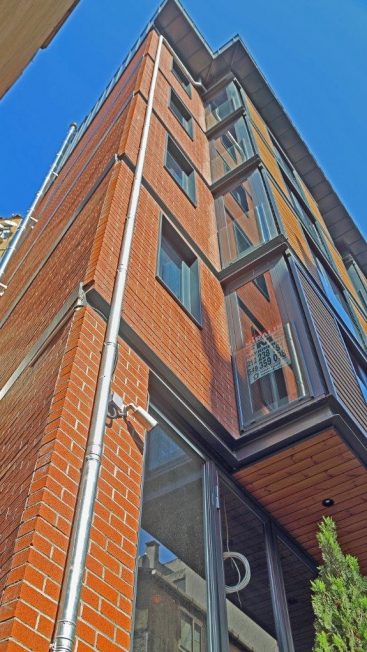
Radisson Blu, Istanbul

Sutluce Office
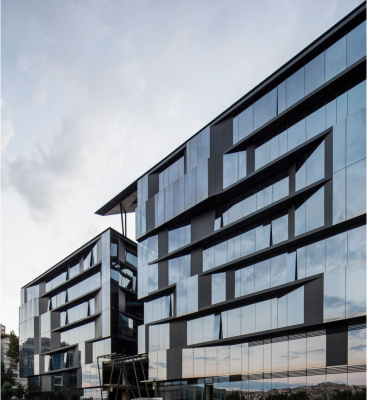
Information Center, Istanbul

Strange Glow Over Moscow Skies Triggers Panic as Explosions Reported
B right flashes lit up the night sky in southern Moscow in the early hours of Thursday morning, new footage appears to show, following reports of an explosion at an electrical substation on the outskirts of the city.
Video snippets circulating on Russian-language Telegram channels show a series of flashes on the horizon of a cloudy night sky, momentarily turning the sky a number of different colors. In a clip shared by Russian outlet MSK1.ru, smoke can be seen rising from a building during the flashes lighting up the scene.
Newsweek was unable to independently verify the details of the video clips, including when and where it was filmed. The Russian Ministry of Emergency situations has been contacted via email.
Several Russian Telegram accounts said early on Thursday that residents of southern Moscow reported an explosion and a fire breaking out at an electrical substation in the Leninsky district, southeast of central Moscow.
Local authorities in the Leninsky district told Russian outlet RBC that the explosion had happened in the village of Molokovo. "All vital facilities are operating as normal," Leninsky district officials told the outlet.
The incident at the substation in Molokovo took place just before 2 a.m. local time, MSK1.ru reported.
Messages published by the ASTRA Telegram account, run by independent Russian journalists, appear to show residents close to the substation panicking as they question the bright flashes in the sky. One local resident describes seeing the bright light before losing access to electricity, with another calling the incident a "nightmare."
More than 10 villages and towns in the southeast of Moscow lost access to electricity, the ASTRA Telegram account also reported. The town of Lytkarino to the southeast of Moscow, lost electricity, wrote the eastern European-based independent outlet, Meduza.
Outages were reported in the southern Domodedovo area of the city, according to another Russian outlet, as well as power failures in western Moscow. Electricity was then restored to the areas, the Strana.ua outlet reported.
The cause of the reported explosion is not known. A Telegram account aggregating news for the Lytkarino area described the incident as "an ordinary accident at a substation."
The MSK1.ru outlet quoted a local resident who speculated that a drone may have been responsible for the explosion, but no other Russian source reported this as a possible cause.
Ukraine has repeatedly targeted Moscow with long-range aerial drones in recent months, including a dramatic wave of strikes in late May.
On Sunday, Moscow Mayor Sergei Sobyanin said the region's air defense systems had intercepted an aerial drone over the city of Elektrostal, to the east of Moscow. No damage or casualties were reported, he said.
The previous day, Russian air defenses detected and shot down another drone flying over the Bogorodsky district, northeast of central Moscow, Sobyanin said.
There is currently no evidence that an aerial drone was responsible for the reported overnight explosion at the electrical substation in southern Moscow.
Related Articles
- Russian Soldier Bashes Drone With Shovel After Detonation Failure: Video
- Russia Headed for Disappointment in Battles Along Dnieper River: UK
- Ukraine's Military Receives Good News From Multiple NATO Allies
Start your unlimited Newsweek trial

Turn Your Curiosity Into Discovery
Latest facts.

Facts About The Research in Epithalon Properties Overview Analysis

How To Protect Children From Junk Food Marketing
40 facts about elektrostal.
Written by Lanette Mayes
Modified & Updated: 02 Mar 2024
Reviewed by Jessica Corbett

Elektrostal is a vibrant city located in the Moscow Oblast region of Russia. With a rich history, stunning architecture, and a thriving community, Elektrostal is a city that has much to offer. Whether you are a history buff, nature enthusiast, or simply curious about different cultures, Elektrostal is sure to captivate you.
This article will provide you with 40 fascinating facts about Elektrostal, giving you a better understanding of why this city is worth exploring. From its origins as an industrial hub to its modern-day charm, we will delve into the various aspects that make Elektrostal a unique and must-visit destination.
So, join us as we uncover the hidden treasures of Elektrostal and discover what makes this city a true gem in the heart of Russia.
Key Takeaways:
- Elektrostal, known as the “Motor City of Russia,” is a vibrant and growing city with a rich industrial history, offering diverse cultural experiences and a strong commitment to environmental sustainability.
- With its convenient location near Moscow, Elektrostal provides a picturesque landscape, vibrant nightlife, and a range of recreational activities, making it an ideal destination for residents and visitors alike.
Known as the “Motor City of Russia.”
Elektrostal, a city located in the Moscow Oblast region of Russia, earned the nickname “Motor City” due to its significant involvement in the automotive industry.
Home to the Elektrostal Metallurgical Plant.
Elektrostal is renowned for its metallurgical plant, which has been producing high-quality steel and alloys since its establishment in 1916.
Boasts a rich industrial heritage.
Elektrostal has a long history of industrial development, contributing to the growth and progress of the region.
Founded in 1916.
The city of Elektrostal was founded in 1916 as a result of the construction of the Elektrostal Metallurgical Plant.
Located approximately 50 kilometers east of Moscow.
Elektrostal is situated in close proximity to the Russian capital, making it easily accessible for both residents and visitors.
Known for its vibrant cultural scene.
Elektrostal is home to several cultural institutions, including museums, theaters, and art galleries that showcase the city’s rich artistic heritage.
A popular destination for nature lovers.
Surrounded by picturesque landscapes and forests, Elektrostal offers ample opportunities for outdoor activities such as hiking, camping, and birdwatching.
Hosts the annual Elektrostal City Day celebrations.
Every year, Elektrostal organizes festive events and activities to celebrate its founding, bringing together residents and visitors in a spirit of unity and joy.
Has a population of approximately 160,000 people.
Elektrostal is home to a diverse and vibrant community of around 160,000 residents, contributing to its dynamic atmosphere.
Boasts excellent education facilities.
The city is known for its well-established educational institutions, providing quality education to students of all ages.
A center for scientific research and innovation.
Elektrostal serves as an important hub for scientific research, particularly in the fields of metallurgy, materials science, and engineering.
Surrounded by picturesque lakes.
The city is blessed with numerous beautiful lakes, offering scenic views and recreational opportunities for locals and visitors alike.
Well-connected transportation system.
Elektrostal benefits from an efficient transportation network, including highways, railways, and public transportation options, ensuring convenient travel within and beyond the city.
Famous for its traditional Russian cuisine.
Food enthusiasts can indulge in authentic Russian dishes at numerous restaurants and cafes scattered throughout Elektrostal.
Home to notable architectural landmarks.
Elektrostal boasts impressive architecture, including the Church of the Transfiguration of the Lord and the Elektrostal Palace of Culture.
Offers a wide range of recreational facilities.
Residents and visitors can enjoy various recreational activities, such as sports complexes, swimming pools, and fitness centers, enhancing the overall quality of life.
Provides a high standard of healthcare.
Elektrostal is equipped with modern medical facilities, ensuring residents have access to quality healthcare services.
Home to the Elektrostal History Museum.
The Elektrostal History Museum showcases the city’s fascinating past through exhibitions and displays.
A hub for sports enthusiasts.
Elektrostal is passionate about sports, with numerous stadiums, arenas, and sports clubs offering opportunities for athletes and spectators.
Celebrates diverse cultural festivals.
Throughout the year, Elektrostal hosts a variety of cultural festivals, celebrating different ethnicities, traditions, and art forms.
Electric power played a significant role in its early development.
Elektrostal owes its name and initial growth to the establishment of electric power stations and the utilization of electricity in the industrial sector.
Boasts a thriving economy.
The city’s strong industrial base, coupled with its strategic location near Moscow, has contributed to Elektrostal’s prosperous economic status.
Houses the Elektrostal Drama Theater.
The Elektrostal Drama Theater is a cultural centerpiece, attracting theater enthusiasts from far and wide.
Popular destination for winter sports.
Elektrostal’s proximity to ski resorts and winter sport facilities makes it a favorite destination for skiing, snowboarding, and other winter activities.
Promotes environmental sustainability.
Elektrostal prioritizes environmental protection and sustainability, implementing initiatives to reduce pollution and preserve natural resources.
Home to renowned educational institutions.
Elektrostal is known for its prestigious schools and universities, offering a wide range of academic programs to students.
Committed to cultural preservation.
The city values its cultural heritage and takes active steps to preserve and promote traditional customs, crafts, and arts.
Hosts an annual International Film Festival.
The Elektrostal International Film Festival attracts filmmakers and cinema enthusiasts from around the world, showcasing a diverse range of films.
Encourages entrepreneurship and innovation.
Elektrostal supports aspiring entrepreneurs and fosters a culture of innovation, providing opportunities for startups and business development.
Offers a range of housing options.
Elektrostal provides diverse housing options, including apartments, houses, and residential complexes, catering to different lifestyles and budgets.
Home to notable sports teams.
Elektrostal is proud of its sports legacy, with several successful sports teams competing at regional and national levels.
Boasts a vibrant nightlife scene.
Residents and visitors can enjoy a lively nightlife in Elektrostal, with numerous bars, clubs, and entertainment venues.
Promotes cultural exchange and international relations.
Elektrostal actively engages in international partnerships, cultural exchanges, and diplomatic collaborations to foster global connections.
Surrounded by beautiful nature reserves.
Nearby nature reserves, such as the Barybino Forest and Luchinskoye Lake, offer opportunities for nature enthusiasts to explore and appreciate the region’s biodiversity.
Commemorates historical events.
The city pays tribute to significant historical events through memorials, monuments, and exhibitions, ensuring the preservation of collective memory.
Promotes sports and youth development.
Elektrostal invests in sports infrastructure and programs to encourage youth participation, health, and physical fitness.
Hosts annual cultural and artistic festivals.
Throughout the year, Elektrostal celebrates its cultural diversity through festivals dedicated to music, dance, art, and theater.
Provides a picturesque landscape for photography enthusiasts.
The city’s scenic beauty, architectural landmarks, and natural surroundings make it a paradise for photographers.
Connects to Moscow via a direct train line.
The convenient train connection between Elektrostal and Moscow makes commuting between the two cities effortless.
A city with a bright future.
Elektrostal continues to grow and develop, aiming to become a model city in terms of infrastructure, sustainability, and quality of life for its residents.
In conclusion, Elektrostal is a fascinating city with a rich history and a vibrant present. From its origins as a center of steel production to its modern-day status as a hub for education and industry, Elektrostal has plenty to offer both residents and visitors. With its beautiful parks, cultural attractions, and proximity to Moscow, there is no shortage of things to see and do in this dynamic city. Whether you’re interested in exploring its historical landmarks, enjoying outdoor activities, or immersing yourself in the local culture, Elektrostal has something for everyone. So, next time you find yourself in the Moscow region, don’t miss the opportunity to discover the hidden gems of Elektrostal.
Q: What is the population of Elektrostal?
A: As of the latest data, the population of Elektrostal is approximately XXXX.
Q: How far is Elektrostal from Moscow?
A: Elektrostal is located approximately XX kilometers away from Moscow.
Q: Are there any famous landmarks in Elektrostal?
A: Yes, Elektrostal is home to several notable landmarks, including XXXX and XXXX.
Q: What industries are prominent in Elektrostal?
A: Elektrostal is known for its steel production industry and is also a center for engineering and manufacturing.
Q: Are there any universities or educational institutions in Elektrostal?
A: Yes, Elektrostal is home to XXXX University and several other educational institutions.
Q: What are some popular outdoor activities in Elektrostal?
A: Elektrostal offers several outdoor activities, such as hiking, cycling, and picnicking in its beautiful parks.
Q: Is Elektrostal well-connected in terms of transportation?
A: Yes, Elektrostal has good transportation links, including trains and buses, making it easily accessible from nearby cities.
Q: Are there any annual events or festivals in Elektrostal?
A: Yes, Elektrostal hosts various events and festivals throughout the year, including XXXX and XXXX.
Was this page helpful?
Our commitment to delivering trustworthy and engaging content is at the heart of what we do. Each fact on our site is contributed by real users like you, bringing a wealth of diverse insights and information. To ensure the highest standards of accuracy and reliability, our dedicated editors meticulously review each submission. This process guarantees that the facts we share are not only fascinating but also credible. Trust in our commitment to quality and authenticity as you explore and learn with us.
Share this Fact:
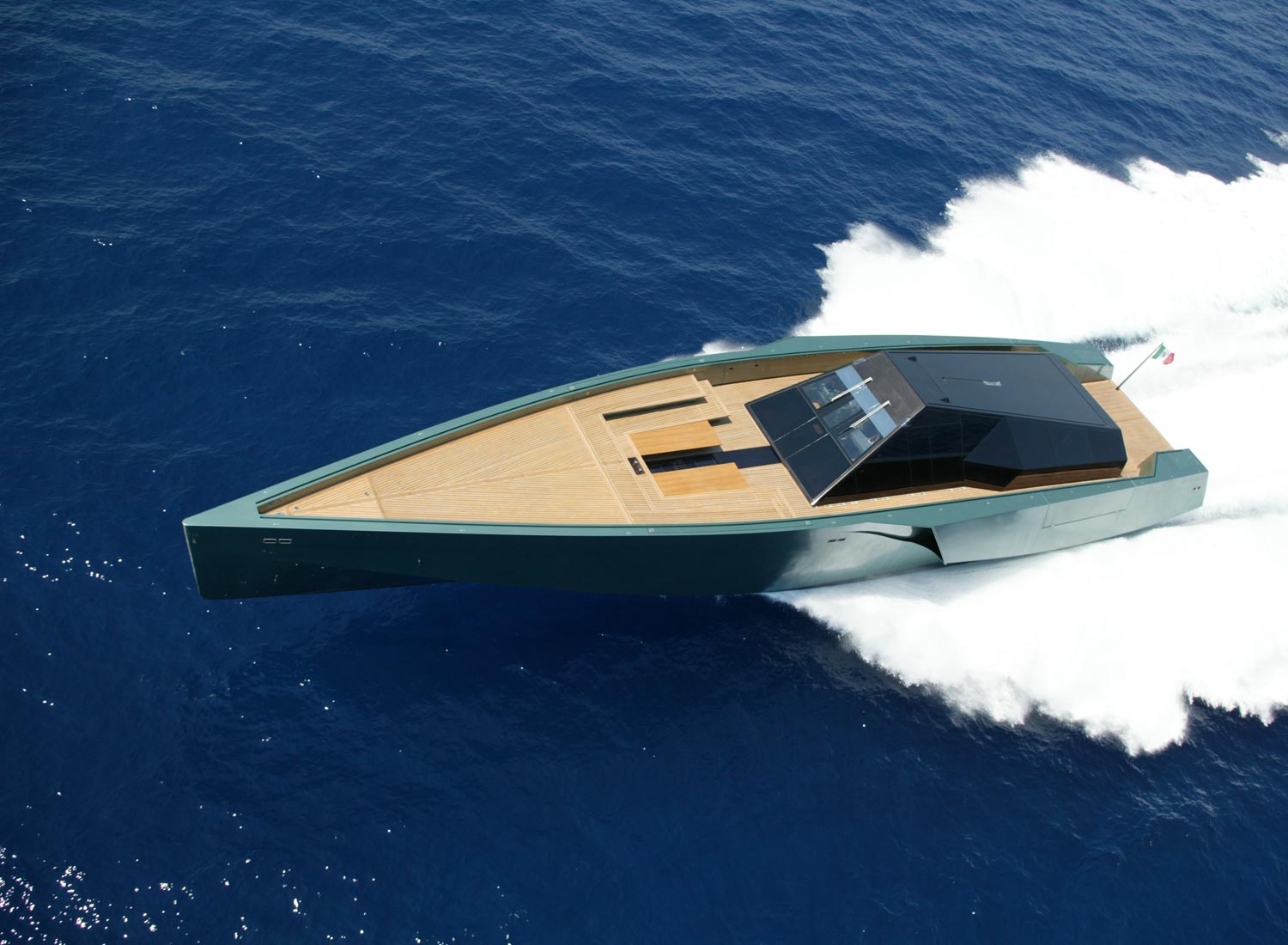
118 WallyPower, christened Galeocerdo, is a 118-foot (36 m) luxury motor yacht with a maximum speed of 60 knots (69 mph; 110 km/h), designed by Lazzarini Pickering Architetti, produced by Wally Yachts. [1] The yacht is narrow and angular in design with black glass housing, driven by three Vericor TF50 gas turbines generating 5,600 horsepower ...
The 118 WallyPower's gas turbines deliver 17,000hp, and diesel is used for manoeuvring and cruising at night at up to 10 knots. 'With the two diesels you have a great range - 1,800 miles - while if you went with the gas turbines at 40 to 60 knots the range is 400 to 500 miles, no more.'. This brings up the subject of sustainable power ...
The WallyPower 118, is this the fastest Superyacht?This iconic stealth carbon fibre superyacht produces 16,800 mHP through three gas turbines with waterjets ...
The WallyPower builds on the soft beige of teak and the pure black of carbon fiber to create a contrast complemented by loose cushions and modern furnishings in the same hues. The WallyPower 118's design consists of sharp lines and a vertical bow. Courtesy Wally Yachts. The WallyPower has three en suite queen-berth staterooms below, the ...
Apr 25, 2003. The futuristic-looking 118 is exactly what yachtsmen have come to expect of Wally, which turned the sailing world on its ear several years ago with decidedly different, angular, speedy-looking craft. The trend continues with the new line of power yachts, of which the 118 is the largest thus far—in fact, according to Wally, the ...
The 118 WallyPower is the largest motor yacht produced by the famous Monegasque shipyard Wally Yachts. It was built in the early 2000's according to the drawings of Luca Bassani for a client who wanted a motor yacht inspired by the 27 m sloop built by the shipyard and with the Argentinean naval architect Frers, called Tiketitan.
Although conceived as a production yacht, reportedly only one was ever built. The price at the time? An impressive £17 million. 118 Wallypower specifications. Year: 2004 LOA: 118ft 1in (36.0m) Beam: 29ft 6in (9.0m) Power: 16,800hp Top speed: 65 knots Price: £17 million Cool rating: Absolute zero (-273° C)
36-meter motor yacht Wally Yachts 118 Wallypower was built in 2002 at the Wally Yachts shipyard. The yacht is maintained and operated by 6 crew members. Characteristics of the superyacht 118 Wallypower. Main Features. Length, m. 36. Beam, m. 9. Draft, m. 1.4. Tonnage and capacity. Displacement, t. 95. Fuel Capacity (liters) 22000.
If Wallygator, the first of Luca Bassani's brainchildren, was a breath of fresh air when it appeared on the sailing scene in the waning years of the last century, the Wallypower 118 motoryacht is a full gale.On the outside, she combines elements of Marcello Gandini's masterpiece Lamborghini Countach of the middle 1980s and the U.S. Air Force Stealth Fighter.
Motor yacht Wallypower 118 is easily one of the most distinctive vessels on the water with her unique and striking exterior design. Capable of reaching high cruising speeds, her design was the result of extensive development and research that included exhausting testing. She has a steeply angled V-shaped and a stand-out deckhouse that crowns ...
The impressive three gas turbine Vericor TF50 diesel engines produce 17,000 horsepower, propelling the WallyPower 118 yacht Galeocerdo to the amazing top speed of over 60 knots. Yacht Accommodation. A total number of 6 guests are offered maximum comfort and luxury aboard WallyPower 118 superyacht Galeocerdo. There is also accommodation for an ...
So much so, in fact, that the 118 WallyPower recently won the MYDA, the Millennium Yacht Design Award organised by Seatec (the yachting and shipping technology show of Carrarafiere) for the ...
The 118 WallyPower is one of the most eye-catching yachts in today's luxury boating market, created by the Monaco-based Wally Yachts. It is narrow and angular in design with black glass housing. It is 118 feet long and is capable of reaching speeds as fast as 60 knots (70 mph, 110 km/h). It is capable of this feat due to three Vericor TF50 ...
And I could point to any number of his designs—from the iconic flush-deck sailing yachts to the one-of-a-kind 118 Wallypower—to back that claim up. WHY200 has massive amounts of space.
Wally Yacht, based in Monte Carlo, Monaco, is a world-renowned designer of high-speed sailing and power yachts. The 118-foot yacht will feature three TF50 gas turbines in a Combined Diesel Or Gas (CODOG) turbine configuration. Two TF50s will be used as side or "wing" engines, with one small auxiliary diesel engine connected to each wing engine.
WallyPower 118 has been gradually revealed through its details. At last, shown in all its magnificence, sailing in the open sea. The change of light throughout the day enhances the details of the yacht's materials and highlights its realism. Above all our aim was to make the viewer feel part of the scene. We've shown the yacht from ...
The Wallypower 118 is a luxury yacht that gained widespread attention after it was featured in the 2005 science-fiction thriller movie "The Island." The yacht was designed and built by the Italian yacht manufacturer Wally Yachts and was launched in 2006. It is an ultra-modern and luxurious vessel that is designed to combine speed, style, and comfort. ...
The 118 WallyPower yacht is, to put it in the briefest terms, an undisputed masterpiece. Christened the "Galeocerdo", it has grabbed the eye of all who see
WallyPower 118 is the fastest motor yacht on water. Three gas turbines generating 16,800 HP power allows the 118 WallyPower to cruise a leisurely 60 knots in flat seas and tackle rough waters with ease. The yacht is narrow and angular in design, driven by three Vericor TF50 gas turbines generating 5,600 horsepower (each driving a Rolls-Royce ...
173 likes, 3 comments - zetovince on March 17, 2024: "Wally 118 WallyPower #lego #legomoc #moc #afol #legostagram #superyacht #yacht #marinelife #legoboat #legoship #motoryacht #powerboat #w ...
Elektrostal, city, Moscow oblast (province), western Russia.It lies 36 miles (58 km) east of Moscow city. The name, meaning "electric steel," derives from the high-quality-steel industry established there soon after the October Revolution in 1917. During World War II, parts of the heavy-machine-building industry were relocated there from Ukraine, and Elektrostal is now a centre for the ...
Established in 1978, Mimsa Aluminium is one of the prominent companies in the industry with over 40 years of industrial experience and aluminum applications which are suitable for any project ranging from large-scaled commercial structures to small-scaled private residences. Company Profile ->.
B right flashes lit up the night sky in southern Moscow in the early hours of Thursday morning, new footage appears to show, following reports of an explosion at an electrical substation on the ...
Known as the "Motor City of Russia." Elektrostal, a city located in the Moscow Oblast region of Russia, earned the nickname "Motor City" due to its significant involvement in the automotive industry.. Home to the Elektrostal Metallurgical Plant. Elektrostal is renowned for its metallurgical plant, which has been producing high-quality steel and alloys since its establishment in 1916.
The Dali, the ship that brought down the Baltimore bridge, ran into a problem with its propulsion system months before the crash
- The ship that struck a key bridge on Tuesday was reported to have an issue with its propulsion in June.
- Records don't say exactly what the problem was, but a note mentioned gauges and thermometers.
- The Dali lost propulsion on Tuesday, but it's unclear if this was related to the June issue.

The 984-foot container vessel that lost power and crashed into the Francis Scott Key Bridge on Tuesday had issues with its propulsion system just months before, records show.
The Singapore-flagged Dali suffered a power outage as it bore down on the I-695 bridge, before ramming into a vital support beam that gave way and caused part of the structure to collapse into the Patapsco River in Baltimore.
"We can confirm that the crew notified authorities of a power issue," Maryland Gov. Wes Moore said in a press conference on Tuesday.
During the blackout, the Dali "experienced momentary loss of propulsion," the Maritime and Port Authority of Singapore said in a statement , citing a report from Synergy Marine, the ship's manager.
The same ship was flagged in June for an issue related to its propulsion system, according to records from an international database of port controls in Asia Pacific.
However, it's still unclear if the deficiency found in June was at all related to what caused the crash on Tuesday.
The issue was reported in San Antonio, Chile on June 27, and listed as a propulsion and auxiliary system deficiency. An attached note reads: "Gauges, thermometers, etc."
Per the records, this problem was not deemed as grounds for the ship to be detained in Chile.
Clay Diamond, the executive director of the American Pilots' Association, told The Washington Post that the Dali lost power at around 1:20 a.m., around eight minutes before the crash.
Pilots on board tried to start an emergency diesel generator to repower the ship and restart electrical systems, he said.
Related stories
But Diamond told USA TODAY that the propulsion didn't appear to kick back in.
"There was still some steerage left when they initially lost power," he said, per the outlet. "We've been told the ship never recovered propulsion."
Authorities and Synergy Marine, headquartered in Singapore, are investigating the cause of the power failure and allision.
The Dali was previously involved in a separate mishap. In 2016, it scraped its hull against a quay in Antwerp , an incident that was attributed to a pilot error.
On Wednesday, Singapore's maritime officials said the Dali had passed previous port inspections and that the June incident was "a faulty monitor gauge for fuel pressure," which was fixed before the ship left port.
When reached for comment, a representative for Synergy Marine referred Business Insider to the Singapore authorities' statement.
The bridge's collapse has triggered a state of emergency in Baltimore, and six members of a small construction crew working on the bridge during the crash are presumed dead. Authorities say officials managed to stop traffic on the bridge before it collapsed.
The Francis Scott Key Bridge was Baltimore's biggest bridge, and the loss of such critical infrastructure will likely cause supply chain issues across multiple industries. Around 11.3 million vehicles use the bridge annually, per the Maryland Transport Authority.
The nearby Port of Baltimore has also been closed to vessels until further notice, with experts telling BI's Dominic Reuter that the closure could halt about $15 million worth of economic activity daily .
This port is also particularly important for the automotive industry because it's a special terminal for wheeled cargo like vehicles and heavy farming equipment.
Coal, gypsum, sugar, paper, chocolate, and ice cream are commonly moved through the Port of Baltimore, BI's Erin Snodgrass reported.
Meanwhile, shares of Maersk , the Danish shipping company that chartered the Dali, dropped as much as 8% in Copenhagen on Tuesday. The firm has declared that its lanes through Baltimore are closed, for now.
March 27, 2023: This story was updated to reflect a response from Synergy Marine and a new MPA statement on the Dali's reported issue with its propulsion system in June.
Watch: The container ship that destroyed the Francis Scott Key Bridge has crashed before
- Main content
- Nuclear fuel cycle
- Key figures
- History of cooperation
- Areas of cooperation
- Office profile
- Procurement standard
- Useful links
- How to become a supplier
- Procurement
- Rosatom in media
- Photo and video
- Rosatom Newsletter
- Anti-corruption policy
© 2008–2024 The State Atomic Energy Corporation ROSATOM

- Rosatom Global presence
- Rosatom in region
- Regional office
- For suppliers
- Preventing corruption
- Press centre
Rosatom starts production of rare-earth magnets for wind power generation
- 05 November, 2020 / 18:04
This site uses cookies. By continuing your navigation, you accept the use of cookies. For more information, or to manage or to change the cookies parameters on your computer, read our Cookies Policy. Learn more

COMMENTS
Your next yacht may be powered with a new, but at the same time old and extensively proven, power system-a diesel electric drive. First used in 1903 to propel the triple-screw Russian tanker Vandal on the Volga River and Caspian Sea, diesel electric propulsion is now used in the most modern cruise ships and in thousands of other commercial vessels.
Oceanvolt offers Hybrid or Electric systems as a power & propulsion option in partnership with many leading monohull boat builders - adding new partners continuously. We also offer repowering solutions for converting away from legacy diesel engines - removing the diesel engine, fuel tanks and exhaust system - cleaning up greasy, smelly engine ...
Diesel Electric Systems have been in use to propel vessels for more than 100 years. Branobel launched the first diesel-electric ship in 1903, and since that day, diesel electric propulsion systems have evolved and today they can be found in all boat sizes and applications.
Volvo Penta has revealed a fascinating insight into its greener future with the launch of its first diesel electric hybrid leisure boat engine. Although still a prototype, it is based on a standard 320hp D4 engine and DPI sterndrive with an electric motor/generator added to the driveline. Speaking exclusively to MBY, sales project manager ...
A diesel-electric propulsion system relies on a running genset to directly power the electric motor that turns the propeller. A hybrid system relies on batteries to power the electric motor, plus an internal-combustion genset to recharge the batteries. One of the promises of a hybrid system is the ability to regenerate electrical power.
A Parallel Hybrid System. EcoDrive is a robust and redundant hybrid electric/diesel propulsion system designed to deliver a multitude of benefits. Originally conceived in conjunction with the HH44, the Parallel Hybrid EcoDrive is a ground breaking industry advancement that we're proud to now offer on all HH Catamaran models. How it works.
The end results are lower emissions and improved fuel performance. In addition, an electric propulsion motor can easily be controlled in terms of speed and be reversed without the need for a large gearbox or transmission. ... It is a 64m hydrogen diesel-electric yacht from Pharos Marine in Egypt. Given the explosive nature of hydrogen and the ...
Diesel-electric marine propulsion has been around for more than a century, going all the way back to Jack Delmar-Morgan's motor yacht Mansura in 1912, but none of the current marine-specific hybrid drives are anywhere near the maturity of BAE Systems' technology, which has been deployed in more than 14,000 vehicles worldwide over the last ...
Marine Diesel Electric Engines. With a decade of experience and hundreds of diesel electric packages in operation globally, Cummins is one of the pioneers in diesel electric propulsion. The company has developed in-house capability to design genset packages and support diesel electric vessels, long offering custom packages through the Cummins ...
288. Vermeulen replaced the diesel-electric system with twin 160-horsepower Volvo diesels. At 9.1 knots, they together burned 2.2 gallons per hour, considerably less than the 3 gallons per hour that the Glacier Bay system burned at the same speed. With the twin Volvos maxed out at 3,900 rpm, the boat made 24.5 knots.
Siemens diesel-electric propulsion, namely the Siship EcoProp, is on board the MY Vanadis superyacht, a 31-metre vessel built by CCN ... It is the very first motor yacht completely made in Italy to achieve this result. The fourth model in the 'Fuoriserie' collection - the tailor-made line from the Carrara shipyard - Vanadis owes its ...
The Arcona 380Z is a standard production yacht that has been adapted for electric propulsion. Note the increased solar panel surface area with soft panels bonded to the sails. Credit: Jukka Pakainen. A modern electric yacht can come in all shapes and sizes, from the latest high-tech speed boats with recently developed high-performance electric ...
MAN Energy Solutions integrated its in-house core technologies to create the dual fuel marine MAN L+V51/60DF engine that converts liquid fuel, natural gas or a combination of both into electric or mechanical propulsion power. High-efficient variant/high-power. variant 500 - 514 rpm/500 - 514 rpm. 6,300 - 16,800 kW/6,900 - 16,100 kW.
And with advances storage systems, we are now able to supply Hybrid Systems using Wärtsilä's Management Systems to increase the vessel's efficiency. Our innovative diesel-electric propulsion systems provide For propulsion power on board up to 28 MW of power for a wide variety of vessels with cruise liners, ferries, pipe layers and special ...
Siemens diesel-electric propulsion, namely the Siship EcoProp, is on board the MY Vanadis superyacht, a 31-metre vessel built by CCN (Cerri Cantieri Navali). The system provides that the propulsion may rely on traditional diesel engines to navigate at cruising speed or rather on electric motors for navigation at low speed, thus increasing the ...
Zennstrom shared his views on the future of electric racing in a CNN article in 2018: "Having gone through the design, build and initial test cycle there is no doubt to me that the future for racing yachts is electric propulsion. It's lighter, less drag, quieter, and most importantly it is environmentally friendly.".
Improved Quality of Life on Board. Reduce environmental exhaust and water pollution. Drastically reduce your vessels yearly CO2 emissions. Mooring and swimming in a bay without any gas emissions and noise. Silent and zero-emission departure from mooring and cruise in medium-range. Cabins are noise-free in Zero-Emission or Diesel-Electric Mode ...
Use case Yacht hybrid propulsion Hybrid solutions are among the keystones of a sustainable future. The power of a diesel engine, which allows top speeds, is combined with the sustainable, emission-and vibration-free comfort of an electric drive.
As the name suggests the 42 Hybrid is a diesel-electric hybrid boat that genuinely seems to offer the best of both worlds. Its single diesel 440hp Yanmar engine can deliver a top speed of 16 knots from its comfortable semi-displacement hull form, and a range of 600nm at 12-14 knots. This makes for effortless passage-making, even in conditions ...
The hybrid propulsion system will be installed on hybrid propulsion T52 and DOM 133 yachts starting in 2025, with all components already certified by the Lloyd's Register. The new system will be fit for mounting on vessels built with the Bzero hydrogen-based technology. Baglietto recently launched the fifth DOM133 series, named Astera.
Feadship's Strategic Roadmap. Feadship, long an industry leader, has a plan for net-zero CO2 emission and minimal local pollution impact by 2030. Their 84.20-meter full diesel electric yacht ...
March 11, 2024 4:43 PM PT. The nation's first all-electric tug boat has docked at the Port of San Diego and expects to begin emissions-free operations in about a month. Operated by Crowley ...
The yacht has been called the "most environmental-friendly luxury vessel of its kind" as it features a hybrid propulsion system that allows the boat to travel at 12 knots under diesel-electric power, as well as a waste treatment plant and heat recovering systems on board. Its annual running costs are reported to be in excess of $17.5 million .
Loss of ship's power and stiff current may have led to bridge collision, experts say. The container ship Dali after it ran into and collapsed the Francis Scott Key Bridge on Tuesday in Baltimore ...
P3 Electrified Summit. POWER is joining with the P3 infrastructure group at Access Intelligence to present the P3 Electrified Summit.The event brings together electric utilities, energy companies ...
118 WallyPower, christened Galeocerdo, is a 118-foot (36 m) luxury motor yacht with a maximum speed of 60 knots (69 mph; 110 km/h), designed by Lazzarini Pickering Architetti, produced by Wally Yachts. [1] The yacht is narrow and angular in design with black glass housing, driven by three Vericor TF50 gas turbines generating 5,600 horsepower .....
The Dali, the ship that brought down the Baltimore bridge, ran into a problem with its propulsion system months before the crash. Matthew Loh. Mar 26, 2024, 9:14 PM PDT. The cargo ship Dali sits ...
TVEL Fuel Company of Rosatom has started gradual localization of rare-earth magnets manufacturing for wind power plants generators. The first sets of magnets have been manufactured and shipped to the customer. In total, the contract between Elemash Magnit LLC (an enterprise of TVEL Fuel Company of Rosatom in Elektrostal, Moscow region) and Red ...